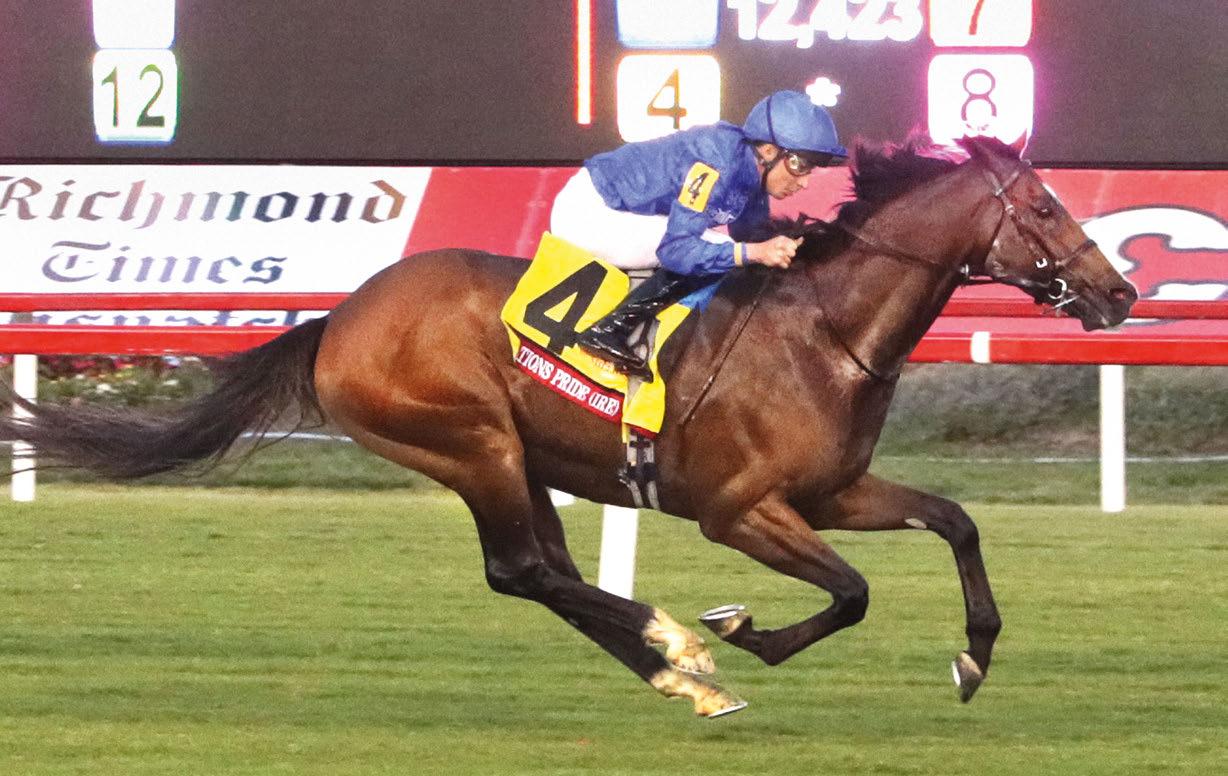
Invincible Spirit - Zenda (Zamindar)
£125,000 1st October Special Live Foal


Invincible Spirit - Zenda (Zamindar)
£125,000 1st October Special Live Foal
Prix Penelope Gr.3, 10½f, Saint-Cloud
Bred by Al Asayl France
Craven Stakes Gr.3, 8f, Newmarket
Bred by Roundhill Stud
1000 Guineas Trial Gr.3, 7f, Leopardstown
Bred by Juddmonte Farms Ltd

Contact Shane Horan, Henry Bletsoe or Claire Curry
+44 (0)1638 731115 | nominations@juddmonte.co.uk www.juddmonte.com
Novice Stakes, 7f, Kempton
Bred by Juddmonte Farms Ltd
Editor: Edward Rosenthal
Bloodstock Editor: Nancy Sexton Design/production: Thoroughbred Group
Editorial: 12 Forbury Road, Reading, Berkshire RG1 1SB editor@ownerbreeder.co.uk www.theownerbreeder.com
X: @TheOwnerBreeder Instagram: theownerbreeder
Advertising: Giles Anderson
UK: 01380 816777
IRE: 041 971 2000 USA: 1 888 218 4430 advertise@anderson-co.com
Subscriptions: Keely Brewer subscriptions@ownerbreeder.co.uk 01183 385 686
The Owner Breeder can be purchased by non-members at the following rates:
1 Year UK £60 Europe £90 RoW £120
The Owner Breeder is owned by the Racehorse Owners Association
Editorial views expressed in this magazine are not necessarily those of the ROA or TBA
Our monthly average readership is 20,000
Racehorse Owners Association Ltd 12 Forbury Road, Reading, Berkshire RG1 1SB Tel: 01183 385680 info@roa.co.uk • www.roa.co.uk

Last month’s Tattersalls Craven Breeze-
Up Sale saw a pair of two-year-olds sell for a combined 3.15 million guineas to Amo Racing and Godolphin but for inspiration on how to compete at racing’s top table without spending a king’s ransom, look no further than two owners featured in this magazine.
Thirty years ago, Ron Huggins reached the summit of the sport when his Double Trigger, trained by Mark Johnston, captured the Gold Cup at Royal Ascot, defeating Sheikh Mohammed’s 1994 St Leger victor Moonax by five lengths under a superb front-running ride by Jason Weaver.
Double Trigger became one of the most popular stayers of his era, also winning both the Goodwood Cup and Doncaster Cup three times during six seasons of racing, while his year-younger brother Double Eclipse was no back number, his victories including the Lonsdale Cup and Prix Vicomtesse Vigier, also chasing home Double Trigger in the 1995 Goodwood Cup, going down by a neck to his sibling in receipt of 21lb.
So how did Huggins manage to buy the brothers for a total of 24,700 Irish punts?
‘‘Like today, I couldn’t afford to buy superstars, so we were looking for a way of competing at a lower price,” he tells Marcus Townend in this month’s Big Interview ( pages 32-37 ). “I have always done my racing out of taxed income.
‘‘What Mark and I discussed was a way to find a Group 1 sire who had produced top-level winners but was out of fashion. Ela-Mana-Mou [Double Trigger’s sire] was in that category. I looked at all the Ela-ManaMous at the Orby Sale.’’
Huggins’ individual approach to identifying talent is still paying off; his current string features progressive threeyear-old filly Spirit Of Jura, a 32,000-guinea purchase trained by Charlie Johnston, who provided record-breaking rider Hayley Turner with her final winner at Southwell in early
Edward Rosenthal Editor

April. We wish Hayley well in the next chapter of her life.
Ian Gosden is another owner whose ability to think outside the box unearthed a quite incredible bargain in the shape of Champion Hurdle heroine Golden Ace.
Gosden studied the catalogue ahead of the Horses-in-Training Sale at Tattersalls in July 2021 – he says it took him 12 hours to go through the pedigrees of all the entries – and settled on a daughter of Golden Horn bred by Meon Valley Stud (see Breeder of the Month, page 83 ).
“I don’t like mares that haven’t run, and I could see the dam [Deuce Again] had won
“It’s possible to find value in a market dominated by a handful of players”
up to 1m6f and the stallion [Golden Horn] had won a Group 1 at a mile and a half. I thought the progeny would stay well,” Gosden says ( Magical Moments, pages 74-75 ).
“When I went into the ring to watch her go through, no-one was bidding, so I thought I’d have a go.
“I didn’t even know her sire had won the Derby. I was just looking at the calibre of the wins rather than the name of the race.”
Gosden splashed out 12,000 guineas on Golden Ace, who had earned over £400,000 before her assault on Punchestown’s Champion Hurdle. Proof, if it was needed, that it’s still possible to find value in a sales market dominated by a handful of major players under both codes.


CHAMPION 2024 FIRST SEASON SIRE

Jan Steen yo debut winner by 4½ lenghts
Royal Ascot bound
Novice 3yo winner
Impressive winner on 3yo debut ets
Bela Sonata
Maiden 3yo winner by 2 lengths
Highly regarded by trainer
Gr.3 Prix Sigy
Smart sprinter targeting the Gr.1 Commonwealth Cup
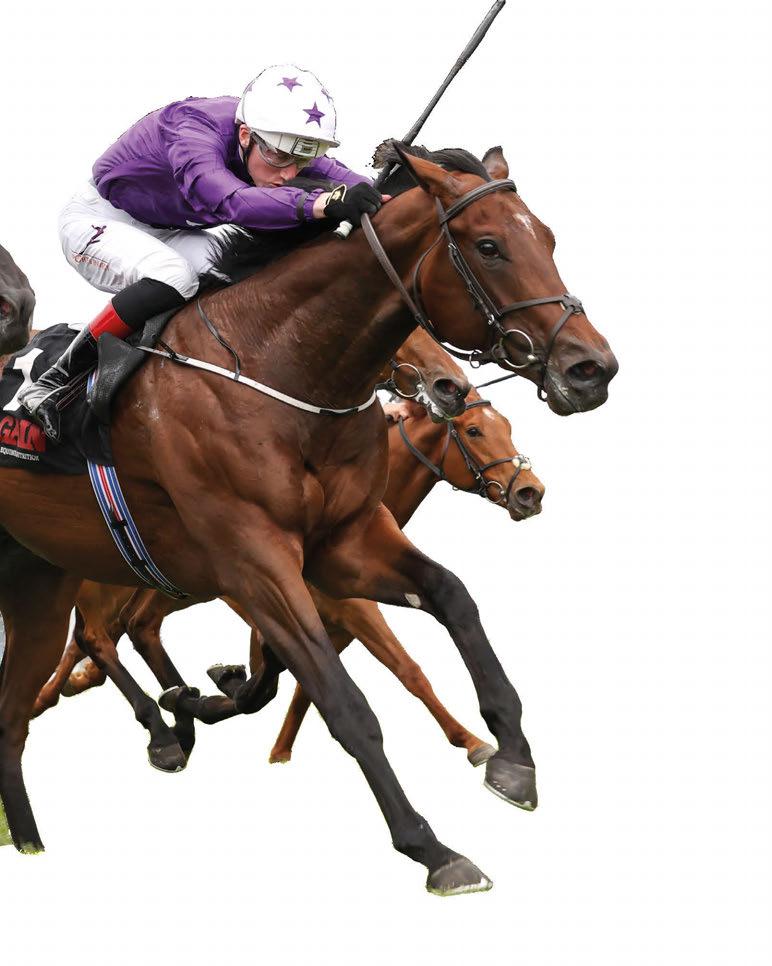
Maiden 3yo winner
FEE: £8,000 1st oct slf





Redweld Stables are leading designers, manufacturers and installers of stables and other equine products in Ireland and the UK. Ofering our designs in standard and bespoke sizes, we cater directly to the individual needs of our clients.
We pride ourselves on our reputation for the quality of our designs and workmanship and achieving customer satisfaction through our completed installations.
• Internal Stables
• External Stable Blocks
• American Barns
• Stable Fronts
• Stable Dividers
• Stable Doors
• Stable Windows
• Hayracks
• Swivel Feeders
• Washbays
• Equine Feeding Barriers
• Equine Stocks
For mid to large-sized projects, we ofer a turnkey design & build service. One point of contact to manage and deliver your project, efciently, on time and on budget. We are happy to ofer a 5-year warranty on all our products.

Scan here to visit us



After a thrilling conclusion, the National Hunt season is now behind us and high-class Flat action is coming thick and fast – unfortunately it is hard to be so positive about events off the track, with progress painfully slow on both key funding decisions and a new commercial agreement around the distribution of the sport’s finances.
Just under 12 months ago there was real momentum around the prospect of a new levy deal, with genuine hope that an agreement could be reached before the summer. We all know what happened and to be frank there has been no progress since the election starting gun was fired. The industry needs to reset its strategy when it comes to engaging with both the Betting and Gaming Council and the government.
The online casino businesses are firmly in the crosshairs when it comes to problem gambling concerns; racing must establish clear air between our sport, with its betting based on skill, and the online apps. For too long we have been lumped in with slots and casino games when it comes to policy around gambling, and this has hindered not only betting revenues but also our ability to negotiate a sound and lasting levy solution.
There has also been continued speculation around changes to gaming tax rates. The government is obviously looking at ways to balance the books and online gaming could be seen as a target. British racing contributes a huge amount to the public exchequer via direct and indirect taxes as well as being a key contributor to the rural economy. There could be a scenario where a tweak to actual tax rates and how they are levied could well provide a positive solution for racing. However, the danger is ever present that targeting gambling has knock-on consequences, therefore a strong lobbying campaign is essential over the coming weeks.
Positive conversations have been had with racecourses and the RCA over several months in respect to establishing a workable partnership agreement. There is now an absolute necessity to get something agreed to ensure that, as we go forward, the various parties are aligned. Establishing a mechanism that ensures not only a sensible commitment to current prize-money contributions but also guarantees that any uplift in inward investment is distributed amongst the parties is crucial.
The major aim is to future-proof the distribution agreements sooner rather than later to avoid further acrimony. There remains a widespread underlying mistrust of the real cash flows being generated by racecourses through media rights deals, and whilst the Thoroughbred Group has had access to many racecourse P/L accounts under non-disclosure agreements, this will not be satisfied until a robust agreement is in place. Establishing
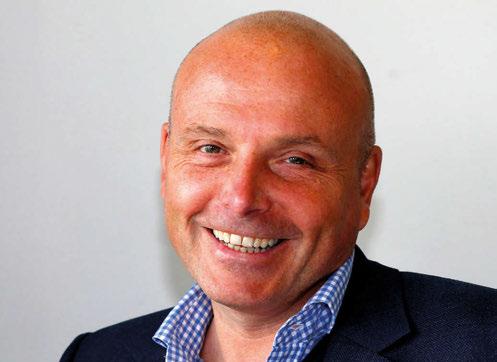
a guaranteed base prize-money contribution with a share in the upside should be within the powers of the RCA, BHA and Thoroughbred Group.
There has been a fantastic response to the recent ROA owners’ survey, which has been sent to members as well as non-member owners. Racing has suffered over the years without proper engagement with its core funding group, namely owners of all types. The piece of work currently underway in conjunction with the BHA around owners is already producing some very informative feedback. The results from the survey will provide us with our first data-driven insights in several years. Finally, the industry will have the information we need to tackle the decline
“Establishing a guaranteed prize-money contribution with a share in the upside should be in our power”
in ownership. Prize-money will remain the number one concern, however, with different ownership types, real data-driven information is crucial to tailor the product and experiences accordingly.
This will be the last column before Lord Allen takes on the mantle of Chair of the British Horseracing Authority. Lord Allen has had a stellar and varied business career and is enthusiastic that he can make a real difference to the BHA itself and the wider industry. A big job no doubt, but there is a lot to work with. The best racing in the world, the best participants, daily media coverage, two dedicated television channels, terrestrial TV coverage and some of the biggest sporting events on the planet. I wish Lord Allen the best and look forward to working with him from next month onwards.

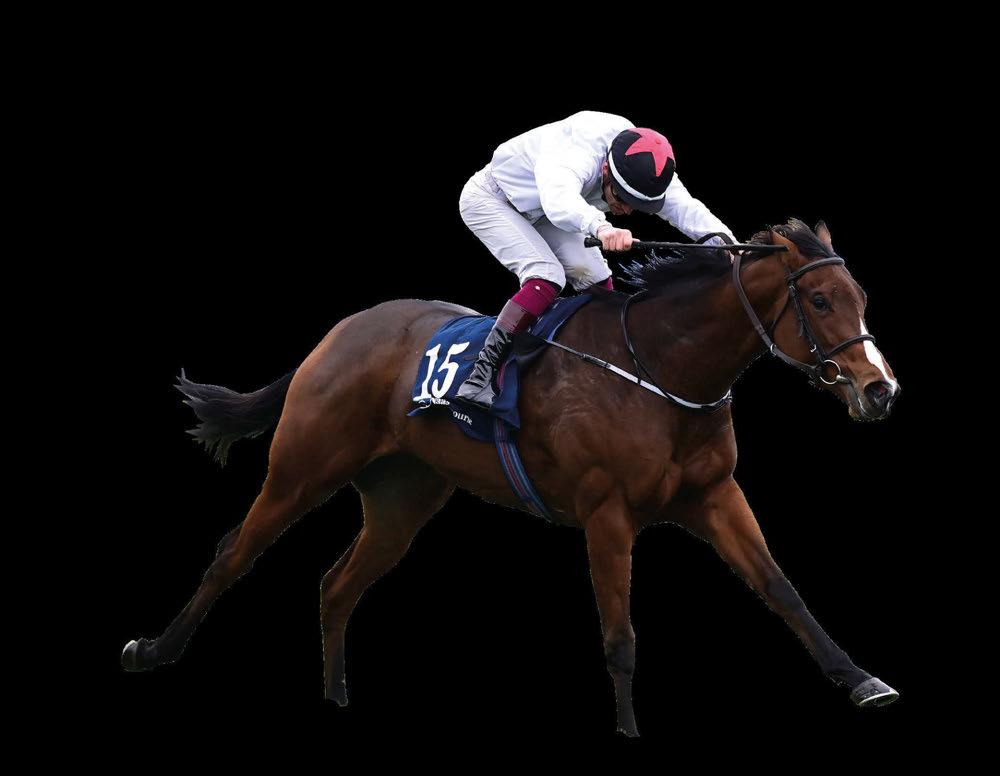
We need to talk about the foal crop and just like Lionel Shriver’s book We Need to Talk About Kevin, it makes for alarming reading. The PwC Economic Impact Study published in 2022 by the TBA modelled foal births using data that was relevant and current, forecasting by 2051 a mid-range number of 3,263 foals should be the expectation.
In 2024 the TBA decided it was important that this piece of work was revisited – this now shows that 3,263 foals will likely become a reality by 2026 or 2027 at the latest. This would represent a near 30% decline upon the 2022 number of 4,601. In short, what was once forecast to take 29 years has accelerated to become fact in five years!
This may not be the end of it either, as the TBA, encouraged by the HBLB who after last year’s Book 1 Sale stated, “the industry must explain itself”, commissioned an independent analysis of the 2024 sales season with particular focus upon British breeders and their product. The numbers delivered by the premier yearling sale masked the financial realities of breeding and for the TBA to continue to make the strongest case for support on behalf of the breeding industry, accurate data is essential.
The report discovered a far worse position than most realised and the headlines alone underline the very serious challenge the British breeding sector faces as it fights for its existence:
• 71% of all yearlings sold failed to recover their costs
• 5% of yearlings offered (121 yearlings) accounted for 40% of total turnover
• The top 25 buyers accounted for 61% of that turnover
• 2024 was an exceptional year as the top two buyers represented 21% of turnover against the previous year’s top two buyers at 15%
• Of the top 20 buyers of fillies, only 25% own a UK stud farm (suggesting more family silver going overseas)
The numbers, along with the recent increase in National Insurance and minimum wage costs, inflationary pressures upon every part of the cost base and the uncertainties surrounding inheritance tax, make it inevitable that there will be a further correction in the breeding base and consequent pressure upon the foal crop.
Adding fuel to that fire, the TBA, with Weatherbys’ help, also considered the owner-breeder sector – and here the same trends are in evidence. In 2020, owner-breeders were responsible for 52% of the foal crop; by 2024 this had reduced to 40%, so both roads –commercial and owner-breeder – are leading to the same outcome. Does this matter? Many say that we have too much racing and too many racecourses, and that a restructure is well overdue. The question is at what point does racing lose its relevance to the audience it seeks to attract? In the past five years, betting turnover
Philip Newton Chairman
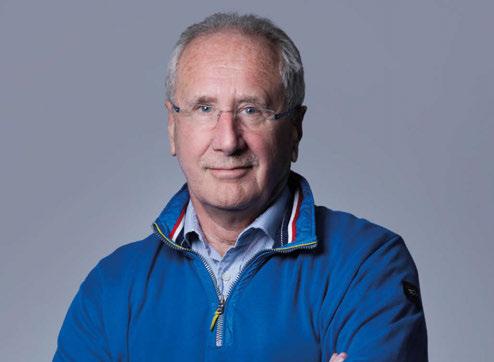
has experienced a 25% reduction with licensed operators while racecourses have seen a 15% decline in attendances over the same period, so it’s already an uphill battle.
ITV were justifiably pleased with the Cheltenham Gold Cup viewing figure of 1.8m yet over 3m tuned in to the World Championship Darts final – this audience is the very demographic of the small punter that racing has relied upon and has been losing.
Will half as many races retain the same level of interest? We shouldn’t just assume that this would lose the worst performing racecourses, with the breeding base a pyramid and numbers
“The numbers make it inevitable that there will be a further correction in the breeding base”
playing a part in delivering the full ability range of horses, so any restructure would have to look at a racing programme with that in mind. It’s not unthinkable that one or more of the iconic tracks would be caught up in this.
Isn’t it a good thing if the breeding base becomes stronger as it’s the lower-grade mares that will leave the herd? The evidence suggests whilst in some cases this is the reality, in others it finds the better mares being sold and exported in addition to overseas yearling sales increasing. If 400 yearlings leave the country each year, that’s around 10% of the foal crop and we simply haven’t the population to absorb that loss.
So, foal crop numbers matter greatly and the TBA is making that case very strongly to an increasingly receptive audience. I am convinced that with some big, bold decisions, there is a robust and sustainable industry to be had from the current difficult landscape. In this respect, please read my article in February’s magazine, headlined ‘Global goals can halt sport’s rapid relegation’, and please continue to support the industry by staying with us whilst we work to deliver that better tomorrow.
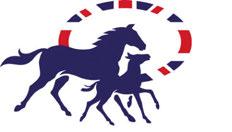

Jim Mullen will lead The Jockey Club into a new era after being appointed Group Chief Executive from June 1. He will succeed Charlie Boss, who has been in the post on an interim basis since December 2024 following Nevin Truesdale’s decision to step down from the role at the end of last year.
Mullen, 54, joins The Jockey Club from Reach plc, the largest commercial news publisher in the UK and Ireland – its 120 publishing brands including the Daily Mirror, Daily Express, Daily Record and Daily Star – where he has been Chief Executive since 2019.
A horseracing fan and racehorse owner, Mullen was Group Chief Executive of Ladbrokes Coral Group plc between March 2015 and March 2018, having previously been Managing Director of Ladbrokes Digital and Chief Operating Officer of William Hill Online. Prior to that he was Digital Strategy Director and Director of Product Management at News International and Director of Digital at Publicis Group.
Mullen is currently a non-executive Board member of Racecourse Media Group, the umbrella organisation responsible for media rights involving 61 racecourses in Britain and Ireland.
He said: “While The Jockey Club will be known to many as one of the most prestigious and established organisations in British sport, it is also a forward-thinking and exciting business with its focus firmly on the future.
“As a lifelong horseracing fan who has spent some of the best days of my life on racecourses, I could not be more proud to join The Jockey Club’s passionate and dedicated team through what I hope will be an exciting new chapter.
“Publishing and horseracing might appear to be two very different industries on the surface. However, they share a focus on providing value and quality for the customer while nurturing happy and motivated teams across multiple sites, and I am passionate about delivering both.
“I would like to thank all my colleagues at Reach for their hard work and all that has been achieved together over the past six years. I now look forward to forging new relationships in horseracing and renewing others developed during my time in the gambling industry.”
The Jockey Club’s Senior Steward,

Jim Mullen: extensive experience in the publishing and gambling sectors
Baroness Dido Harding, said: “I am delighted to welcome a leader of Jim’s calibre and experience as our next Group Chief Executive.
“He has a long and distinguished track record of delivering strong growth in the publishing and gambling sectors and is also familiar with the complexities of the British racing industry, its structure and
challenges, as well as the very many opportunities we have to broaden our fanbase.
“Jim will bring with him a wealth of experience and expertise, while also being a racing fan at heart who is passionate about promoting the sport and the incredible experiences we are able to offer our customers.”
Gay Kelleway is looking to the future after being forced to abandon her proposed link-up with Ann Duffield in North Yorkshire.
The Newmarket trainer had no option but to shelve the new venture in Middleham, announced in October, when the sale of her yard fell through at the last minute.
Queen Alexandra Stables in Exning remains on the market and Kelleway is hopeful that the excellent facilities, which include 32 boxes, a walker and lunge pit plus two-bedroom house, two flats and a gym, will attract plenty of interest.
She said: “I’d love to have gone up there – Ann is a great person – but sadly my buyer pulled out. I had removal vans ready; everything was sorted. But you just have to deal with it.
“It’s such a lovely yard and perfect for a young trainer to come in and get started. I’ve been here for 22 years and trained Group and Listed winners from here
“I’ve still got very good owners and I’m still buying horses, but my desire is to join up with another trainer.
“If someone comes in and buys the yard, they can take the reins and get on with the training and I can help find owners and handle the management/ entries side – the amount of admin you need to do now has gone through the roof.
“There’s a couple of trainers that I’ve spoken to already that seem quite keen.”
Having been a pioneer during her career in the saddle, becoming the first woman to ride a winner at Royal Ascot

when partnering Sprowston Boy –trained by her father Paul – to victory in the 1987 Queen Alexandra Stakes, Kelleway has also made her mark in the training ranks.
Sorbie Tower was a high-class miler, finishing a close third in the 1996 St James’s Palace Stakes, Vortex was a Group and dual Listed winner, taking the 2005 Criterion Stakes, while more recent stars include top all-weather performer Lightscameraction and Global Spectrum, successful in the 2019 Al Biddah Mile in Qatar.
“I’ve had so many big moments,” said Kelleway, who also had a spell working for Pacemaker Update in London. “I started out in the early 1990s when there were hardly any women trainers. It was tough. To put it bluntly, I didn’t have a pot to piss in.
“The Jockey Club wouldn’t give me a licence without a certain amount of money in my bank account. So, I called David Sullivan – he had owned Risk Me
Willie Mullins was crowned champion jumps trainer in Britain for the second successive season after securing a final-day treble at Sandown on April 26.
Title rival Dan Skelton held a £68,400 lead heading into the meeting but big-race victories from Gaelic Warrior in the Oaksey Chase and Il Etait Temps in the Celebration Chase saw the master of Closutton take the trophy again.
Mullins couldn’t capture the afternoon’s other most valuable prize, the bet365 Gold Cup, but supplied the second, third, fourth and fifth as victory went to champion jump jockey Sean Bowen on Resplendent Glory. Mullins also took the closing handicap hurdle with Jump Allen.
In total, Mullins’ horses earned over £260,000 on the afternoon, meaning he finished the campaign almost £200,000 ahead of Skelton.
Willie Mullins overtook Dan Skelton on the last day of the season at Sandown to win his second British trainers’ title
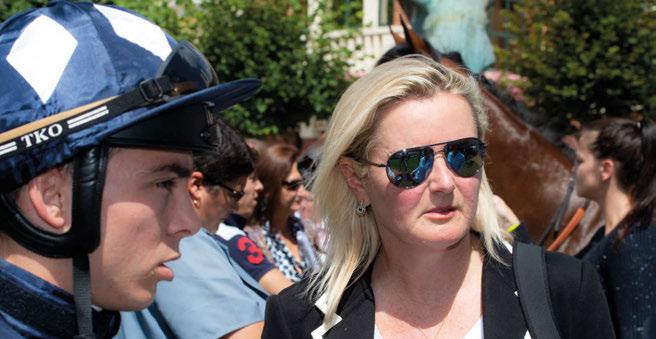
[winner of two Group 1s in France] with dad – who promised to pay any debts and fully support me.
“David also sent me four horses and it’s thanks to him I got going as a trainer.
“My father didn’t speak to me for six months when I started training. He told
me I was crazy and was very hard on me.”
Those wishing to read more about the trials and tribulations of Kelleway’s journey in the sport are in luck – her autobiography, currently titled The Life and Loves of a She Jockey, is due to be published next year.
William ‘Bill’ Leach, who for many years was the owner and manager of Meddler Stud, situated in Kentford on the outskirts of Newmarket, died last month aged 91. A successful businessman from an established racing family, he was also active in local politics. Leach had inherited his family’s jovial nature and for many years was renowned as an amusing and generous host.
Meddler Stud had been laid out by his grandfather, Felix Leach, who had come down to Newmarket from Wigan to assist Matt Dawson at Heath House Stables during St Simon’s time, and he later assisted Richard Marsh at Egerton House when Persimmon won the Derby for the King in 1896. The following year Felix Leach commenced training on his own account at Graham Place.
An enormously popular figure, well known for breeding gamecocks and fox terriers, Felix had three sons, all of whom were apprenticed to him and rode winners. Felix junior died when he was only 31, but Jack Leach rode a Classic winner – Adam’s Apple in the 2,000 Guineas – trained for 20 years and wrote possibly the most amusing book ever written on racing, Sods I have cut on the Turf, eventually handing over his training business to his assistant, a young Bernard Van Cutsem.
The third son was Henry Leach, Bill’s father, known as Chubb. He was stable jockey to Cecil Boyd-Rochfort for four years until, in 1931, increasing weight cut short his career in the saddle and he started training at Queensbury Lodge.
Mickey The Greek, winner of the July Cup, Nunthorpe and King’s Stand


Stakes, owned by Lt. Col. N.E. ‘Nat’ Freeze, was probably his best horse. On his father’s death in 1953, he ceased training and took over the management of Meddler Stud.
Chubb died in 1970 and his son, Bill, took over at Meddler. Despite riding out with his father, he didn’t follow the family into training like his father, uncles and cousin Geoff Wragg. He operated Meddler as a stud farm – stallions such as Will Somers, Nelcius, Most Welcome, Pretendre and Tutankhamen, imported from America, were the mainstays.
Meddler was also one of the first large-scale boarding studs in Newmarket, for many years housing Sheikh Maktoum Al Maktoum’s


Gainsborough Stud yearlings.
A large part of the stud was sold at the turn of the century and is now a housing estate, but the main part of Meddler now forms part of neighboring Lanwades Stud. A few of Felix Leach senior’s grey gamecocks lingered on, in a feral state, in the shelter belts, until the houses were built, but with their demise and Bill’s death, a Newmarket racing dynasty comes to an end.
Leach is survived by wife Bente, son Charles and daughter Tania, and grandchildren Zena, Rex, Lily and Zac.
The funeral was held at All Saint’s Church in Newmarket on April 24. Memorial contributions may be made to the National Horseracing Museum.




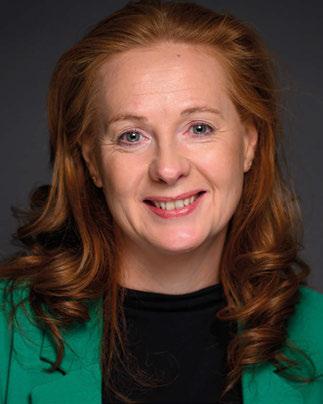
Sharon O’Regan
Announced as new Chief Executive of Weatherbys Ltd, succeeding Russell Ferris, who will join Racecourse Media Group as Managing Director in August.
Ollie Fowlston
Senior auctioneer rejoins Tattersalls, where he spent 25 years between 1998 and 2023, following a spell as Managing Director at Dullingham Park Stud.
Alan Johns
Jockey goes out on a winner, retiring after riding Bumpy Evans to victory at Ffos Las in April. His plan is to pursue a media career.
Qatar Racing
Ownership entity of Sheikh Fahad Al Thani removes all horses from trainer Andrew Balding. The partnership enjoyed Classic glory with Kameko in 2020.

Nick Scholfield
Retires from the saddle aged 35 after contesting the Grand National. He partnered 670 winners in Britain and enjoyed Grade 1 success on four occasions.
Dr Jerry Hill
Chief Medical Adviser to the BHA will retire later this year having served in the role since 2014.
Coral-Eclipse
Prize-money for Sandown Park’s flagship Flat race hits £1 million for the first time. The £250,000 increase has been made in Coral’s 50th year as sponsor.
Amy Starkey
Set to move from her position as Managing Director of the Jockey Club’s racecourses to a new role focused on Newmarket.


Brian Barr
Former trainer handed indefinite exclusion order by the Disciplinary Panel after failing to pay three members of staff prize-money dating back to 2023.
Levi Williams
Apprentice jockey charged with murder after a 71-year-old man injured during an altercation outside a pub in Newmarket dies in hospital.
Dylan Cunha
Newmarket trainer splits with stable jockey Rhys Clutterbuck, who is based in Sussex, for geographical reasons.
Hayley Turner
Group 1-winning jockey announces she is retiring with immediate effect and is expecting a baby in October. In total she rode 1,022 winners in Britain.
Mohamed Obaida
Emirati owner whose blue and red silks were carried by brilliant filly Sayyedati, topclass miler Air Express and current globetrotting star Dubai Honour.
Bill Leach 91
Proprietor and manager of Meddler Stud outside Newmarket who came from a distinguished racing family.
William Nunneley 77
Former Head of Stewarding at the BHA who was an official for over 30 years, starting as a part-time judge in 1980.
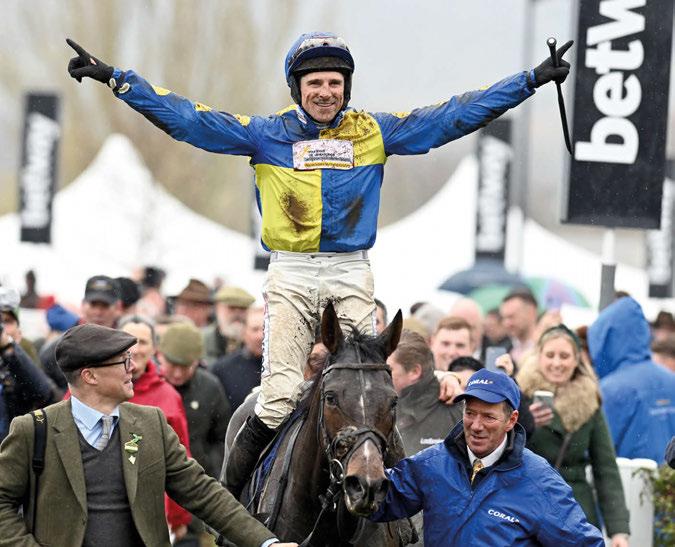
Palladium
Last year’s German Derby winner, successful on his hurdling debut for Nicky Henderson, joins John and Thady Gosden ahead of a Flat campaign.
Harry’s Bar
Dundalk specialist is retired aged ten by trainer Stephen Thorne after recording his ninth victory at the all-weather venue. In total he earned £242,000.
Daughter of Night Of Thunder, superb winner of the Albany Stakes at Royal Ascot last season, is retired to the paddocks after aggravating an old injury.
Mineshaft
Sire of 2024 Saudi Cup winner Senor Buscador is retired from stud duty aged 26 by Lane’s End Farm. The son of A.P. Indy was US Horse of the Year in 2003.
Talented performer for Dan Skelton and Colm Donlon, winner of consecutive Coral Cups at the Cheltenham Festival, is retired aged nine due to a heart condition.
Winner of the Cheltenham Gold Cup in 2000 for owner Tim Collins, trainer Noel Chance and jockey Richard Johnson, defeating Florida Pearl.
Celebre D’Allen 13
Talented staying chaser for owner Allan Stennett and trainers Philip Hobbs and Johnson White dies from a respiratory infection after the Grand National.
Darling My Darling 28
Grandam of 2024 US champion three-year-old male Sierra Leone and multiple Group 1 winner Forever Young.
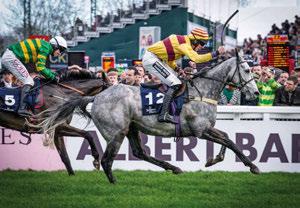
The Kniphand 7
Progressive chaser for the Nigel Twiston-Davies stable succumbs to injuries sustained in a fall in the Scottish Grand National at Ayr.
Macdermott 7
Winner of the 2024 Scottish Grand National for Gallagher Bloodstock Limited and Willie Mullins suffers a fatal injury in this year’s Ayr marathon.
Prolific hunter chaser gave owner Robin Tate and trainer Fiona Needham a day to remember when scoring at the 2024 Cheltenham Festival.


has fuel in reserve at Aintree
It’s all to play for in the Randox Grand National as the leaders enter the final furlong at Aintree. Nick Rockett and top amateur Patrick Mullins are in the lead, chased hard by 2024 victor I Am Maximus and Paul Townend under the welter burden of 11st 12lb, as close to 60,000 racegoers enjoy the spectacle that is unfolding in front of them.
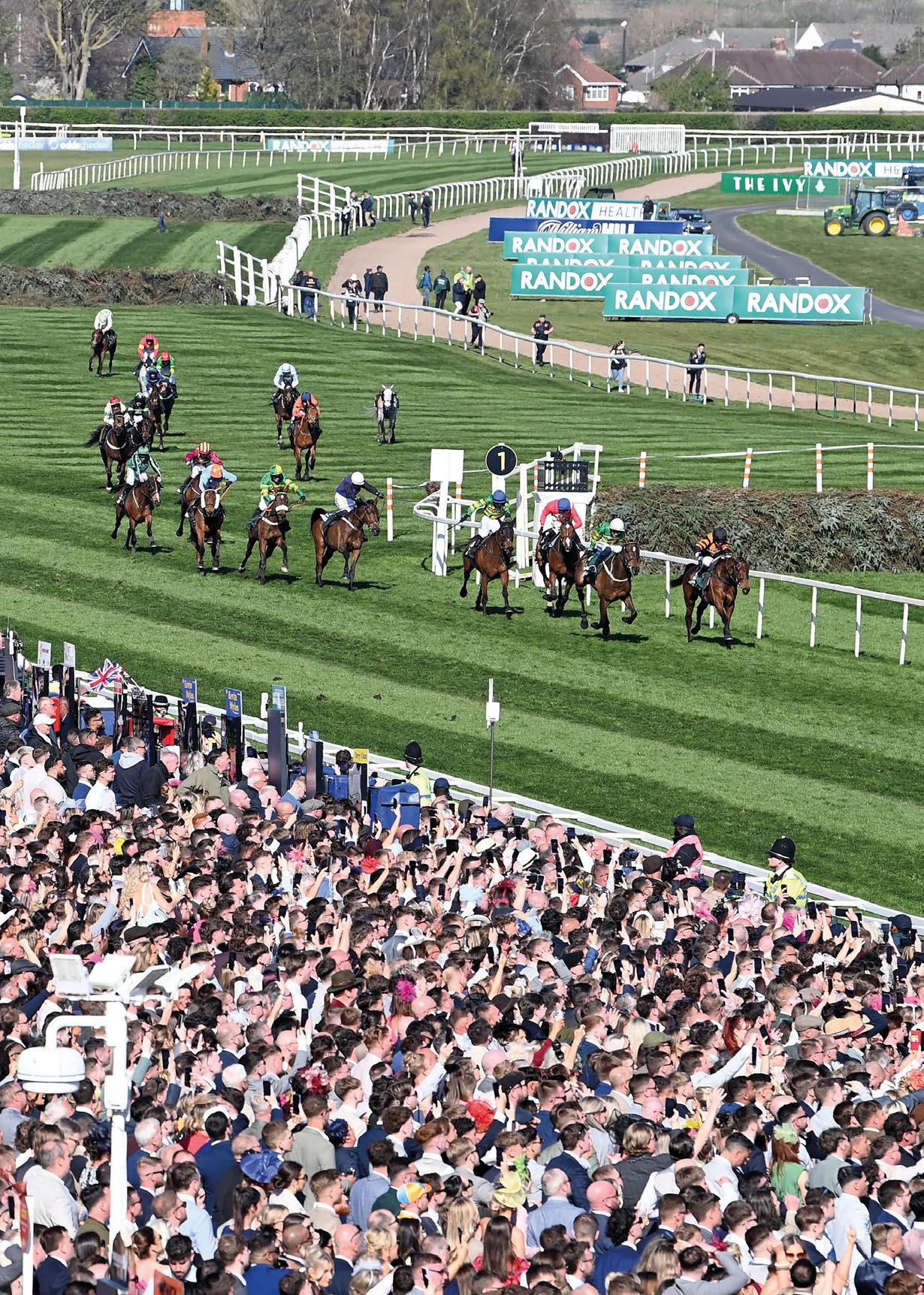

Nick Rockett has enough petrol in the tank to last home, proving two and a half lengths too good for stablemate I Am Maximus, with Grangeclare West, Iroko and Meetingofthewaters in behind. The result was a personal triumph for trainer Willie Mullins (below in hat), who saddled four of the first five home and was overcome with emotion in his post-race interview having watched his son (next to girlfriend Sara Rose) win the world’s most famous horse race.
For owner Stewart Andrew (below with trophy) the result had extra poignancy; his late wife Sadie, who originally owned the Walk In The Park gelding, decided Mullins was the man to train Nick Rockett and saw him run once before she passed away in 2022. “Out of such sadness, such joy has been born,” said the winning owner about his star chaser.
Photos Bill Selwyn





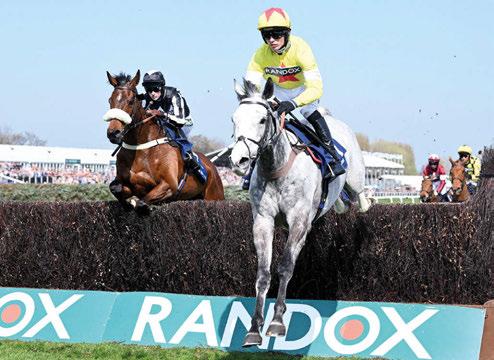
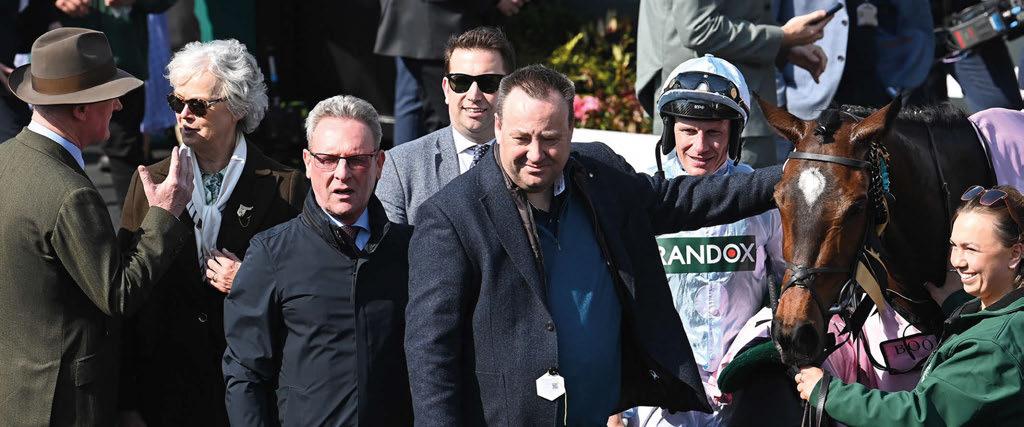

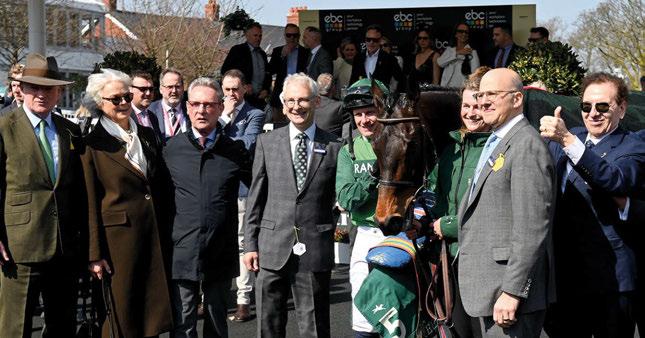

It’s a crisp autumn afternoon at Newmarket as the runners parade before the 3.15, but the grandstands tell a tale more sobering than any stewards’ enquiry. The mainly empty stands stare blankly at the hallowed Heath where racing history has been written since Charles II galloped these same acres.
Meanwhile, 200 miles north at Cartmel, on a Bank Holiday Monday, picnic hampers are aligned like infantry battalions across the infield, and the crowd swells into five figures, their collective roar challenging the Lake District’s natural acoustics.
These contrasting tableaux reveal a sport grappling with its own identity. The attendance figures for 2025 sprawl before us like a complex form guide. The headline story – Cheltenham disappointing whilst Aintree was encouraging – suggests a sport with unpredictable crowd patterns even at its showcase events. Yet delve deeper into the midweek all-weather fixtures and you’ll find tracks drawing fewer souls than might attend a decent village cricket match.
For owners who invest thousands in training fees, the anti-climax of leading in a winner to deserted enclosures represents perhaps racing’s most poignant failure. Nothing diminishes the thrill of victory quite like celebrating in an echo chamber, where the only witnesses are a handful of stable staff from rival yards.
This hollow moment of triumph represents racing’s existential challenge in microcosm. When the sport can’t deliver atmosphere for its most invested stakeholders at their moment of greatest achievement, the sustainability of the ownership model itself comes into question.
Racing today operates in a fiercely competitive entertainment landscape that simply didn’t exist 40 years ago. The sport now competes not just with other live events but with Netflix binges, immersive gaming experiences, social media feeds, and countless digital distractions.
While betting remains vital, it alone cannot sustain the live experience in an era where wagering is available from the comfort of one’s sofa. Racing needs engaged, participatory audiences who feel emotionally invested in the spectacle beyond their financial interest in the outcome.
Looking beyond racing’s boundaries reveals transformative approaches. Darts has transformed its participants from anonymous practitioners into vibrant personalities. While racing celebrates its equine stars, it has underinvested in the human narrative. The characters, rivalries, and back stories that make darts compelling remain largely untapped.
The National Basketball Association’s micro-moments strategy has redefined in-venue entertainment by transforming dead time into engagement opportunities. Racing’s lengthy intervals between races represent vast untapped entertainment potential.
Cricket has segmented its presentation according to format while maintaining sporting integrity. Racing could similarly develop distinctive presentation styles for different fixture types without compromising the fundamental sporting contest.
Formula 1’s fan zones have revolutionised motorsport attendance by creating interactive areas where spectators can experience simulators and technology showcases. Racing could develop similar interactive zones explaining handicapping systems, breeding science or jockey techniques.

Premier League football’s community trusts have embedded clubs within their localities. Racing’s community engagement often feels tokenistic rather than systematic.
Major League Baseball’s dynamic pricing model has transformed baseball’s attendance by adjusting ticket prices based on factors including weather and day of the week. Racing’s rigid pricing structures typically fail to reflect value differences between fixtures.
Amidst the attendance figures, Cartmel racecourse stands as a remarkable success story. With an average attendance exceeding several thousand spectators across its limited summer season, this small Cumbrian venue demonstrates what’s possible.
“Premier League football’s community trusts have embedded clubs within their localities”
Cartmel’s genius lies in its concentrated calendar, with just nine annual fixtures creating an irresistible scarcity. Its picturesque Lake District setting elevates the racecourse beyond mere sporting venue. The intoxicating festival atmosphere, with food markets, diverse entertainment options, and celebrated picnic culture, creates a sensory experience appealing beyond traditional racing audiences. Cartmel’s profound local engagement and deep community roots ensure passionate regional support regardless of racing quality.
Rather than attempting to increase attendance at every fixture, a more nuanced approach might include:
1. Segment and specialise the racing calendar
• Attendance-focused festival fixtures would concentrate resources on fixtures with genuine crowd potential, creating unmissable social occasions.
• Industry-supporting midweek fixtures would prioritise broadcast quality and digital engagement over physical attendance.
• Community-integrated local fixtures would develop deeper connections with immediate communities through partnerships with schools, businesses and civic organisations.
2. Redesign the raceday experience architecture
• Arrival experience enhancement could transform the often-underwhelming entry process into a moment of anticipation.
• Between-race entertainment programming should be systematically designed rather than treated as inconvenient gaps.
• Post-racing retention strategies could extend dwell time and spending through after-parties or exclusive stable tours.

3. Implement next-generation technology
• Augmented reality course guides could transform how visitors navigate and understand racecourses.
• Smart wristband betting and payment systems could revolutionise on-course wagering and refreshment purchases.
• Dynamic scoreboard content could transform traditional race result boards into entertainment hubs.
4. Develop community asset strategies
• Year-round facility repurposing could transform racecourses from occasional-use venues to community hubs.
• Educational programme development could leverage racing’s connections to mathematics, science, business, and agriculture, building on current initiatives including the Racing to School programme.
• Environmental leadership initiatives could position racecourses as champions of sustainable land management.
Success should be measured beyond raw attendance figures.
An engagement quality index would assess dwell time, spend per head, and satisfaction scores. Digital extension metrics would measure how effectively the on-course experience extends to remote audiences. Owner satisfaction scores would acknowledge that experience quality for investors represents a critical barometer of racing’s health; the ROA’s Gold Standard criteria has made an impact in this area.
Community impact indicators would measure how racecourses benefit their local areas and a venue distinctiveness rating would assess how successfully venues create memorable experiences.
Transforming racing’s approach to attendance requires systematic change:
Year 1: Foundation-setting
• Conduct comprehensive fixture categorisation (festival,
industry, community).
• Develop racecourse specialisation strategy.
• Establish enhanced metrics framework.
Years 2-3: Infrastructure development
• Implement digital enhancement programme.
• Redesign selected venues for specialised roles.
• Launch pilot community integration programmes.
Years 4-5: Experience revolution
• Roll out comprehensive between-race entertainment programming.
• Implement dynamic pricing models.
• Develop distinctive thematic identities for major festival fixtures.
The future of racecourse attendance lies not in uniform growth across all fixtures, but in purposeful differentiation. By accepting that some meetings will primarily serve industry purposes with minimal crowds, resources can be concentrated on creating exceptional experiences at selected fixtures. The most successful sports recognise that not every fixture can or should be a sell-out. The key is creating appropriate, distinctive experiences that serve their intended audience exceptionally well.
Racing must remember its fundamental nature: an entertainment business with betting as its beating heart. While betting provides the financial engine, engaged audiences create the atmosphere that makes racing special. In a world of infinite entertainment options, racing competes not just with other sports but with every form of leisure activity imaginable.
The courses that thrive will be those that recognise they’re in the business of creating memorable experiences where the racing is the centrepiece but not the entirety of the offer. By developing engagement strategies that turn passive spectators into active participants, racecourses can cultivate the committed audiences they need for long-term sustainability even as betting habits continue to evolve in our increasingly digital world.
BY JAMES BURN
It was hard to escape the Mullins mastery at Aintree on April 5, when father Willie and son Patrick teamed up with Nick Rockett for a famous Grand National triumph.
However, that day also paid another compliment to the talents Brazil has exported to the world stage with Silvestre de Sousa landing Meydan’s Dubai Gold Cup on Dubai Future for Godolphin and Saeed Bin Suroor, while Joao ‘Magic Man’ Moreira punctuated Nakayama’s card by partnering five winners in Japan, his new adopted homeland after a lucrative spell in Hong Kong.
De Sousa, a three-time champion jockey and Classic-winning rider in Britain, and Moreira, who, in his pomp could have been seriously regarded as the finest pilot on the planet, are headline advertisements for the skills Brazilians are blessed with as horsemen.
Jorge Ricardo’s name might not be as familiar to some audiences as those two, but trivia fans will be aware of the man who holds the record for riding more winners than anyone else, with a tally north of 13,000 on his CV.
Robson Aguiar’s exploits in the saddle do not rival his prolific countryman, but he has earned an excellent reputation as a talent scout and producer of young horses, and is a key lieutenant in Kia Joorabchian’s high-profile, big-spending and ambitious Amo Racing operation, which this spring moved Brazilian Raphael Freire into
Freemason Lodge in Newmarket, the former base of the legendary Sir Michael Stoute.
So, why do Brazilians have such a natural affinity with the sport? For a start, it has a large pool to call on, with more than 200 million people inhabiting a country known for its energy and diversity that draws its roots from Portuguese, African and indigenous traditions.
Its sporting prowess is best told via its (unmatched) five triumphs in football’s World Cup, while anyone displaying such loose limbs, rhythm and balance for samba – a dance recognised as a symbol of Brazil – must surely look good on horseback.
Ricardo Ravagnani, a racing fan since childhood who works as a lawyer in Sao Paulo but also assists the International Federation of Horseracing Authorities (IFHA) with its handicapping for the South American region, is not so sure.
“I don’t really know, it’s a bit of a mystery,” he says, noting that de Sousa and Moreira hail from different areas, although neither possessed a racing or riding background as a child.
Jose Severo is mentioned as someone who could be the next Brazilian jockey to enter wider consciousness as a weighing room star and is trying to make his mark in Australia, which might give a glimpse into the current state of play in a nation that boasts two main racing authorities in the Jockey Club Brasileiro (JCB) in Rio de Janeiro and Jockey Club de Sao Paulo (JCSP).

Situated in a stunning location not far from Christ the Redeemer and the Copacabana Beach, Hipodromo da Gavea was built in 1926 when it was initially known as Hipodromo Brasileiro. It is the centrepiece of the JCB, racing three times a week (Sunday to Tuesday) and hosting the Grande Premio Brasil, the nation’s top race that has the hallmarks of some of Europe’s greatest prizes as a 1m4f contest for three-year-olds and above on turf.
Gavea also has a dirt track, but turf racing is king in Brazil, which is not common among all major South American jurisdictions, and also the main attraction at Cidade Jardim in Sao Paulo.
Like its Rio rival, it features a cherished all-aged, middle-distance race – the Grande Premio Sao Paulo – and both tracks stage Triple Crowns with mile and mile-and-a-quarter races leading up to the mile-and-a-half Grande Premio Cruzeiro do Sul (or Brazilian Derby) at Gavea and the Grande Premio Derby Paulista at Cidade Jardim, which opened its doors in 1941.
Crossover between equine and human participants at the venues, which each have sizeable training facilities on-site like in the US and share similarities in layout with Belmont Park but do not really do off-seasons, is infrequent given the distance (300 miles) between them, while they are backed up by Hipodromo do Cristal and Hipodromo do Taruma, more provincial circuits closer to the stud farms of Porto Alegre and Curitiba.
The latter is seen as a feeder track into Cidade Jardim, which, with the JCSP, has historically played second fiddle to Gavea and the JCB, whose membership dwarfs its counterpart.
A sole Saturday slot each week has not aided Cidade Jardim’s ability to threaten Gavea’s supremacy and significance, although Ravagnani views the reduction in fixtures as a depressing turn in general for racing, which he says was “once the second most important sport in Brazil but is not popular anymore”.
He considers the 1950s and 1960s as a golden period for racing in Brazil before political interference – due to the stigma around gambling and betting in a predominantly Catholic country – resulted in a downward spiral that has had a lasting impact. It has also been exacerbated by a worldwide problem of established owner-breeders moving on or dying and the void not being filled.
According to the IFHA, Brazil staged 8,967 races (handicaps are rare, or at least were as the weight-for-age scale is favoured) in 1995 with 11,302 horses competing in those events.
Joao Moreira: top jockey is now based in Japan and won the Japanese 1,000 Guineas on Embroidery in April

Those figures fell sharply to 5,105 and 7,017 ten years later and they dipped again to 3,039 and 4,648 in 2019, when average prize-money per race of €4,285 placed it in the same bracket as South American neighbours Argentina and Chile, which might be considered stronger outfits today.
That year’s Grande Premio Cruzeiro Do Sul was, according to the Racing Post database, worth £15,151 to the winner, but the successful connections of this year’s race, which took place a day after the Grand National, pocketed just £6,468.
The horse responsible for that victory was a colt called Nudini, who is by Drosselmeyer, a Belmont Stakes and Breeders’ Cup Classic hero, and not the only dirt influence in Brazilian pedigrees given the desire to exploit the riches on offer on the surface in Dubai.
That journey became complicated because of Glanders, a contagious and fatal bacterial disease that has meant shipping and quarantine procedures – just like the ones South African horsemen endured with African Horse Sickness – are more laborious.
Those restrictions could change soon, but the ‘Classic’ European horse is still considered the beau ideal of Brazilian breeding, which is said to contain French elements at its historic core, although numbers have fallen in that section of the industry as well.
Statistics provided by Mayra Frederico, keeper of the official stud book in Brazil,
show there were 4,079 mares registered in 2009 against 2,221 in 2023, while foal figures for those years dropped from 3,044 being born to 1,745.
The stallion ranks, which now include Sangarius, a Royal Ascot winner for Stoute and world-renowned breeding powerhouse Juddmonte not so long ago, numbered 128 in 2023 (falling from 284 in 2009), but nearly 300 stud farms still exist, and Ravagnani maintains hope for the long-term health of his first love.
“The stallion ranks include Sangarius and 300 stud farms still exist”
He recognises a “real estate” threat that could lead to redevelopment of the prime land the two main tracks sit on – there were fears for Cidade Jardim last year when local officials tried to ban the use of animals for sporting activities and specifically those linked to betting – and he has frustration for how racing is run, marketed and organised, but says: “There is passion here, but racing and betting was forbidden. I would study the form at
college and all my classmates thought I was strange, but now the word ‘bet’ is in the Portuguese vocabulary.
“Every single kid has a shirt with a soccer team sponsored by a betting company, so everybody knows about it. I thought it would be impossible to break the stigma of gambling, but I think the situation is better than ten years ago because that stigma has been broken.”
Advances in technology and regulation being eased could also mean a hike in betting turnover, while a fresher, younger, data-hungry and savvy style of gambler may drive a sport that, like on every other corner of earth, relies on gambling as its primary source of income.
“Everybody bets on football now, but hopefully people will realise how horseracing is better to the smart guys,” adds Ravagnani, who also acts as an analyst for ESPN. “Brazilians are easygoing and love an easy way to win money – it’s a culture for us – and that’s why horseracing was popular [before political intervention], but I think the new generation will see it’s a brain game.”
That game could get even better if Ravagnani’s dreams are ever realised.
“I know it can work, but we need investment,” he says. “I’d go to the Hong Kong Jockey Club and see if they were interested in franchising their horseracing model; there are more than 200 million people in Brazil and we love gambling. So why don’t we try to make it popular again?”
Breeding clubs have been growing in number in recent years – and little wonder given the opportunity for new or lapsed breeders to become involved at an affordable level
Words: Martin Stevens
It has been recognised for years now that syndicates are the way forward for expanding the ranks of owners. The likes of Kennet Valley Thoroughbreds, Middleham Park Racing and Nick Bradley Racing have become part of the fabric of the sport in Britain, and new clubs are springing up all the time.
The bloodstock industry has been slower to grasp the benefits of shared investment, though, even when it has been obvious for a long time that the number of breeders is plummeting, and that there is a pressing need to find new people to own mares and foals – or, more to the point, shares in them at a smaller cost.
However, breeding clubs and syndicates have started to grow in number in recent years, and the successful example set by Newsells Park Stud should have accelerated the launch of more in the future.
filly Hatysa and a certain three-yearold filly by home sire Nathaniel named You Got To Me, in whom the stud had bought a half-share from Valmont after she won a Kempton maiden on debut in the autumn of her juvenile campaign.
You Got To Me put the Newsells Park Stud racing and breeding fund’s name in lights when she won the Irish Oaks last summer and again when she sold to Amo Racing for 4,800,000gns at the Tattersalls December Mares Sale, despite the best efforts of Smith-Bernal to keep hold of her.
“It all stems from the racing syndicates that Graham introduced soon after he bought the stud,” says Newsells Park General Manager Julian Dollar.
“We had a lot of people ask how they could get involved with the breeding side”
Newsells Park Stud’s racing and breeding funds are the brainchild of tech entrepreneur Graham SmithBernal, who bought the Hertfordshire nursery lock, stock and barrel in 2021.
The first such syndicate was launched last year, and its portfolio contained the blue-chip broodmares Beautiful Timing, Espressoo and Sibila Spain, the two-year-old Sea The Stars
“We had a lot of people visit the stud, fall in love with the horses and surroundings, and ask how they could get more involved with the breeding side because of that.
“That’s why the racing and breeding fund was launched. It allows people to get involved with our business model of buying mares, mating them as well as we can while being commercial, and seeing where we are after three or four years before making a decision about whether we need to keep them or move
National Stud breeding club members enjoy a visit with its mares Ocean Paradise and Hot Flush

them on.
“It’s exactly how we do things anyway, but with other people involved. We’re 50 per cent shareholders in everything, so our goals are very much aligned.”
The first investors, who paid £100,000 for each share, enjoyed a charmed introduction to syndication, thanks to You Got To Me’s exploits.
“Graham thought it would be fun to put her in the syndicate and we all had the most amazing year with her,” says Dollar. “It was a dream start to the venture, having a filly win a Classic and sell for a fortune.

“Mind you, I’m not telling tales out of school when I say that we had hoped not to have to sell her, and breed from her ourselves in the future, especially when she’s by Nathaniel and there’s an emotional connection. But of course if you get the opportunity to make a nice profit it’s hard to turn it down. We and most of the investors are business people at the end of the day, after all.
“The market was so hot last year that the partners saw an opportunity to sell, and took it. Graham was desperate to keep her, but the price simply went beyond our reach. He gave it a bloody good swing, though.”
He adds with a laugh: “Don’t worry, I’ve been at pains to tell the syndicate members they’re never going to have it as good as that again.”
Another Classic winner might be hard to emulate, but the quality contained in the racing and breeding fund 2025, which had almost sold out at the time of writing, gives the next round of investors a decent chance of success.
The portfolio is comprised of the broodmares Art Of Magic and Zasha and the Listed-winning Sea The Stars four-year-old filly Grand Stars, purchased for €800,000 at Arqana in
December, as well as four two-yearold fillies, all siblings or offspring of Group 1 winners: a Frankel full-sister to Without Parole, a Frankel three-parts sister to Waldgeist, a Siyouni half-sister to Legatissimo, and a daughter of St Mark’s Basilica and Talent.
“Those two-year-old fillies are unbelievably well bred and are all really lovely individuals,” says Dollar. “People might not expect us to syndicate them but doing so is mutually beneficial, as it has given us an opportunity to race some of our best-bred horses that we would have otherwise have had to sell.
“It’s a fantastic chance for us to
retain those potentially important future broodmares for the stud, and to race them with some great people.”
Dollar admits to being wary of the concept of sharing ownership of the stud’s prime stock, but has come around to it – and now preaches its virtues with the zeal of a convert.
He says: “I worked for the Thompsons at Cheveley Park Stud, Dr Tony Ryan at Castleton Lyons in Kentucky and then Klaus Jacobs at Newsells Park Stud, and they were all fabulous people who did their own thing, breeding and racing privately with their own ideas. I didn’t have much experience of syndicates, or public ownership, so I wasn’t sure about it all.
“At one point I did say to Graham that we’re a stud, but are racing more of our colts than fillies, and that it didn’t make sense to me. But he’s something of a visionary who can see how things need to evolve and adapt in order to survive and thrive, and he assured me that we needed to move in a different direction.
“I see it now, it makes sense for our finances and our enjoyment. It’s been fascinating to see the pleasure that syndicates bring, and Graham has kept it to people with similar interests who will enjoy each other’s company. They’ve had a great time visiting the stud, joining events and going on all sorts of tours. I think I’d taken for granted how thrilling breeding horses is to outsiders.”
Dollar adds that the syndicates have the potential to be beneficial not only to Newsells Park Stud, but also to the wider industry.
“It’s great that there are some big new players spending a lot of money at the sales, and along with the high-

rolling owners who have been in the game for years, they’ve made the top end of the market look incredibly healthy; but you do have to question how robust it is in the middle,” he reasons.
“There aren’t enough people who can participate at that level on their own, but if you can encourage people of decent net worth to come in as part of a collective, they might just have the confidence to get involved.

“We need those people for our business to succeed, and by going in half with them on some of our best horses, we’re showing how serious we are about getting them in. Hopefully, if they enjoy it, they’ll come in on another fund, and if they really get hooked they’ll make investments of their own. That’s why someone like Graham, a British breeder committed to the home industry, has been such a positive influence since he’s got more involved.”
Taylor Made Farm in Kentucky has also seen the light when it comes to syndicating breeding stock. It’s hardly surprising that it should have innovated in this area in America when the company slogan is “with us, you’re family”.
Taylor Made already operated the successful shared racehorse ownership programme Medallion Racing – whose silks have been carried by Donnacha O’Brien’s brilliant filly Porta Fortuna –and it has recently added Premier Mare Packages (PMP) to its offering.
“The initiative was started to accomplish two things,” explains Taylor Made President and CEO Mark Taylor. “First, we wanted to bring new people into the breeding business with quality mares within a model that more people

could afford. Secondly, we’re concerned about the shrinking foal crop and the ripple effect it’s having throughout our industry.
“There is a lot of emphasis put on developing new racehorse owners, but we saw a void in developing new breeders.”
Taylor says no parameters have been set regarding the price-point or profile of the PMP mare acquisitions.
He continues: “To date, our lowestpriced purchase was $115,000 and our highest price was $650,000. There are 17 mares on Taylor Made now which are in the PMP programme. We look for mares who can produce foals that will fit Saratoga as well as the first three books of Keeneland September.
“Part of our philosophy is to allow the investors to participate at a higher market level within a group than they could afford individually.”
PMP is still relatively new, but it has already enjoyed some good results with the mares in its portfolio. A Charlatan colt who was the first offspring of Diamond Ore, a Tapit half-sister to Arrogate in whom Clearsky Farm is a partner, sold for $550,000 at the FasigTipton Saratoga Sale last summer, and the next evening a Not This Time filly
out of the Street Cry mare Amen Sista made $610,000 in the same ring.
That must have been music to the ears of PMP investors, who are a diverse group according to Taylor.
“We have approximately 35 partners in the PMP mares,” he says. “Some are involved with multiple mares. The group of investors includes 15 totally new people to breeding thoroughbreds, ten who used to have their own independent breeding programme but scaled down or stopped breeding altogether, and seven who invest in addition to having their own mares.”
As with the Newsells Park Stud racing and breeding fund, the syndicate has been a boon for winning over newcomers to the delights of breeding.
Taylor says: “Someone famous once remarked that breeding thoroughbreds is like playing chess with Mother Nature, and PMP allows new investors to learn about a process that has been challenging horsemen for centuries.
“The ability to come to our farm anytime they like to see their horse is one of the best things for the clients. They have access to come and bring friends and family, too. Seeing young foals running in the field and knowing that you had a hand in creating something with so much potential is truly unique.
“The programme also gives people behind-the-scenes access to a working farm. They get to learn about the systems and processes we have in place to give our mares the best possible chance to produce a top-class racehorse.
“We believe that we’re only scratching the surface with PMP. Many people are looking for opportunities to create experiences that can be life-changing. We provide investment opportunities but also learning and lifestyle opportunities that are very family-friendly. Some of our partners love to bring kids and grandkids to the

farm for visits.”
Medallion Racing has dovetailed with PMP, in that some of the people who owned shares in racehorses can now also call themselves breeders.
“There has been some crossover,” acknowledges Taylor. “Brad McNulty is from Indianapolis and originally was more into mares but then branched out into our PMP platform. Dave Barger is another great example. He is from Michigan and originally reached out through our website inquiring about Medallion. Since then, he has branched out and recently bought into an American Pharoah mare who is due to foal in the next few weeks.
“Many of our customers love learning about the whole spectrum of the thoroughbred industry. Having both breeding and racing partnerships allows us to get people involved on both sides of the business if they’re interested.”
Newsells Park Stud and Taylor Made’s partnerships are pretty highend, but budding breeders who also want to get involved but don’t have such deep pockets needn’t despair, as the National Stud in Newmarket last year relaunched its breeders club after a hiatus.
It purchased two mares for the syndicate at the sales last winter: Ocean Paradise, a well-bred daughter of New Approach whose first two foals are winners, and Hot Flush, a Siyouni mare from the family of Pour Moi. Both were in foal, to Pinatubo and Kameko respectively.
The cost of a one per cent share in the mares is £1,850, which includes the purchase price, 2025 covering fee and first year’s keep, with £750 per year payable each year thereafter. Investors receive regular updates on their stock and can visit the farm and take part in various social events.
“It’s not the first time the National Stud has done something like this, there were breeding clubs in operation until the economic downturn in 2010,” says the farm’s Head of Bloodstock Joe Bradley. “We thought the time was right to bring them back and reinvigorate them for the modern world.
“The club is whatever anyone wants it to be, really. We’ve welcomed some people who have never been into breeding before – which is great as it ticks the box of providing access to the industry, one of the pillars of our business – but we’ve also encouraged lapsed breeders who would like to come back in at a financially sustainable level, and got other current
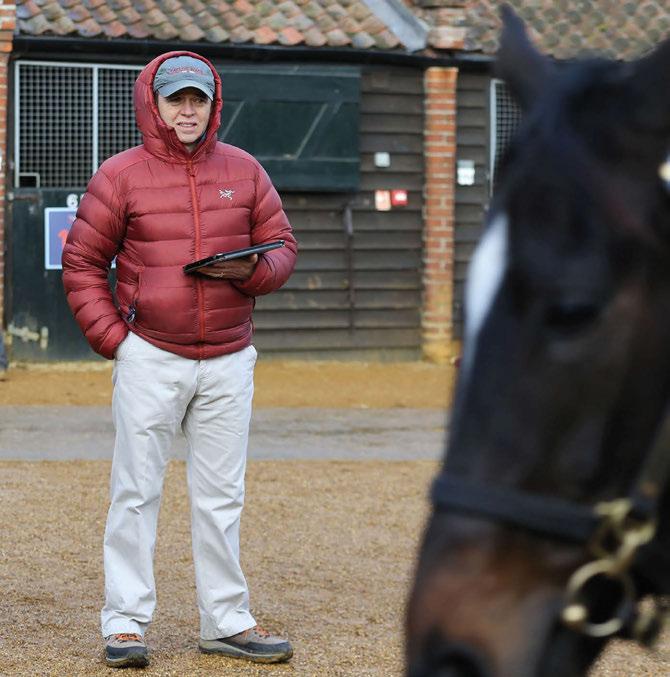
clients who want to support us in other ways on board.
“It’s been a great success so far, touch wood. Ocean Paradise and Hot Flush are nice, exciting, commercial mares and both safely foaled in the last few weeks. They are going to be covered by our stallions here now –Ocean Paradise by Bradsell and Hot Flush by Lope Y Fernandez.”
Bradley reports that there was “a great reception” to the National Stud breeding club when its return was announced last year.
“Shares sold quickly and the members seem to love it,” he continues.
“We have a WhatsApp group that’s always very active, with lots of information, photos and opinions shared.
“Plenty of them have come to the stud to see the mares, and they get a lot out of it. Even better, they bring their partner, family members or friends who might watch racing but have never been involved, and they enjoy it too, and will hopefully be inspired to get involved at a reasonable level as well.
“The members are involved in all of the decision-making, we talk through every process with them, and happily
they seem to agree with most of our opinions on what course of action to take.”
Bradley is another advocate of the mutually advantageous nature of breeding syndicates, and would like to see more of them introduced.
“It’s satisfying to bring new people into the breeding industry, but everyone has a responsibility to do that, not just us, and it’s good to see a lot of other studs have embraced clubs too,” he says.
“It’s a great thing to do, and I think it’s worth saying that we actually found it pretty easy to get enough people to sign up; it’s good for other farms who might be in two minds about doing it to know that it’s feasible.
“It’s also good for the National Stud too, of course. We own 75 per cent of both of the new mares, so we’ve been able to expand our broodmare band while also bringing new people into the game. It works for everybody.”
There aren’t many market initiatives that don’t have a catch, or stories without a downside, but breeding clubs appear to be one. Fingers crossed they can help arrest the worrying decline in foaling numbers.

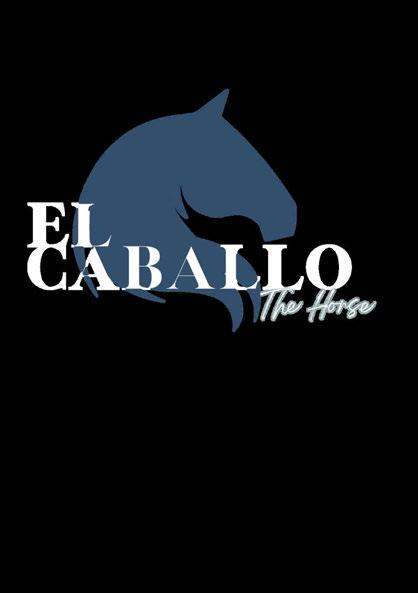
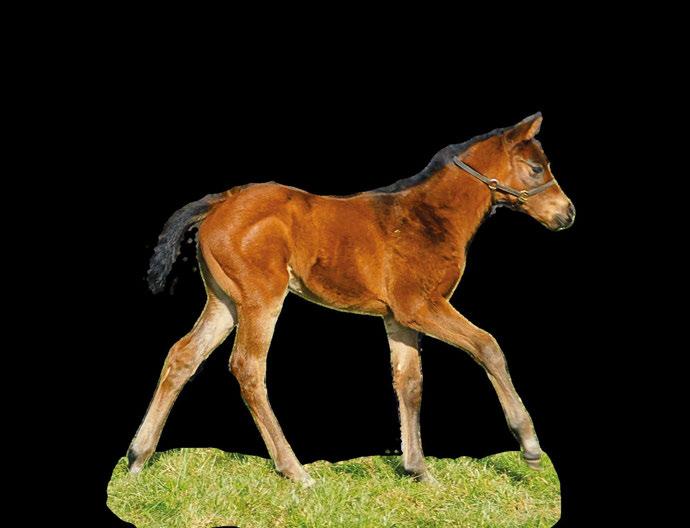





Ron Huggins
Thirty years after lifting the Gold Cup at Royal Ascot, Ron Huggins recalls his route into racing and journey to the top of the sport
Words: Marcus Townend
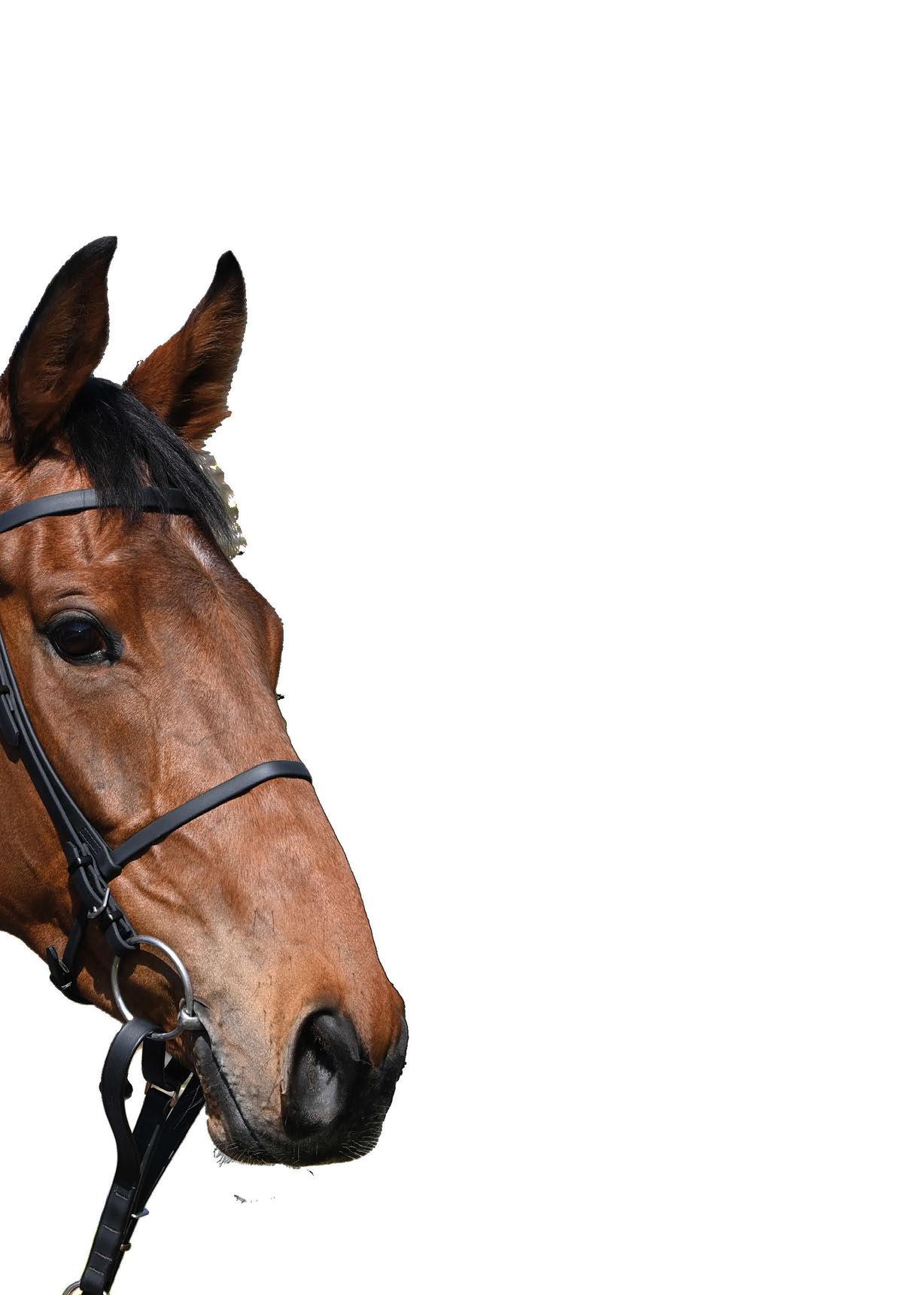
“Mark Johnston was ambitious –it was sort of a meeting of the minds”

Ron Huggins

for Kimberly-Clark, the US multinational company best-known for its Kleenex and Huggies brands, Ron took Norma and children Alexis and Simon for a day out to the local racecourse.
Huggins recalls: ‘‘We had a good day out as a family so I started thinking this could be interesting and then we watched a TV programme about Desert Orchid on Channel 4 at Christmas in 1989.’’
It all seemed so easy on TV. Buy a horse, breed a champion and you didn’t need to be a millionaire to do it.
Norma says: ‘‘The rest of us would think, ‘That was a lovely story’, but Ron sat there and thought, ‘I can do that. I’ll buy a mare’.’’
Having acquired Lady Attiva, a filly once owned by Sir Peter O’Sullevan, from Andrew Spalding at Hedgeholme Stud, ten miles from Scotch Corner, Huggins used the one connection he had to the equine world.
His sister and brother-in-law owned Welton Stud, renowned for its eventing horses. Mating Lady Attiva with grey stallion Welton Crackerjack may have seemed the ideal route to produce the next Dessie, but the flaw in the plan was Crackerjack was not a thoroughbred.
It may have been a false start but the product of the union, Welton Lady, went on to become young event horse champion at Burghley before eventing internationally for Ireland.
Huggins was hooked and drew up a shortlist list of potential trainers.
In August 1990, he travelled to Middleham to meet Mark Johnston, who had just over 40 horses at the time and was making a name for himself.
‘‘It was sort of a meeting of the minds,’’ Huggins recalls. ‘‘Mark was ambitious, and I asked him a million questions. He answered them all and didn’t make me feel stupid because I was still learning.
‘‘My saying at the time was ‘if you reach for the stars you won’t come up with a handful of mud’ – and he was of the same philosophy.’’
The meeting was the catalyst for buying Double Blue at the first yearling sale held at Ascot on October 1, 1990. Double Blue looked to possess a modest pedigree. His sire was Town And Country while his dam Australia Fair, a mare gifted to the Queen by the people of Australia for her Silver Jubilee, had turned out to be disappointing.
Looked after at a local farm in Kent, when Johnston travelled down to see him, he advised that Double Blue wouldn’t make a two-year-old and that he should be kept for a year to grow and mature.
To give Huggins an interest in the short-term, Johnston bought him Jumby
Bay, a quirky gelding who delivered Huggins’ first success in an all-weather hurdle race at Lingfield in January 1992 with Adrian Maguire riding.
Double Blue proved more than worth the wait. He made a successful debut at Hamilton on April 1, 1992, and just over three weeks later had won his first four races. By June, he was finishing second to Red Rosein in the Wokingham Stakes at Royal Ascot.
In all, Double Blue ran 68 times, both winning and finishing second 12 times and third seven times. His name would provide a theme through Huggins’ ownership.
Horses he has subsequently raced include Double Honour, winner of a Listed race in Germany and runner-up to Persian Punch in the 2001 Goodwood Cup before successfully switching to jumping, Double Quick, winner of the 1995 Dash at Epsom, and Double Diamond, winner of the 1996 Swiss 2,000 Guineas.
“If you reach for the stars you won’t come up with a handful of mud”
Many raced with Johnston in the colours of the Middleham Partnerships, which Huggins ran, and inevitably the best known were Double Trigger and Double Eclipse.
A statue at Doncaster commemorates Double Trigger’s achievements at the South Yorkshire track – and he even had a train named after him.
Arguably, his most memorable performance came when he beat Double Eclipse in the 1995 Goodwood Cup.
A flashy chestnut with a broad white blaze, Double Trigger had been bought as a yearling for 7,200 Irish punts at the Orby Sale.
His looks made him a natural to be named after the palomino pony ridden by Roy Rogers, the American singer and actor known as the King of Cowboys.
When that wasn’t allowed, the Double prefix came in handy.
Huggins says: ‘‘Mark was fantastic in that I went to the sales with him and learnt. I had read the classic books – Bloodstock Breeding by Sir Charles Leicester and all the Federico Tesio stuff – and it was all about breeding Derby winners.
It is no surprise that Ron Huggins describes Double Trigger as ‘‘the horse of a lifetime’’.
The Mark Johnston-trained stayer, who won 14 of his 29 races, swept the board in 1995, winning the Gold Cup, the first of his three Doncaster and Goodwood Cups plus the Sagaro and Henry II Stakes.
The racing public loved him; his defeat of year-younger Double Eclipse in the 1995 Goodwood Cup went down in history as the first time full-brothers had finished first and second in a Pattern race on the Flat.
Huggins, who reveals he turned down an offer of £500,000 for Double Trigger before his Gold Cup win, recalls: ‘‘The 1995 Goodwood Cup was extraordinary. I thought the three-year-old allowance was very strong but Double Trigger just pulled out a bit more that day.
‘‘It was very strange because I was trying to be very even-handed with the Middleham Partners who I owned Double Eclipse with, but when they came together I did start shouting for Double Trigger!
‘‘He was such a character. I was really proud of them both, but you couldn’t help but love him.
‘‘Together I think they both helped re-establish the staying races and horses like Kayf Tara, Persian Punch, Yeats and Stradivarius have followed.’’
Three different jockeys rode Double Trigger to victory in the Goodwood Cup – Jason Weaver, Michael Roberts and Darryll Holland – and Huggins also has fond memories of the third win in 1998 when he rallied to beat Canon Can by three-quarters of a length.
Huggins says: ‘‘The third Goodwood Cup was incredible because, by this time, people thought he might be a bit over the top. In the race, commentator Jim McGrath, who became a good friend, said, ‘Double Trigger is going back, he can’t give anymore’.
‘‘But, at that moment, he picked up the bit, charged through and won. It was a great ride from Darryll.’’
One of Double Trigger’s few poor runs came when he was sent off favourite for the 1995 Melbourne Cup.
Huggins relates: ‘‘The Melbourne Cup was strange. There was an irregularity on his blood test before the race and there was a big question whether he would be allowed to run.
‘‘I always feel that maybe he was got at because he ran so badly. Immediately afterwards, it was as if he had not been in a race, but it took him a long time to recover when he got back to England.’’
‘‘Like today, I couldn’t afford to buy superstars, so we were looking for a way of competing at a lower price. I have always done my racing out of taxed income.
‘‘What Mark and I discussed was a way to find a Group 1 sire who had produced top-level winners but was out of fashion. Ela-Mana-Mou [Double Trigger’s sire] was in that category. I looked at all the Ela-Mana-Mous at the sale.’’
Twelve months later, Huggins returned to the Orby Sale and paid 17,500 Irish punts for Double Eclipse.
In the build-up to Double Trigger’s debut at Redcar in September 1993, expectations were low with Huggins admitting he was just ‘‘plodding up the gallops’’.
He won by ten lengths in track record time and then followed up just over a month later with victory in Newmarket’s Zetland Stakes.
Frustratingly, Double Trigger’s threeyear-old reappearance was delayed until the Great Voltigeur Stakes at York in August after he was kicked on the gallops by 1992 Ebor Handicap winner Quick Ransom.
But it turned out be a blessing in
disguise. A crack at the Derby may have been lost but Double Trigger had matured. He finished third to Moonax in the St Leger and won the Leger Italiano to set up his memorable 1995 campaign.
When he eventually retired to stud, Huggins was determined to support him as a sire, having set up Selby’s Farm Stud between Tonbridge and Sevenoaks.
In typical Huggins style, he was hands-on at the 40-acre farm with half a dozen mares.
When not working for Kimberly-Clark, he could be found driving his tractor around the paddocks or masterminding the marketing campaign for Double Trigger, who stood at the East Burrow Stud Farm in Devon of John and Sarah Haydon.
Selby’s Farm enjoyed breeding successes, including Double Trigger’s son Ikorodu Road, Jukebox Jive and Double Whammy, but external factors did for it by 2015.
Huggins says: ‘‘We made a profit in our third year and then the 2008 recession with the financial crisis was a nightmare. The middle and bottom market just disappeared.
‘‘During that period in the early 2000s,

50 per cent of studs stopped trading and we were one of those because you could not make the finances work.’’
In an agreement struck with HMRC, a list of assets and prices were agreed, and Huggins sold some of his mares back to himself so that he could carry on as a hobby breeder. But he concedes: ‘‘It was extremely amicable with HMRC but at the same time I felt we had failed a bit. It was disappointing.’’
Yet Huggins’ greatest breeding success was yet to come. It was the result of an ambition shared with long-time friend George Tiney to breed in France.
Polysheba, bred by the Wertheimer family, was bought on a freezing January day for €7,500 at an Osarus mixed sale at Clairefontaine racecourse in 2014.
Sent to Authorized, who was standing at Haras de Logis in Normandy, the result was I Am Maximus, winner of the 2024 Grand National for Willie Mullins and JP McManus and runner-up to Nick Rockett in this year’s race.
Huggins explains: ‘‘The intention was to retain him but shortly after he arrived, George got lung cancer. He was treated

but it came back. He decided, when it got to the yearling stage, that it was not sensible for him to carry on with a horse in training, so we sold him.
‘‘You do think what might have been, but I am delighted JP has got him now because he has done so much for racing.
‘‘The race last year was just incredible. I got a real kick out of it and feel proud because these things are hard to do.’’
Not surprisingly, the old chestnut of racing’s prize-money has been a frustration for the former ROA and TBA council member, but he does take heart from a recent development largely funded by the Levy Board.
‘‘I was on the ROA council at the time Peter Savill was there,” Huggins says. “He was very pro-active in trying to drive prize-money, but the reality is very little has changed. It is essentially because the racecourses control the fixture list and the advertising revenue.
‘‘We have the lowest contribution by bookmakers to the levy in any country and because we can’t establish an effective pool system, that is very unlikely to change.
‘‘But self-help initiatives like the Great
British Bonus scheme are great for racing and can be transformational in terms of the effect it has had on the prices of fillies at the sales, both Flat and National Hunt.
‘‘The contribution is serious on the prize-money coming in. There is £5m a year and our own experience with Spirit Of Jura has been fantastic.
‘‘She has won three GBB races with a contribution of £50,000. Sixty-five per cent of that goes to owners with the balance shared out to the trainer, breeder, jockey and stable staff. It is a win for everybody.
‘‘The only thing is that you must win these races because it is only to winners, but that has contributed £32,500, nearly a year’s training fees on the Flat.
‘‘It has really got people talking. Trainers are very interested in the concept and owners increasingly are looking at fillies at the sales.
‘‘Expansion of the GBB approach is the way forward. If you take horses that are winning, it puts you virtually on a par with the French system, the difference being you must win in Britain whereas in France, the French-bred owners’ and breeders’
prizes go down further.
‘‘GBB can be a game-changer. Everyone is desperate to win the races we have been in, which also makes it more competitive and fun. This scheme can perk up interest in breeding and ownership.’’
There is no need to perk up Huggins’ interest in the sport.
He currently owns three horses outright – Spirit Of Jura with Charlie Johnston and Western Charm and Double Dragon with Anthony Honeyball – with small shares in 13 other horses trained by Honeyball, Johnston and Ben Clarke.
The two syndicate horses with Johnston run for The Originals, ten owners who have been with the family stable for at least 20 years.
Huggins, it seems, has stamina to match his best horses and his ambition has not been dulled. An old friend might even help.
He says: ‘‘I would love to have a Group or Graded winner again and it would be brilliant to have another good stayer.
‘‘Western Charm is a mare by Frontiersman and her dam Charmaine Wood is by Double Trigger. If she does okay, I will go back and breed from her.’’
It’s an important time of year for many studs across Britain and Ireland as they watch the arrival of a stallion’s first foals
Words: Nancy Sexton
It’s that time of year where stallion masters are holding their breath. For some, it’s awaiting a stallion’s first runners. For others, and equally just as important, are the arrival of a first crop of foals.
There is nothing quite like the whispers of the bloodstock industry to fuel a notion, and for studs all over the world there will always be the pressure to receive positive chat. That starts early on as breeders look to see whether a stallion is stamping his stock. It’s not a recipe for racecourse success, but it is certainly a driving force behind early commercial appeal.
The 2024 intake of new stallions contained a number of top-class performers with the good looks to get the market pulses racing.
Many of them are backed up by the prices that they made at auction themselves, including Coolmore’s highflying trio Paddington, Little Big Bear and The Antarctic.
The Antarctic, a full-brother to champion sprinter Battaash, was a 750,000gns Tattersalls October Book 1 yearling. Little Big Bear, meanwhile, made €320,000 at the Arqana August Sale a
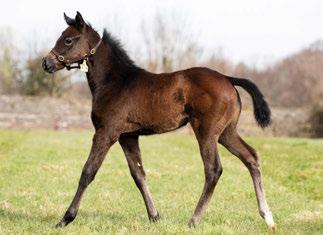
few months before Paddington realised €420,000 in the same ring at the October auction.
Paddington, a product of a successful Wildenstein family, was one of the summer highlights of the 2023 season with successive wins in the Irish 2,000 Guineas, St James’s Palace Stakes, Eclipse Stakes and Sussex Stakes, confirming his place as one of the most durable and versatile horses of recent seasons.
Juddmonte, Newsells Park, Rabbah Bloodstock, White Birch and Ecurie des Monceaux, who raised and sold Paddington, were among those to join Coolmore in sending mares to the horse last year at €55,000. In the end, the son of Siyouni covered a book of 145, a figure more reflective of the slower start he had to his debut season.
“We vaccinated the new stallions early in the year and they were held up,” says Mark Byrne, part of the nominations team at Coolmore. “The consequence was that they ended up in quarantine. That obviously wasn’t ideal but it was for the greater good of the horses. So they started off a little on the back foot, and thankfully they got through it.”

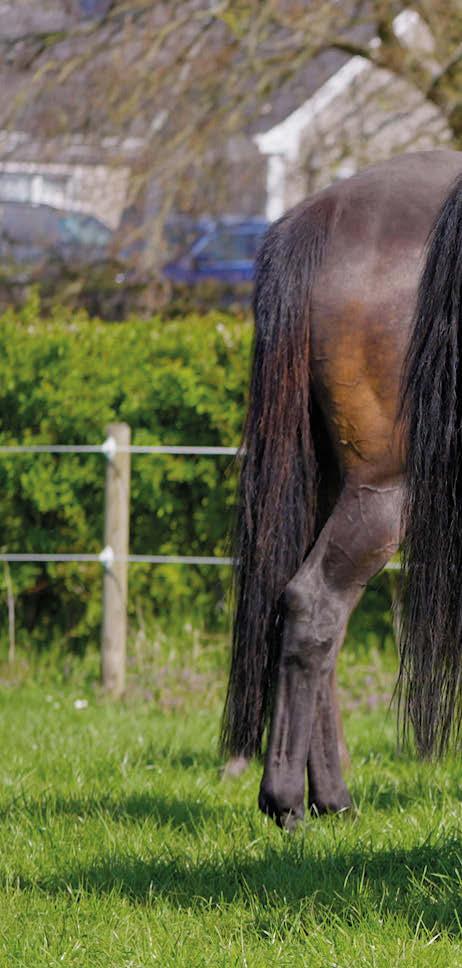
He continues: “Paddington was such a good racehorse and hardy too. To win those four Group 1 races in a couple of months was incredible.
“I met Henri Bozo [Director of Monceaux] recently and he’s very positive about the horse. He says he has a very good foal by him. Peter Brant [White Birch] also has some very good foals here,


in particular one out of [Grade 2 winner] Toinette. He also sent him Unaided [dam of Grade 1 winner Uni]. They just show the calibre of mare that Peter Brant has supported the horse with.
“Car Colston Stud, also brilliant breeders, sent its stakes producer Forest Crown and Denis Brosnan of Croom House Stud, another very good breeder, also has a very good foal out of Pussycat Lips. Tanya Gunther, who bred Justify with her father John, was also saying that they have a good filly by him at their Glennwood Farm in Kentucky.”
Like Paddington, champion two-yearold Little Big Bear has been supported by an array of leading breeders that resulted in a 156-strong book at a fee of €27,500. They include his trainer Aidan O’Brien, who saddled the son of No Nay Never to win the Phoenix Stakes by seven lengths.
“He has the backing of an impressive
roster of breeders,” says Byrne. “Oakgrove Stud have a good foal and so does John Tuthill of Owenstown Stud. A lot of people who bred to him are coming back into him off the back of the foals.
“And there are some good mares still to foal to him like Lady Gorgeous, who bred champion two-year-old Pretty Gorgeous, and Awohaam, the dam of [Middle Park Stakes runner-up] Castle Star.
“He was an extremely exciting twoyear-old and he’s the most fabulous horse to look at. He’s got loads of size and scope. Aidan always speaks about how classy he was – he has used him plenty and is breeding back to him as well.
“His foals are looking like him and I think he’ll be extremely commercial at the sales.”
The Antarctic, who covered a first book of 123 at €6,000, also boasts a fast profile as a Group 3-winning and Group 1-placed juvenile who trained on to win a Group 3
sprint at three. Some smart commercial investors used him last year, among them his own breeder Paul McCartan of Ballyphilip Stud.
“The likes of Eddie O’Leary, Rathasker and Ballyphilip Stud all used The Antarctic last year,” says Byrne. “Manister House Stud also have a good filly out of Bright Glow.
“It’s a commercial pedigree and he was rated the same as Havana Grey on 113. He cost 750,000gns as a yearling and is just the type of horse you fall in love with straight away. Thankfully he’s got off to that start where he’s stamping the stock in his mould and you can imagine them getting up and running early.”
In Britain, Juddmonte’s Chaldean was understandably well received, covering 99 black-type performers and/or producers within a first book of 173 at a
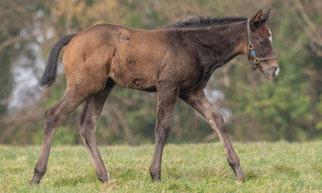
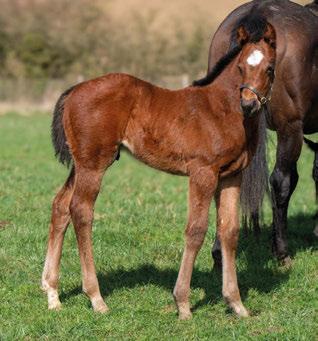
fee of £25,000. Broken further down, they include six Group/Grade 1 winners and five dams of Group/Grade 1 winners. Indeed, he covered more Group winners, stakes winners and black-type runners than any other sire of his generation in Britain and Ireland.
Chaldean is the first son of Frankel to stand alongside his illustrious sire at Banstead Manor Stud, which is indicative of his race record, good looks and pedigree. A 550,000gns foal purchase by Juddmonte and one of four stakes winners out of his high-flying dam Suelita, Chaldean was forward enough to break his maiden in July of his two-year-old season at Newbury, after which he rattled off wins in the Acomb, Champagne and Dewhurst Stakes to end 2022 as the joint champion juvenile.
That preceded a Classic season at three during which he won the 2,000 Guineas and ran second in the St James’s Palace Stakes.
Juddmonte can claim to have bred the first Group 1 winners by numerous various resident stallions, going back to Warning (by Known Fact) and Xaar (by Zafonic). Don’t bet against the operation pulling off the same feat with Chaldean given its early support included sending the dams of its current Classic hopefuls Better Together (out of Shared Account) and Swelter (out of Hot Snap) as well as Group 1 winner Timepiece and the Group 2-winning stakes producer Modern Look.

Godolphin, the Aga Khan Studs, Haras de Saint Pair and Newsells Park Stud were others to use the horse in year one.
“We are aware of approximately 93 live foals on the ground now,” says Shane Horan, Stallion Nominations Manager at Banstead Manor Stud. “These are broken up into 50 colts versus 43 fillies. Colourwise we have a pretty even split of bays and chestnuts as well as a handful of greys.
“It would be fair to say, from seeing the
“Chaldean’s stock look like precocious types at this early stage”
Chaldean foals at Juddmonte and from what we have seen at outside farms, they are much like their sire. Strong bodied, close coupled, good clean limbs and with an attractive head.
“As Chaldean did as a foal, his stock look like precocious types at this early stage. There has been the occasional foal which has been bigger and more scopier than expected and this is probably where the mare is having a strong influence. This is something we often found with
Frankel’s progeny – where the mare often dictated what the resulting foal looked like physically while Frankel could clearly impart the engine.”
He adds: “The response to the stallion in his second season has been equally satisfying. While the season is not over yet, he looks set to cover another quality book of approximately 150 mares. Many of his first-time users returned to him again which is always an encouraging sign.”
Darley’s intake for 2024 was also brimming with miling talent, comprising the Group 1 winners Modern Games and Triple Time at Dalham Hall Stud in Newmarket and Irish 2,000 Guineas winner Native Trail, also the champion two-year-old of 2021, at Kildangan Stud.
At £30,000, Modern Games was the most expensive in reflection of an international record that consisted of five Group 1 victories at two to four years, among them the Poule d’Essai des Poulains, Lockinge Stakes and back-toback Breeders’ Cups (Juvenile Turf and the Mile).
Nor will it have escaped the notice of savvy breeders that he is bred on the same Dubawi - Galileo cross as leading sire Night Of Thunder and the ascendant Ghaiyyath.
“When you look at Modern Games, you can see how he was such a sound, consistent racehorse,” says David Appleton, part of the nominations team
at Darley. “He’s very well proportioned and he has a great attitude as well. You can see how he was able to travel around the world so many times and compete so consistently at the top level. It takes a lot for a horse to go abroad, do that and then come back and compete at the top level at home. It’s not something you see every year.”
Modern Games received strong home support, with the Godolphin allocation including such mares as Grade 1 winner La Pelosa and Queen Mary Stakes heroine Jealous Again. However, he has unsurprisingly caught the imagination of outside breeders as well.
“It’s well documented that he covered a restricted book [141 mares] in the end,” he says. “There were 15 Group/Graded winners and nearly 60 stakes performers in there, and I think you can see that quality coming out in his foals. I’ve seen a few of them come through the covering shed and at different farms, and there genuinely hasn’t been a bad one yet. He’s a lovely horse and there’s a lot of Dubawi in them in terms of their shape and make. He seems to be stamping them with plenty of size and strength.”
Home support has also been key to the launch of Triple Time, the pillar-to-post winner of the 2023 Queen Anne Stakes at Royal Ascot. By Frankel, he belongs to one of the most important families of the current era as a son of the remarkable mare Reem Three, the dam of seven stakes horses in all and granddam of last year’s Royal Ascot winners Rosallion (St James’s Palace Stakes) and Inisherin (Commonwealth Cup). It’s a family that has been cultivated to great effect by Sheikh Mohammed Obaid al Maktoum, whose own support of Triple Time included sending stakes producer Emirates Queen, a Group 2-winning half-sister to Dubawi, and Group 1 winner Fonteyn. In all, he covered 155 mares at a fee of £10,000.
“There were five Group winners in his book, including from our Godolphin broodmare band, and 26 stakes performers,” says Appleton. “The foals I’ve seen have a bit of [damsire] Mark Of Esteem in them. They look like they could be quite forward – they look quick, they look strong and they have a lot of strength to them through their quarters. To this point he’s a pure-breeding bay.”
He added: “He beat a very good field from the front in the Queen Anne in a quick time, where he quickened off his own hot pace. He’s also from that phenomenal family. I think people have latched on to the fact that you can’t really breed to much more pedigree, especially at that fee.”
Breeders also evidently like what they
see from the first foals of Native Trail given the level of repeat business. A son of Oasis Dream, Native Trail’s unbeaten championship juvenile campaign took in wins in the National and Dewhurst Stakes. Add in the fact he won the Irish 2,000 Guineas at three and it’s easy to see how he has garnered so much early respect from commercial breeders. An opening book of 179 mares, including those from Forenaghts, Ballyhimikin, Kildaragh and the Royal Studs, gives him plenty of ammunition going forward.
“The Irish team are very pleased,” says Appleton. “We share photos of his foals between us regularly and I also saw a good one in Leicestershire recently. He’s a big strong horse and he seems to be putting a bit of scope into them.
“He was obviously a fantastic two-yearold who trained on at three, and from a fantastic Juddmonte family as well. He represents real commercial appeal and he’s going to have every chance. All the best Irish breeders have used him and people have come back this year off the back of the foals.”
First-season support from a number of high-profile outside breeders means that Shadwell’s young Frankel stallion Mostahdaf will also have every chance.
A half-brother to Group 1 winner Nazeef from the family of top sprinters Pastoral Pursuits and Goodricke, this May foal won six of his first seven starts including his seven-furlong debut early on at three. He went on to develop into an excellent older

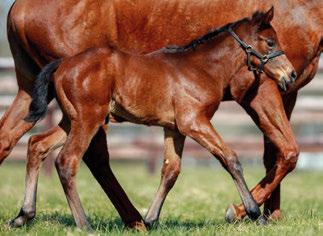
campaigner when his wins included the Prince of Wales’s Stakes and Juddmonte International, achieved in contrasting styles.
“From what we’ve seen and from what people are telling us, they seem good-sized foals with a lot of substance – the response from breeders has been hugely positive,” says Will Wright, Shadwell’s UK Nominations and European Marketing Manager. “They seem to have plenty of quality, just like him – that’s one of his selling points.
“He was an outstanding racehorse rated 128, the same as Ace Impact that same year and also City Of Troy. He was very good in the Prince of Wales’s Stakes, when he quickened from the back of the field, but then in the Juddmonte International he made all for another impressive success. He defeated the winners of 15 Group 1s in those races. But it’s not just performance because he’s got that quality, quick pedigree being a half-brother to Nazeef and related to two champion sprinters.”
Shadwell themselves have several well-related Mostahdaf youngsters on the ground including a colt out of Alaflaak, the dam of Oaks entry Falakeyah, and a colt out of stakes winner Ataared.
“We’re delighted with our foals,” says Wright. “We like to think he’s good value and some really good outside breeders have supported him as well. Those include The Royal Studs, Highclere Stud, Kirsten Rausing, Meon Valley, Lynch Bages, Juddmonte, Stetchworth and Middle Park Studs and Hascombe and Valiant. This and the rest of his profile gives him every ››

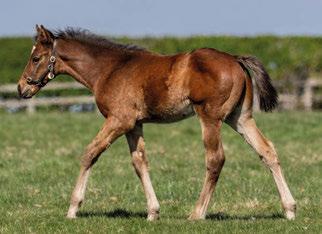

chance of producing top-class racehorses.”
The Shadwell colours were also carried to good effect by Mutasaabeq, a multiple Group 2-winning miler. By Invincible Spirit and out of 1,000 Guineas heroine Ghanaati, herself a relation to Nashwan and Deep Impact, he stood for one season at the National Stud in Newmarket prior to his sale to India.
Dullingham intent
It’s well known that fast horses and the commercial market tend to go hand in hand, so it’s no surprise to see how well supported sprinters such as Shaquille and Dragon Symbol were in their first seasons.
“We have booked 27 of our own mares into Shaquille for 2025”
July Cup winner Shaquille was a welcome recruit to Britain, retiring to Dullingham Park Stud in Newmarket where he covered an opening book of 158 mares at £15,000 under the management of Steve Parkin’s team.
Earlier this year, the son of Charm Spirit changed hands to Zhang Yuesheng’s Yulong Investments alongside fellow Dullingham stallion Soldier’s Call. Thus there is now some certainty over his future, and indeed if Yulong support Shaquille in the same way as its Phoenix Stakes winner Lucky Vega, whose first two books contained just over 100 Yulong mares, then he will definitely not lack for opportunity.
“The feedback has been very positive from breeders so far,” says Yulong’s Paul Curran. “Before we bought Shaquille, I had already been hearing word that his foals are exceptional. Witnessing them myself, I can wholeheartedly agree with that. He really stamps his stock; he is a beautiful looking horse himself, well balanced with a striking presence. And you can see these characteristics throughout his stock thus far.
“We have had a lot of breeders return in 2025 on the back of the foals produced from their 2024 cover. That to me is a huge testament to the sire. In any case of business, if you can have customer retention it speaks volumes for your product. That’s the power of satisfaction.”
Yulong is well established as a powerhouse in Australia, where it stands champion sire Written Tycoon and exciting young sires Alabama Express and Lucky Vega. The latter also shuttles to the Irish National Stud and now with the acquisition of the Dullingham Park stallions, Yulong has a firm foothold in Britain – and one that could only become stronger.
“It’s a really exciting time for us to have such youthful stallions, and one of Shaquille’s calibre especially,” says Curran. “We have already booked 27 of our own mares into him for the 2025 breeding season, which is a very strong number thus far. As I said, the outside support has been very strong.”
British breeders also have the option of Dragon Symbol, who was first past the post in the 2020 Commonwealth Cup at Royal Ascot before running placed in the Nunthorpe Stakes and July Cup. The five-time winner is next off the line at Whitsbury Manor Stud, who bred Dragon Symbol out of its fast Good Enough family. Dragon Symbol covered 140 mares at £8,000 in 2024 and is booked full again for 2025, with plenty of repeat business.


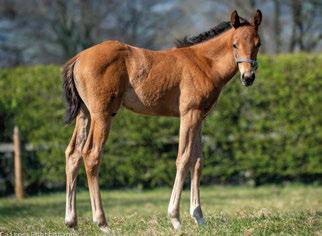

“We have been delighted with his foals so far, and crucially so are our breeders,” says Joe Callan, Head of Bloodstock and Sales at Whitsbury Manor Stud, which was associated with no fewer than around 65 mares in his first book. “We can say how impressed we are, but the true testament is he will cover a bigger book this year on the back of them and that’s a hard thing for a stallion to achieve in their second year.”
For Sophie Buckley’s Culworth Grounds Farm, the arrival of El Caballo – like Dragon Symbol, a high-class sprinter bred by Whitsbury Manor Stud – marked a first delve into stallion ownership. A tough
six-time winner whose career highlight came in the Sandy Lane Stakes, he shares his sire Havana Gold with Havana Grey, all of which likely helped drive a good first book of 100 mares. He’s supported by a commercial group of shareholders and has duly received the backing of successful breeders on both sides of the Irish Sea, which should stand him in good stead going forward.
With 251 mares in his first book, it was Prix Jean Prat winner Good Guess who was the busiest within this intake. Tally-Ho Stud have built up an enviable following among breeders, having previously launched the likes of Kodiac and Mehmas from a relatively humble level. Add in Good Guess’ race record, highlighted by a wide-margin win in the Prix Jean Prat over six other Group 1 winners, good looks (420,000gns yearling) and the fact he’s a son of the ever-popular Kodiac, and his popularity at an opening fee of €17,500 isn’t hard to fathom.
“He’s a very good-looking horse – there are a lot of people who remember him as a yearling,” says Henry O’Callaghan of Tally-Ho Stud. “And I think we’re seeing that come through in his foals. We’re hearing good reports from breeders on them and we’re delighted with the ones we have. They’ve got that strong, quality Kodiac look to them. Hopefully he can continue that Kodiac legacy.”
Over at Rathbarry Stud, hopes run high that Group 3-winning sprinter Bouttemont can do the same for Acclamation. At €5,000, the six-time winner offers breeders access to the same sire line responsible for Dark Angel and Mehmas.
‘I love a fast racehorse like Shaquille’
Charlie Budgett, Kirtlington Park Stud
“I’ve been very impressed with Dragon Symbol since the first time I saw him, and even more so now as we have a few belting foals by him. We supported him strongly last year with our own mares along with client mares, and we will be doing the same again this year.”
John Bourke, Hyde Park Stud
“I have two good El Caballo colt foals. They’re good, strong, correct types that look sharp and precocious. You’d think they’d be early.”
Peter and Michelle Morgan, Carmel Stud
“We have been very impressed by the first foals by Dragon Symbol, so much so that we have decided to send him two mares ourselves this year. He makes a lot of sense for us as yearling sellers, he covered a good book last year, and they look sharp –so hopefully we’ll be selling some nice yearlings on the back of his successful first runners.”
Dermot Cantillon, Tinnakill House Stud
“I love a fast racehorse and Shaquille was top of the class. We bred two top mares to him and have been rewarded with two exceptional fillies. We’ve also got a very good-looking colt by Ace Impact. One of our priorities at the Arqana December Sale last year was to purchase a mare in foal to him and we achieved our goal with Bird Of Paradise. There was great rejoicing when she produced a very forward-looking colt.”
Dwayne Woods, Brook Stud
“We’ve got an absolute belter of a Modern Games colt. He’s the best that the mare has had and as good as any foal we’ve had by a first-season sire. He’s a beautiful colt.”
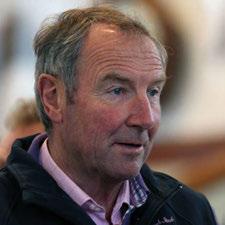
Bouttemont covered just over 80 mares last season. One breeder in a good place to gauge his prospects is co-owner Jack Cantillon of Tinnakill House Stud.
“Just looking at the foals coming out of the mares, Bouttemont is doing a great job of producing well put-together, strong horses with great bone and a lovely, athletic walk,” says Cantillon. “It’s very heartening to see that they’re inheriting the good looks of not only him but also Acclamation.
“We look forward to continuing the legacy of Acclamation with our friends and partners Rathbarry Stud.”
Speed is also a key selling point behind Castle Star, the recipient of over 90 mares in his first season at Capital Stud. The son of Starspangledbanner was a precocious two-year-old for Fozzy Stack, winning the Marble Hill Stakes and running second in the Middle Park Stakes. Supporters include
Peter Kavanagh, Kildaragh Stud (left)
“The young stallions that stand out for me on the evidence of their foals are Chaldean, Native Trail and Shaquille. We have two foals by each on the farm and they are all well above average.”
Ted Voute
“The Mishriff foals have good size and substance. They have a tremendous outlook and all seem to be a deep bay colour. No matter if the mare is small or big, he’s putting a lot of quality into his foals. They look exciting.”
Jerry Horan, who says: “They’re good sized, athletic foals with a good outlook. We’re delighted with them.”
First foals are also arriving for Dubai Mile and Marie’s Diamond, two high-class and tough horses.
Dubai Mile is new to Coolagown Stud in Ireland at €5,000 having commenced his stud career at Manton Park. The only son of Roaring Lion at stud, Dubai Mile won the Criterium de Saint-Cloud for Ahmad Al Shaikh and Mark Johnston, both of whom have supported the horse in years one and two at stud.
Al Shaikh so far has three foals on the ground by Dubai Mile, all of whom are out of stakes mares. They include Princess Salamah, dam of last year’s Group 3-winning sprinter Al Shabab Storm,
and the Group 1-placed Zghorta Dance. Johnston has sent his stakes mare Deirdre. Al Shaikh is on the record as confirming he’ll continue to support Dubai Mile at stud and in the sale ring, which could be good news for those breeders who have contributed to a rise in popularity for the horse at his new home with Davey Stack at Coolagown.
Meanwhile, if Marie’s Diamond’s foals have inherited any of his own durability, then they will be in a very good place going forward. The son of Footstepsinthesand won seven of 65 starts, including the Anglesey Stakes at two and a fast running of the Paradise Stakes at four, and stood his first season in 2024 for €6,000 at Diamond Stud Bellewstown.
and most commercial breeding stock sale

The Southern Hemisphere’s premier line up of breeding prospects with over 140 black type fllies and mares including seven Group One winners straight of the track. Mares in foal to superstar sires including Anamoe, Extreme Choice, Home Afairs, I Am Invincible, Too Darn Hot, Wootton Bassett and Zoustar.
GOLD COAST NATIONAL BROODMARE SALE | 27-28 MAY
Nancy Sexton Bloodstock Editor
One welcome aspect to recent yearling sales seasons has been the growing participation of American buyers.
Mike Ryan, working on behalf of Seth Klarman’s Klaravich Stables, really set the ball rolling at Tattersalls in 2017 when coming away with six yearlings worth 1,315,000gns. When two of them turned out to be Newspaperofrecord, the Breeders’ Cup Juvenile Fillies Turf heroine, and fellow Grade 1 turf scorer Digital Age, the floodgates opened.
Today, American buyers are enthusiastic supporters of European youngstock, particularly within the £100,000£300,000 range – a favoured area for Klaravich and sometimes a soft area of the elite market. Goffs went as far as to lay on a plane out of New York for buyers attending its Orby Sale in 2022; rewards were forthcoming when around 35 American-based interests made purchases.
However, any inroads into that market are now under serious threat due to the sweeping controversial US trade tariffs announced by Donald Trump in early April. The move triggered intense turbulence in the financial markets, although there was some relief not long after when Trump sanctioned a 90-day pause in the higher rate of ‘reciprocal tariffs’.
But anxiety still remains. The volatility prompted on a wider scale is likely to filter down into the racing industry. More immediately, it has also generated a potential trade barrier with ramifications for the market going forward.
Thoroughbreds are designated as ‘pure-bred breeding horses’ on the list of products that may fall under the tariff umbrella. That means in the worst case scenario horses carrying the ‘GB’ suffix are subject to a ten per cent tariff upon entry into the US and those carrying either ‘IRE’ or ‘FR’ are subject to 20 per cent. American-bred horses are classed as American goods and thus come in at zero.
It’s a situation that is understandably being monitored closely by the various sale companies, all of whom have strong ties to the US. For instance, the Tattersalls team made multiple trips to the US last year, which became worthwhile when American buyers upped their spend considerably at its October Sale.
Aware that American politics, especially

in the Trump era, remain ever fluid, the team are keeping a mindful eye on events.
“Tattersalls are maintaining a watching brief on US tariffs, aware that any changes could have wider implications for those buying and selling in the thoroughbred market,” says Jason Singh, Associate Director of Marketing at Tattersalls. “The burgeoning US turf scene has resulted in an increased demand for European yearlings. The best yearlings in Europe can be found at the Tattersalls October Yearling Sale which attracted significant numbers of American buyers in search of high quality European turf pedigrees, which we would anticipate continuing, even with the impediment of tariffs.”
He continues: “The success of graduates of the Tattersalls October Yearling Sale in recent years in North America has been remarkable and recent Grade 1 winners from the sale include Aunt Pearl, Digital Age, Domestic Spending, In Italian, McKulick, Newspaperofrecord and Program Trading. That success, in tandem with promotional visits made by Tattersalls representatives, resulted in more than 80 yearlings being purchased in 2024 at the Tattersalls October Yearling Sale for more than 10,000,000gns.
“Tattersalls will continue to spend considerable time and resource on the American market and would anticipate that there will still be significant demand for European pedigrees and those on offer at Europe’s premier yearling sale.”

In all, 117 British-bred and 304 Irish-bred horses were exported to the US in 2024. Over 1,600 horses have been imported from Britain and Ireland to the US in the past four years.
Of course, not every American buyer is going to send a purchase back to the US. Ireland, in particular, continues to attract US-based owners; look no further than major owner Peter Brant or the American ownership behind Porta Fortuna.
However, for a buyer such as Klaravich Stables, which maintains its powerful stable with Chad Brown in the US and spent 3,595,000gns through Mike Ryan at Tattersalls’ Book 1 Sale last year, the proposed tariff bill would obviously prompt a significant expense. The same could also be said of John Stewart’s Resolute Racing, whose pricey December purchases Excellent Truth (€1,600,000), Village Voice (1,300,000gns) and A Lilac Rolla (1,000,000gns) were each shipped to the US to continue their careers.
There is also the private market to consider. Working against the tide of woeful prize-money, many today operate with the residual value of a horse in mind, and plenty make this approach work. The American market has long been a friend to this sector, particularly when it comes to a promising filly. There is an argument to suggest that those playing at the top end will have enough of a margin to work with to absorb any additional costs. But for those below that, and there are plenty working away to source a promising nonwinner who can compete in the US with all its ‘conditions’, there might be some second thoughts.
This comes at a time when the breeding and sales industries are facing significant headwinds with the proposed EU transport regulations, which if implemented could force breeders to rethink how they operate. While the proposals primarily affect continental Europe, it would be naive to think Britain won’t be affected given the amount of business it conducts with Ireland, France and Germany.
As far as tariffs are concerned, Trump’s decision to place a 90-day pause on his plans did at least mean that the breezeup season escapes relatively unscathed. However, uncertainty remains for the rest of the year and that is a shadow we can all do without.
Some remarkable transactions carried this sale to a series of records and put it back alongside Arqana’s May Breeze-Up auction – for the time being at least – as Europe’s number one event of its type.
Turnover of just over 18.8 million guineas was up 29 per cent, the average gained 15 per cent at 158,017gns, while the median saw a rise of 25 per cent when reaching 100,000gns, figures that more or less matched those achieved at Arqana last year. It will be interesting to see how the figures stack up at Arqana in Deauville on Saturday, May 10.
Top-end lots gave this sale coverage beyond its usual horizons. A 1.4m gns Acclamation colt set a new record price on day one, but that was consigned to history 24 hours later when at the final session a son of Havana Grey made 1.75m gns. The valuation of each horse was the result of a battle between Sheikh Mohammed’s Godolphin and Kia Joorabchian’s Amo Racing and partners. Godolphin won round one, Amo levelled the score on day two and eventually became the sale’s leading buyer with seven purchases for a total of 3,160,000gns. Godolphin bought two lots for a combined 2,050,000gns.
No doubt the purchasers of the two seven-figure horses will be hoping for better luck than Godolphin experienced last year after buying the top lot, a 1m gns son of Galileo who was named Royal Officer, but who,


after a reasonable debut fifth, performed disappointingly on his next two starts for Charlie Appleby’s stable. He was recently resold for 75,000 dirhams at a sale in the UAE, a further sign that horse trading has its pitfalls, which makes success so sweet.
Fresh faces and new consignors appear every year and are always welcome, but this event showed that old hands are not to be written off. The Acclamation colt who topped the opening session was consigned by the venerable and much admired Willie Browne of Mocklershill, who had bought his Corduff Stud-bred horse
for €70,000 at the Goffs Orby Sale. Browne’s calm and often inscrutable exterior suggests a man unmoved by success, but on this occasion he admitted: “For an old man it’s a great feeling.”
He said he was hoping for a valuation of around the “500,000gns or 600,000gns mark” which shows that even the most sage and experienced minds can underestimate trade. It was also another sales-ring high for Rathbarry Stud’s Acclamation – a premier league sire with 155 stakes winners, but who died in December aged 25. His sons Dark Angel and Mehmas are current leading lights.
Official breeze-up timing has yet to arrive in Europe, but debate continues as to the merits of giving everyone that information, while recognising it would put pressure on vendors and their horses to achieve fast times. For now agents carry out their own timings.
Whatever systems they used on Newmarket Heath ahead of the sale, it seems everyone knew the Havana Grey colt consigned by another long-standing member of the breezeup community, Marlborough-based Malcolm Bastard, had presented a scorched-turf policy.
Alex Elliott, who fended off Godolphin interest on behalf of Amo Racing, acknowledged that Bastard’s reputation as a horseman who seeks the best for his horses, rather than the best time, made the Havana Grey particularly appealing, and said: “To do what he [the colt] did from Malcolm’s, when he doesn’t particularly train them for a time, shows you that he’s a good horse.”
Raphael Freire, who has moved into Sir Michael Stoute’s former yard at Freemason Lodge following its purchase by Amo Racing, was in line to take in the Max Weston-bred colt. Freemason Lodge “is the team’s base” said Elliott, although he added that long-term training plans for the Havana Grey still had to be decided.
It is eye-popping to think that the stallion’s current two-year-olds were bred off a fee of £6,000. It trebled the following year, more or less trebled again last year, but is now ‘private’, a lovely problem for his owners at Whitsbury Manor Stud.
Amo Racing’s other purchases included a 750,000gns son of St Mark’s Basilica consigned by Joey Logan’s Grangeclare, an operation consigning at the Craven for the

second time. Logan is best known for his dealings in jumping stock, and he represented successful racehorse owners Andy and Gemma Brown before their rapid exit from the sport with a wholesale dispersal at Tattersalls Ireland last year.
Godolphin added another string to its bow with the purchase of a 650,000gns Havana Grey colt consigned by Con and Amy Marnane’s Bansha House Stables, while Zhang Yuesheng’s Yulong operation dropped sizeable sums on colts by Too Darn Hot (550,000gns) and Mehmas (500,000gns). Yulong recently acquired the Dullingham Park stallions
C
C
C
F Havana Grey - Greach
C Starman - Spring Green
C Havana Grey - Ventura Jazz
Shaquille and Soldier’s Call from Steve Parkin, and both horses were signed for by Ben Hyde in the name of Dullingham.
Johnny Collins of Brown Island Stables sold the Too Darn Hot, a horse he bought for 90,000gns at last year’s October Sale Book 2 and who will join Jessie Harrington for the next stage of his career. The son of Mehmas, whose training plans were not divulged, had been a €50,000 foal purchase by Tally-Ho Stud.
After the final lot left the ring, Havana Grey had become the leading sire, his nine sold lots averaging 421,111gns, while the progeny of new stallions St Mark’s Basilica and Starman proved popular.
Two breezers by St Mark’s Basilica were sold for an average of 535,000gns, while Starman’s seven sold offspring, conceived at an advertised fee of €17,500, averaged 115,571gns.
Statistics
Sold: 106 (72% clearance)
Aggregate: 14,584,500gns (-5%)
Average: 137,590gns (+13%)
Median: 80,000gns (0%)
• The Tattersalls June Online Sale has undergone a slight tweak to the section for breeze-up two-year-olds.
Horses in that part of the sale will continue to breeze at Dundalk racecourse before the sale opens, but a one-year experiment which gave vendors the chance to breeze at Chelmsford has been dropped. A lack of uptake by British consignors is thought to be behind the decision.
The auction, a mixed catalogue with horses in and out of training and breeding stock in addition to breezers, was first staged in 2021 and enjoyed a marked growth spurt last year when offering 119 horses, 50 more than the previous high recorded in its opening year. Thirty-seven offered lots were breezers, with a top price of 27,000gns for a daughter of Coulsty.
Tradewinds Stud
Tally-Ho Stud
Church Farm Stables
Stroud Coleman Bloodstock
Blandford Bloodstock
Blandford Bloodstock
Twelve months ago this two-day sale was graced by a A$10m daughter of the great racemare Winx.
Yet even without such a celebrity trade boomed again, with turnover inching ahead of last year at slightly more than A$151m (£72.25m) despite 58 fewer yearlings being offered. The average price gained four per cent at A$448,000 (£214,359) while the median was up 20 per cent at A$360,000 (£172,250).
Perhaps Inglis was fortunate to stage this annual event early in April, for while Donald Trump’s tariffs were at that stage being handed out like hot potatoes – and Australian exports to the US had been hit by a ten per cent rise – global stock markets had yet to get the jitters which led to a sequence of falls and rises. Nor had the escalation in tariff-mania between the US and China engaged full gear. China is Australia’s biggest trading partner and Chinese mining billionaire Zhang Yuesheng is but one client no Australian bloodstock sales company would choose to lose.
In 2023 Zhang’s Yulong Investments spent A$12m at Inglis’s Easter Sale and A$33.5m at the Magic Millions National Broodmare Sale.
Yet despite worries hanging over many industries and in many countries, the resilience shown time and again in the bloodstock buying world was a feature at this sale, particularly at the top end where there were rises in the number of horses who made A$300,000-plus (208 compared to 191 in 2023), A$400,000-plus (155 up from 128) and A$500,000-plus (108 up from 96).
The race to be top lot ended on the first day when a Coolmore Studconsigned son of Home Affairs was sold for A$3m to Sydney trainers Gai

Waterhouse and Adrian Bott in partnership with Bruce Slade’s Kestrel Thoroughbreds. A first foal of the Group 1 mare Shout The Bar, the colt’s sale justified Coolmore’s purchase of his dam for A$2.7m at Inglis in 2022, the year in which Home Affairs, a son of I Am Invincible, completed his racing career before heading to Coolmore’s Australian base. A double Group 1 winner in his homeland, he finished well down the field on his swansong in Royal Ascot’s Platinum Jubilee Stakes.
Earlier in the first session, Coolmore had taken the position of buyer when Tom Magnier made a successful A$2.7m bid for a Snitzel colt offered from Arrowfield Stud, while on the second day his A$1.8m offer secured a son of I Am Invincible consigned by Segenhoe Stud on behalf of Winx’s breeder John
Camilleri. Trade at that second session was headed by a Zoustar filly who was sold to American John Stewart’s Resolute Racing for A$2.6m.
Whether Stewart was prepared to pay an additional $260,000 tariff fee to take the colt back to the US was not revealed at the time of the sale.
Arrowfield ended as leading vendor, selling 39 of their 42 horses for a gross of A$22,060,000, ahead of Coolmore and Widden, while Tom Magnier’s A$10,400,000 investment in seven yearlings saw him top the table of leading buyers.
Statistics
Sold: 337 (87% clearance)
Aggregate: A$151,015,000 (0%)
Average: A$448,116 (+4%)
Median: A$360,000 (+20%)
Goffs UK Aintree Sale Trade bounced back from some below-par figures at this sale last year.
Much of the improvement could be laid at the door of the weather, for while the 2024 staging took place amid weeks of rain – with some record quantities in parts of Britain and Ireland – leading to very deep ground or abandoned point-to-points on both sides of the Irish Sea, the spring of 2025 will be remembered as one of steady sunshine.
Humans are invariably searching for perfection, and quick ground regarded as too fast for some valuable young horses had slightly tempered what might have been perfect conditions. But with skilful watering at point-to-point courses, some good racing had led to a very decent Goffs catalogue.
This was highlighted by the sale of

the sole British point-to-pointer in the catalogue, four-year-old In A Sonnet, a son of Poet’s Word sold by Herefordshire-based Tom Lacey to Willie Mullins for £135,000. In A Sonnet had made a winning debut in a ten-runner maiden race at Maisemore Park in Gloucestershire five days before the sale, but he would have stayed in his box had the ground not been assiduously watered by former amateur rider Dave Mansell.
Of 30 horses to go under the hammer, 28 found a buyer and 17 sold for a six-figure sum, generating turnover of just over £3.5m, up 72 per cent. The average price returned to familiar six-figure territory after dipping below that benchmark last year, coming in at £127,536, a rise of 41 per cent. The median gained 40 per cent at £105,000.
The Flood family of Boardsmill Stud have in their midst another class stallion who is very much on the rise, and he featured heavily at this sale. Poet’s Word, who joined Boardsmill ahead of the 2020 covering season, has become very fashionable among traders and trainers, and three of his offspring hit six-figure money.
The top lot was a son of Poet’s Word in the shape of Largy Go, a four-year-old who scored for Stuart Crawford’s Northern Ireland stable the weekend before Aintree and was subsequently
• In 2023 there were ten specialist sales of point-to-pointers in Britain and just one in Ireland.
However, that sale run by Goffs at the Punchestown Festival has now been joined by three at Goresbridge and one at Tattersalls Ireland’s Fairyhouse complex. Goresbridge has added an ‘end of season’ sale of pointers and jumpers in training on June 4 to the April and November sales it introduced last year – albeit the November auction has been moved back into early December.
Tattersalls Ireland’s May Sale of stores has become one of pointers and horses in training.
The Goresbridge and Tattersalls Ireland sales will be welcomed by Irish vendors of pointers, who could not be expected to sell for six-figure money given that transport to Britain has become rather more expensive and complex than it was pre-Brexit.
Largy Go 4 g Poet’s Word - Jo Go
With Nolimit 4 g Bande - La Pampalina
Hernando De Soto 4 g Affinisea - Gouyen
Lultimatom 4 g Cokoriko - Vultip
Jonathan Fogarty
Coolmeen Stables (Ellmarie Holden)
Kingsfield Stud

knocked down for £305,000. JP McManus bought the gelding, who will be trained at Jackdaws Castle by AJ and Jonjo O’Neill.
Gordon Elliott’s quest for success can be witnessed at virtually every sale of point-to-pointers and horses in training, and he and his clients picked up a pair of four-year-old pointers who each made £250,000. Both Lemmy Caution and With Nolimit had won their sole race before being offered for sale, as had Hernando De Soto, who joined Elliott with a valuation of £230,000.
Willie Mullins, who two days after this sale saddled the one-two in the Randox Grand National and subsequently retained his British trainers’ title, added to his string with the purchase of Lultimatom for £225,000, while Ian Ferguson and Jerry McGrath each purchased horses for £200,000.
Ferguson secured Minella Marathon for leading owner of jumpers Ronnie Bartlett, while McGrath’s winning bid had landed on She’s A Fair Maid, who he said was set for a berth at Nicky Henderson’s Seven Barrows.
Statistics
Sold: 28 (93% clearance)
Aggregate: £3,571,000 (+72%)
Average: £127,536 (+41%)
Median: £105,000 (+40%)
Gordon Elliott
Gordon Elliott
Aidan O’Ryan/Gordon Elliott
Harold Kirk/Willie Mullins
Twelve months ago this sale was affected by weeks of rain resulting in going that would suck size 11 waders off size 12 feet.
Fast forward to this year and the demand has been not for drainage but watering at point-to-point courses on both sides of the Irish Sea. That enabled the vast majority of spring meetings to take place and some decent young horses were able to show their paces and then head to this auction, although cautious trainers will have held back a number of backward prospects for a run in the autumn.
In terms of this sale, the last of the year at Tattersalls Cheltenham, the result was a bigger catalogue with an additional 13 lots entering the ring. That led to a hefty rise in turnover, but pleasingly there were also gains in the average price, which rose 11 per cent to £66,590, and in the median, which was up 20 per cent at £50,000.
Half a dozen geldings made a six-figure sum, emphasising the passion that wealthy folk have for prospective high-class young jumping horses.
The Doyle family of Monbeg Stables are key traders in this market, and one of their number – the fifth of nine siblings – offered a once-raced son of Crystal Ocean who headed trade when selling for £205,000.
• Richard Botterill’s tragically early death at the age of 60 in February has deprived Tattersalls Cheltenham of a trusted and widely-respected auctioneer.
However, at the company’s April Sale another familiar pair of lungs picked up the microphone and gave the occasion his own trademark style, one heard regularly in Newmarket over the years, but never at the home of jump racing. Not that Ollie Fowlston showed any uncertainty on this slightly unfamiliar territory.
Over the previous two days he had been on more familiar ground while sharing auctioneering duties at the Tattersalls Craven Breeze-Up Sale, his first at a bloodstock auction since returning to Tattersalls after a two-year stint as Managing Director at Dullingham Park in Newmarket
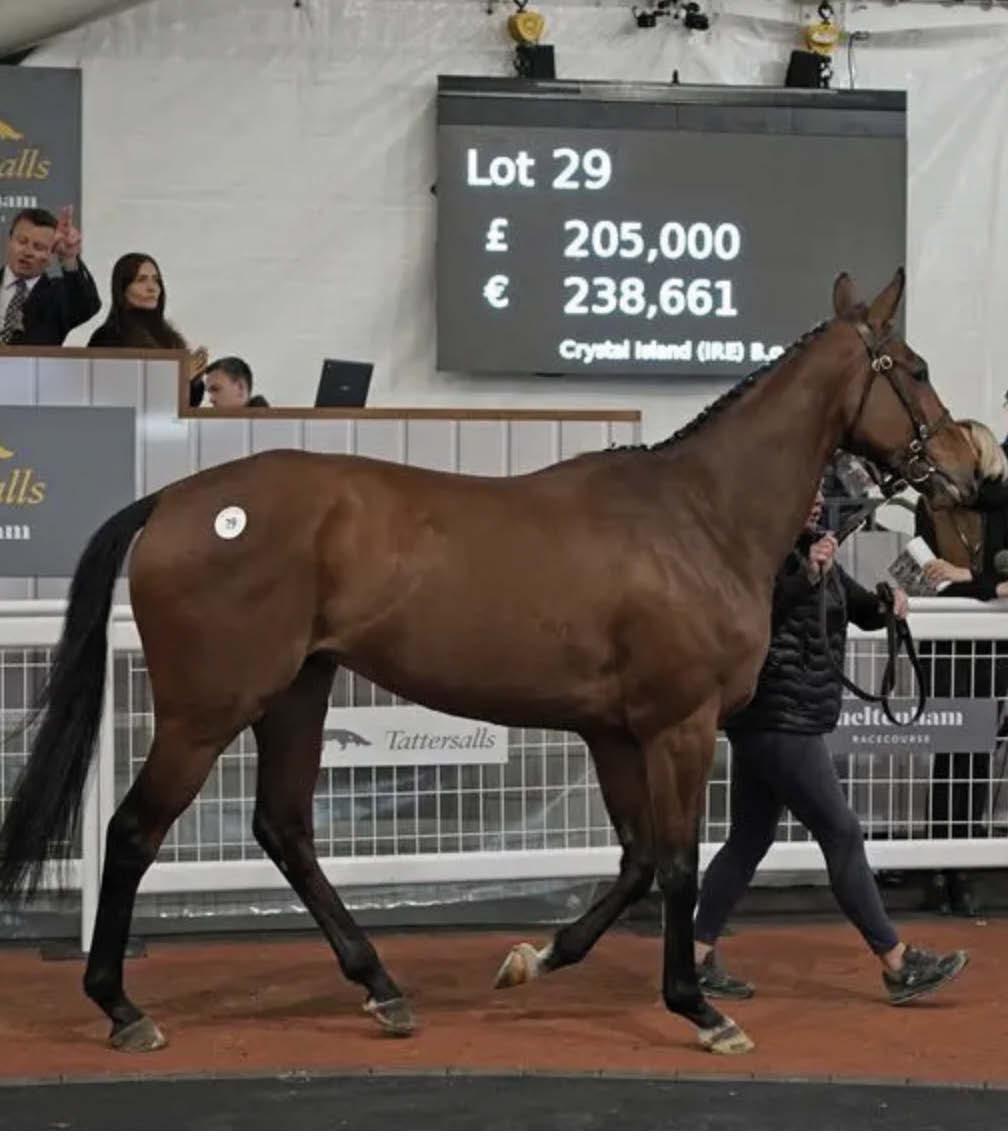
while it was under the ownership of Steve Parkin.
Early last month, it was announced that Fowlston had rejoined Tattersalls where he will, according to a press release from the company, be undertaking “yearling and other inspections as well as other client relations-based activities on behalf of the Tattersalls Group”.
Whether those activities will include afternoons spent on wet and windy Irish point-to-point courses in the depths of winter is unclear, but he will be very welcome at any British point-to-point.
• Tattersalls has given its spring sales of jumpers and jumping stock a revamp. The company has dropped its Tattersalls Ireland May Sale of store horses but retains its auction of horses-in-training and point-topointers which was introduced last year.
Tattersalls has also dropped its Cheltenham May Sale, presumably hoping horses that would have been offered – at least from Irish vendors – will reroute to Fairyhouse for the auction referred to in the previous paragraph. Given that horses on offer in early summer are just below the best, an opportunity to cut transport costs and logistics makes sense.
Whether the changes will have any impact on Goffs UK’s important Spring Sale will be of interest. That mid-May auction in Doncaster may benefit from greater interest in its stores’ session, and it could gain a few extra British pointers and bumper performers who would otherwise have been offered at Cheltenham.
On the other hand, some Irish in-training horses and pointers could now stay at home and head to Fairyhouse.
Nothing new in a Doyle selling a top lot, but Eamonn has broken ranks this year and created his own operation called Mossy Fen Stables, although it is based on the family farm.
His very first attempt at selling under his new banner proved an outright success, for four-year-old Crystal Island, who he had bought for €60,000 as a store and then saddled to victory in a maiden point-to-point, was the horse who took centre stage at this sale. Jerry McGrath was in pole position when the hammer fell, and he subsequently revealed he was acting for park home entrepreneur Tony Barney, the owner of this year’s Arkle Challenge Trophy winner Jango Baie. Like that horse, Crystal Island will be trained by Nicky Henderson.
Given that Henderson trains brilliant hurdler Constitution Hill, who finished second on his sole start in an Irish point-to-point, he might have had one eye on The Irish Avatar, who took the runner-up spot in a similar race ten days before the sale. Instead it was the almighty Willie Mullins who secured the son of Poet’s Word following a bid of £200,000 by Harold Kirk. Vendor Colin Bowe, who owned a half share in the horse – one he bought for €100,000 as a store –


pointed out that his horse was big and raw, would improve plenty and had been beaten by a more forward type on his maiden voyage. That forward type, aka Ballycommon Boy, a son of Harzand who has since joined trainer Olly Murphy following a private sale, is undoubtedly one for notebooks.
Bowe also netted £150,000 when Eddie O’Leary made a successful bid for winning point-to-point debutant Unflinching, who will join Gordon Elliott, while Paul Nicholls gained three new recruits who were all knocked down to Highflyer
Bloodstock’s Anthony Bromley. Looking on was Tom Malone, who until recently had been Nicholls’ key buyer at auctions of jumpers, but Bromley is not unknown to the Ditcheat trainer, having some years ago sourced such giants as Kauto Star and Big Buck’s for the yard.
Bromley’s buys included a pair of horses from the British point-to-point
Crystal Island 4 g Crystal Ocean - Je T’Aime
The Irish Avatar 4 g Poet’s Word - Dinaria Des Obeaux Milestone Stables (Colin Bowe)
Unflinching 4 g Montmartre - Kapirovska
Karaka De Thaix 4 g Cokoriko - Verka De
Milestone Stables (Colin Bowe)
Thaix Manor House Farm (Dale Peters)
Iconic Walk 4 g Walk In The Park - Iconic Mystery Monbeg Stables (Cormac Doyle)
circuit – “they offer good value” he said – namely the Dale Peters-trained five-year-old Karaka De Thaix and four-year-old Outmaster from Gina Andrews’s Warwickshire stable. The first-named horse, a £13,000 store purchase at the 2023 Goffs UK Spring Store Sale, was knocked down for £135,000, reaping a proper profit for Huntingdon-based Peters and his good friend Toby Hunt.
Outmaster was sold for £90,000, while Bromley topped up Nicholls’ orders with the £110,000 purchase of Kilnew Supreme, runner-up to sale-topper Crystal Island when both horses made their debut.
Statistics
Sold: 39 (78% clearance)
Aggregate: £2,597,000 (+55%)
£66,590 (+11%)
£40,000 (+14%)
H Kirk/W Mullins
Gordon Elliott Racing
Highflyer Bloodstock/P Nicholls
Hamish Macauley Bloodstock
As Group 1 racing in Sydney comes to a close for another season, it is a good time to review the two-year-old division in Australia while bearing in mind that we still have one more Group 1 – the JJ Atkins in Queensland won last year by Too Darn Hot’s son Broadsiding – to be contested next month.
Ranked by Timeform ratings, the juvenile hierarchy actually provokes more questions than it provides answers, even more so than in a normal season as the top-rated horse, the Wootton Bassett colt Wodeton, owned by the Coolmore partners, hasn’t won a race since January when he broke his maiden first time out at Rosehill over 1,100 metres. So even though not a stakes winner, he is considered to have put up the best performance of any youngster when just failing to peg back the Snitzel filly Marhoona in the Group 1 Golden Slipper Stakes.
For that effort, giving the filly 2kg, Timeform awarded Wodeton a rating of 121, which tops the log at present. The A$1.6 million yearling purchase then contested the Group 1 Sires’ Produce Stakes over 1,400 metres at Randwick, a race considered more suitable to his attributes, but finished only fourth.
Wodeton is not the only non-stakes winning Group 1-placed two-year-old from the first Australian crop of Wootton Bassett. Also on our list is the 113-rated State Visit, who finished two places ahead of Wodeton in the Sires’ Produce and then followed up with a
fourth in the Group 1 Champagne Stakes.
Wootton Bassett may not yet have registered a first stakes winner from his Australian crops, but he is away to a very exciting start. Besides Wodeton and State Visit, he also sired a pair of Group 2-placed youngsters in West Of Swindon (TF104+) and Wiltshire Square (TF101), plus two more Listed-placed juveniles. That makes it six stakes horses from his first 18 runners, producing a massive strike-rate of 33.3 per cent, which would be the best of
“Wootton Bassett is away to a very exciting start in Australia”
any freshman sire in Australia this century should it stay that way until the end of the season.
Interestingly, although it remains far too early to be conclusive, Wootton Bassett’s stakes horses are split five to one in favour of his colts, which mirrors what is happening in Europe where he has sired 69 male stakes horses and 29 fillies/mares. Looking ahead, it is very
much in Wootton Bassett’s favour that Wodeton is out of an Exceed And Excel mare while State Visit is from a Redoute’s Choice mare – there are plenty of high-class mares by this pair in the Australian population.
The Golden Slipper Stakes heroine Marhoona (TF117) is the third Slipper winner for her sire Snitzel following Shinzo and Estijaab. A four-time veteran champion sire with 156 (10.3 per cent) stakes winners, Snitzel also has four two-year-old Premierships to his name and this season will in all likelihood be his fifth so rich is the Golden Slipper. He leads the way with over A$4 million in earnings from 23 runners, including 11 winners and two stakes winners.
For context, it should be noted that Australia stages comparatively fewer juvenile races than Europe. Last season there were only 632 races for two-yearolds, or 3.3 per cent of the total, compared with 2,334 or 14.4 per cent of the total in Europe. This is why the numerical achievements of juvenile sires fall below their European counterparts.
Nepotism, the Champagne Stakes winner, is the next top-rated on 116. This colt, who ran third in the Group 2 Todman Stakes on debut behind Tentryis and Wodeton, picked up the 1,400 metre Group 3 TL Baillieu Stakes on the way to his Champagne success. He is by the New Zealand-bred O’Reilly stallion Brutal, who numbered the famous Group 1 Doncaster Handicap among five victories from ten starts. Based at Newgate Stud, Brutal has sired just two stakes winners from two crops and Nepotism is his first at Group level. It is Newgate Stud’s Extreme Choice who supplied the first Group 1-winning two-year-old of the season in Devil Night, winner of Victoria’s sole topflight contest for two-year-olds, Caulfield’s Blue Diamond Stakes. Himself a Blue Diamond winner in a short eight-race career that also produced a victory in the Group 1 AJ Moir Stakes at three, Extreme Choice’s stud career has been numerically curtailed by poor fertility but he has compensated brilliantly by siring plenty of quality, so much so that there is no current sire in Australia or New Zealand that can match his 11.9 per cent stakes winners to runners. His CV uniquely contains winners of Australia’s two most

iconic races, the Golden Slipper Stakes and Melbourne Cup. How is that for diversity?
Apart from Wootton Bassett and I Am Invincible, the only other sire with two representatives among the top 15 juveniles is Darley veteran Street Boss, who has been doing sterling work in recent seasons through the likes of six-time Group 1 winner Anamoe. Alongside Pride Of Dubai (who currently heads the Australian Premiership), Shocking and Per Incanto, he is doing plenty to showcase the merits of the Street Cry sire line in Australia.
Street Boss’ daughter Tempted
(TF114) won the Group 2 Reisling and Group 2 Percy Sykes Stakes and was placed third in the Golden Slipper in between. Tentyris, meanwhile, defeated top-rated Wodeton and Group 1 winner Nepotism in the Todman Stakes, having previously been an unlucky runner-up in the Blue Diamond Stakes.
In recent years, Street Boss has really benefitted from top mares owned by Godolphin, and it is hardly surprising that both Tempted and Tentyris are out of mares by his stud companion Exceed And Excel. Street Boss has had 48 runners from Exceed And Excel mares so far and has sired seven Group winners from them at an impressive
rate of 14.6 per cent. There will be plenty more in the pipeline.
For all his achievements and they are considerable, three-time champion sire I Am Invincible had never sired a juvenile Group 1 winner in Australia before his Timeform 114-rated son Vinrock won this season’s Sires’ Produce Stakes. Now unbeaten in three starts, Vinrock became the first horse since 1981 to win both ATC and VRC versions of this race. He defeated a stellar field at Randwick including Wodeton and Too Darn Hot’s Rivellino and has since been snapped up by Yulong – he is already a ready-made stallion prospect.
It is easy to become wrapped up in the commercial aspect of the business but owner-breeders remain very much the backbone when it comes to class. That is despite a seemingly dwindling number of such operators, sadly not a surprising development if the expense and length of time required to cultivate a successful stud is taken into account.
Thankfully a number of them look on track for a good season if the early British Flat action is any indication.
In Feilden Stakes winner Almeric, Kirsten Rausing appears to have unearthed another Classic candidate, one who may attempt to emulate the victory of his sire Study Of Man in the Prix du Jockey Club. Foaled when his Listed-winning dam Alvarita was 20, he is yet another talented member of Rausing’s Alruccaba family and inbred to Alzao, a pattern he shares with one of Deep Impact’s first good European representatives, Group 3 winner Aquamarine.
Prince AA Faisal was also on the mark at Newmarket’s Craven meeting as the owner-breeder of Abernant Stakes winner Sajir. The colt is one of four stakes winners
by Make Believe bred by the Prince’s Nawara Stud, in whose colours the stallion won the Poule d’Essai des Poulains; the best of the quartet is champion Mishriff. In addition, Sajir is out of a mare by Invincible Spirit, another bred and raced by the Prince. Similarly, his Nell Gwyn Stakes third Remaat represents the fusion of two high-class Nawara horses, being by Kodiac out of an Olden Times mare.
It was also a remarkable few days for Juddmonte Farms, starting with Better Together’s success in the Prix Imprudence at Deauville. By veteran Juddmonte stallion Oasis Dream, who also supplied the second home Ghoufrann, she belongs to the Peace family that has been such a Juddmonte mainstay since its incorporation during the early 1980s following the death of John ‘Jock’ Hay Whitney. The acquisition, for which trainer Jeremy Tree was influential, gifted the operation with its Rockfest line responsible for Frankel and now Jonquil, who looked a Guineas colt when taking the Greenham Stakes at Newbury for Andrew Balding.
Lope De Vega’s son Jonquil, who is the first foal out of the Listed-placed Jovial, is
fancied to emulate Frankel’s win in the 2,000 Guineas, where he could meet Juddmonte’s Craven Stakes winner Field Of Gold. There is also the well-regarded Cosmic Year, a Kingman colt from the Lost Virtue family who made it two from two in impressive style at Kempton, to consider.
Meanwhile, Juddmonte’s hand within the fillies’ division was further strengthened by the win of Zanzoun in the Nell Gwyn Stakes. The Dubawi filly is the first foal out of Lyric Stakes winner Franconia, a half-sister to Nassau Stakes heroine Winsili from Juddmonte’s Suntrap family.
As is generally typical of Juddmonte, Zanzoun, Jonquil, Better Together and Cosmic Year are products of those older established families cultivated for over four decades. In the case of Field Of Gold, he represents the fresher strategy of selectively adding new blood, an approach which has reaped dividends in recent years through 2,000 Guineas winner Chaldean, a foal purchase, alongside the champions Arrogate and Elite Power in the US.
In the case of Field Of Gold, he was one of the highlights of the 2022 Goffs November Sale when purchased for
The Wildenstein family’s lengthy association with the turf was a colourful one that brings to mind numerous champions, among them four homebred winners of the Arc.
Yet thanks to the input of Sylvia Wildenstein, widow of Daniel, the name also flows ever more strongly within jumps breeding. The source in this instance is Newness, an accomplished jumper whose dynasty ranges from her son, the leading jumps sire No Risk At All, to the current high-class hurdlers Murcia and Nara. Indeed, the reach of this line was very much on show at Aintree’s Grand National meeting at which Murcia, a Doctor Dino great-granddaughter of Newness, won the Grade 1 Anniversary Novices’ Hurdle and No Risk At All sired the Grade 1 Top Novices’ Hurdle winner Salvator Mundi. Both horses are trained by Willie Mullins.
No Risk At All has swiftly become one of the most desirable National Hunt sires
for Haras de Montaigu. Salvator Mundi is his second Grade 1-winning novice hurdler of the season following Kopek Des Bordes, who had Salvator Mundi back in fifth when maintaining his unbeaten run in the Supreme Novices’ Hurdle at the Cheltenham Festival. His win continued an excellent record for No Risk At All at the meeting, which is headlined by 2020 Champion Hurdle heroine Epatante and dual Ryanair Chase scorer Allaho. Well regarded on both sides of the Channel, presumably the son of My Risk is in strong demand with breeders again this season at a career-high fee of €20,000.
No Risk At All was the penultimate foal out of Newness and helped bring her stud career to a fine close by winning a pair of Flat Group 3s, the Grand Prix de Vichy and Prix La Coupe, for Sylvia Wildenstein and trainer Jean-Paul Gallorini. Best when the mud was flying, he was one of no fewer than eight black-type horses out of the mare.
Newness was Wildenstein-bred top to bottom as a daughter of Simply Great and Neomenie, the 1982 Prix La Perichole Steeplechase winner whose wider reach also takes in John Hales’ excellent chaser Politologue.
Simply Great was one of the big hopes for Daniel Wildenstein and Sir Henry Cecil during the early 1980s. Such was his home reputation that the Mill Reef colt was among the favourites for the 1982 2,000 Guineas before he had even run. Although he never made it to the Classics, he did land the Dante Stakes before soundness issues intervened. He retired to stud in Ireland in 1985 just months before his younger half-brother Sagace won the Arc; neither sibling would leave much of a mark at stud, with Simply Great’s current prominence more or less owed to the exploits of Newness.
Newness won four races under the care of Gallorini including the 1992 Prix Edmond Barrachin Handicap Chase at

€530,000. Of course, no operation would be more in tune with the capabilities of Kingman than Juddmonte. They would also be keenly aware of the depth of his female family, which represents several generations of cultivation by Bobby and Honora Donworth’s Roundhill Stud.
As with plenty of this family, Field Of Gold is grey, his colour most likely stemming from the presence of Unbridled’s Song as the sire of his granddam Princess Serena.
Princess Serena was bred in the US by Arthur Appleton’s Bridlewood Farm although she ran in Britain for Brian Meehan, for whom she showed limited form. She duly wound up back in the US but was back on her travels not long after when picked up by Roundhill for $150,000
Auteuil. However, her race record pales into comparison with her stud career. Her second foal, the Marignan filly N’Avoue Jamais, won the 2000 Prix Alain du Breil at Auteuil and is now a major producer in her own right as dam of the high-class French jumpers Nickelle and N’Oublie Jamais. In turn, Nickelle is the granddam of Nara, a daughter of Glenview Stud’s recent recruit Jeu St Eloi who was last seen winning a Grade 2 novice chase at Thurles in January for JP McManus. Newness’ third foal, meanwhile, was the Linamix gelding Nom D’Une Pipe, who defeated Bilboa to take the 2001 Prix Sageris at Auteuil.
She clicked particularly well though with Daniel Wildenstein’s 1993 Grand Criterium winner Lost World, a son of Last Tycoon to whom she produced Prix Wild Monarch Hurdle winner Narkis, Grand Prix de la Ville de Nice Chase winner Nom De D’La and most importantly Nickname, an excellent chaser for Martin Brassil whose five-race winning sequence during the 2006-07 season included the John
at the 2003 Keeneland November Sale.
Princess Serena had plenty to recommend her on pedigree, being out of a sister to champion Serena’s Song, whose 11 Grade 1 wins for D Wayne Lukas included the Oak Leaf Stakes at two and the Haskell Invitational over colts at three. The daughter of Rahy also became a remarkable producer as the dam of six stakes winners including Coolmore’s Coronation Stakes heroine Sophisticat, one of the first examples of the global versatility of this family.
Princess Serena has also done plenty to extend the line’s influence on turf in Europe since. She was particularly effective with Shamardal (which produces inbreeding to Rahy), to whom she foaled Australian Group 2 winner Puissance De Lune and

Durkan Memorial Chase at Punchestown and Paddy Power Dial-A-Bet Chase at Leopardstown.
Nickname was a bit of a rarity in Ireland as an entire mixing it with the best over jumps. He died young at stud and in hindsight was a major loss given that his three crops, none of which were particularly big, contained jumpers of the calibre of Frodon and Cyrname.
Middleton Stakes scorer Queen Power. To Shamardal’s son Lope De Vega she also foaled 2019 Prix d’Ispahan winner Zabeel Prince.
Her first foal, Serena’s Storm, has also added her own chapter as the dam of the Roundhill-bred Moyglare Stud and Coronation Stakes winner Rizeena and Dubai Group 2 scorer Summer Romance – like Field Of Gold, a grey Kingman.
Field Of Gold’s dam, Princess De Lune, is a sister to Puissance De Lune and Queen Power, and looked set for a black-type career herself when winning her debut, a division of the traditionally competitive Bridget maiden at Newbury, in the spring of 2017. As it turned out, she didn’t win again in three further starts but is more than making up for it at stud; Field Of Gold is her third foal and follows the Oasis Dream filly Zanbaq, a Listed winner for Shadwell, and 83-rated winner Lunar Eclipse. Now an 11-year-old, Princess De Lune has a yearling filly by Ghaiyyath and was covered by Too Darn Hot last year.
As for Roundhill Stud, it also has another branch of this family serving them well in Pure Symmetry, a Storm Cat sister to Sophisticat – and therefore daughter of Serena’s Song – who was purchased for $230,000 at Keeneland in January 2015. That mare is the dam of King’s Gambit, who could be a force for Wathnan Racing and Harry Charlton as a four-year-old this year having been Group-placed on multiple occasions last season.
Thankfully, No Risk At All has picked up the baton.
As for Murcia, she descends from Newness via her classy Flat daughter New Saga, who ran fifth to Divine Proportions in the Prix de Diane before gaining black-type over jumps. Bred by Sarl de Chambure Haras d’Etreham et al, Murcia is the first foal out of Belle Et Chic, a placed daughter of the top dual-purpose sire Poliglote, and has the makings of an important broodmare of the future for her owner Kenny Alexander, whose Scottishbased New Hall Stud of course also houses Honeysuckle.
Newness died at Haras de Victot in 2018 at the grand age of 30. When Sylvia Wildenstein’s bloodstock holdings were dispersed at Arqana in February 2012, the 11 horses belonging to the line realised over €400,000. Over a decade on and her tremendous legacy continues to blossom, its aptitude for jumping and regular output of class making it one of the most elite and desirable families within its field.
A range of options to suit diferent temperaments and degrees of gastric sensitivity
All designed to support condition, top line, growth & development Proven
reduced starch
PREP-EASE
13.5 MJ/kg
18% starch
15% protein

STUD & YOUNGSTOCK CUBES
13 MJ/kg
23% starch
15% protein


PREP MIX
13.5 MJ/kg
30% starch
15% protein

STUD & YOUNGSTOCK MIX
12.5 MJ/kg
32% starch
16% protein


Words: Laura Steley
With the first European yearling sale of the year kicking off at Arqana in mid-August, our attention will soon be drawn to sales preparation. Nutrition is fundamental to the prepping period and has the potential to impact all aspects of your prep regime, including sound growth and development, exercise tolerance and behaviour/temperament.
Louise Scott, Registered Nutritionist at Dodson & Horrell, says: “Successful preparation requires a balance of growth management, nutrition and conditioning to have horses that present well and remain healthy, where skeletal development and future soundness is not compromised.” It cannot be denied that luck has a part to play, which is often the underpinning factor of yearling sales headlines and stories of outstanding pinhooking success.
The preparation of yearlings for
sale can be subjective; the desired body condition will be dependent on various factors such as the individual’s conformation, foaling date, pedigree, and current buyer preference. We must never forget that sales preparation
“Preparation starts back at conception, not eight weeks before the sale”
starts right back at conception, not eight weeks before the intended sale. Proper attention to correct nutrition throughout the foal to yearling stage should result in a well-grown youngster with sufficient muscle and condition
to progress smoothly into sales preparation.
At 12-15 months of age, the typical yearling should have achieved 90% of its mature height, 95% of its bone length, and 75% of its adult weight. Growth rates may now be slower (0.450.5kg per day) but it is still a critical phase in the horse’s athletic life. The ultimate goal during this period is to provide the yearling with the necessary nutrients for healthy growth and development without providing such an excess of calories that the yearling becomes too heavy, coupled with an unnatural growth rate.
Up to this point, a thoroughbred yearling has led a relatively easy life being turned away in a herd since weaning, with sales preparation usually beginning around two to three months before the intended sale. The change from living out in a herd environment to being stabled for varying amounts
daily will impact stress levels that could negatively influence growth, behaviour, and digestive health.
Decreased turnout will also mean reduced access to forage via pasture. Liz Bulbrook, Director of Nutrition at Baileys Horse Feeds, explains: “Increased amounts of hay or haylage should be offered in order to maintain gut health and function, relieve boredom and prevent stereotypical behaviour, like cribbing and windsucking. Ideally, forage intake should be equivalent to a minimum of 1.25% - 1.5% of bodyweight and will contribute to the youngster’s energy intake by providing fermentable fibre and non-heating calories.”
Good quality forage is essential and although it will not solely provide enough energy, protein, vitamins and minerals for a yearling during the prep period, it should still be at the forefront of your nutritional regime. Scott agrees, saying: “Forage should create the foundation of any good feeding program and when preparing youngstock for the sales it is important that they have access to good quality pasture and/or conserved forage.
“Good quality roughage provides essential fibre for gut health along with being a source of protein, vitamins and
minerals to support healthy growth and development.”
The backbone of any feeding regime is gastro-intestinal health. Optimum utilisation of hard feed is dependent upon a healthy gut microbiome which relies on sufficient quality forage.
Louise Jones, Nutritionist at Connolly’s RED MILLS, echoes this thought. She says: “The nature of sales preparation –changes to diet, increased exercise and stress – can all contribute to reduced digestive health. This is not good news as any adverse change to the gut microbiome can decrease the efficiency of nutrient absorption. This can cause issues such as weight loss or digestive problems including loose droppings or colic, reduced appetite, and supressed immune function. Therefore, during the intense sales prep period, adding a supplement that promotes healthy gut function is a wise investment.
“The best ones combine multiple ingredients such as post-biotics, prebiotics, B-vitamins and gastric buffers. One such supplement is NutriGard, which has recently come to the fore following a study showing that supplementation mitigated against hindgut acidosis.”
By ensuring access to high quality, readily digestible fibre in the diet, it
will help to reduce the need for large portions of hard feed to maintain condition. It will also help keep excitable behaviour under control whilst ensuring a sufficient amount of chewing. The best and most readily available forms of fibre are alfalfa and soaked beet pulp. Bulbrook adds: “The more digestible the forage, the lower the risk of ‘hay belly’. If the nutritional quality of the forage is in question, an alfalfa chaff can be fed to help raise the overall protein and fibre content of the diet.
“Chewing is a stimulus to producing saliva, which is a natural buffer to the acids produced and required by the stomach for digestion, thus reducing the risks of ulcers through excess acid production. The horse has a psychological and physiological need to chew, so meeting these needs is paramount when we start bringing in and preparing for sales.”
Feed changes should go hand-in-hand with increased exercise. It is good practice to review the yearlings’ feed and exercise programme every two weeks. The rule ‘little and often’ is an apt approach. Bulbrook advises: “The yearling does not need to come in ››





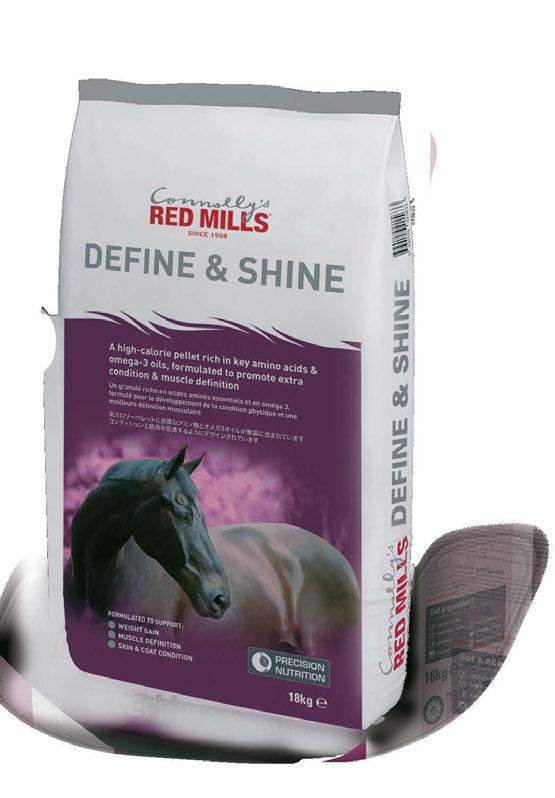
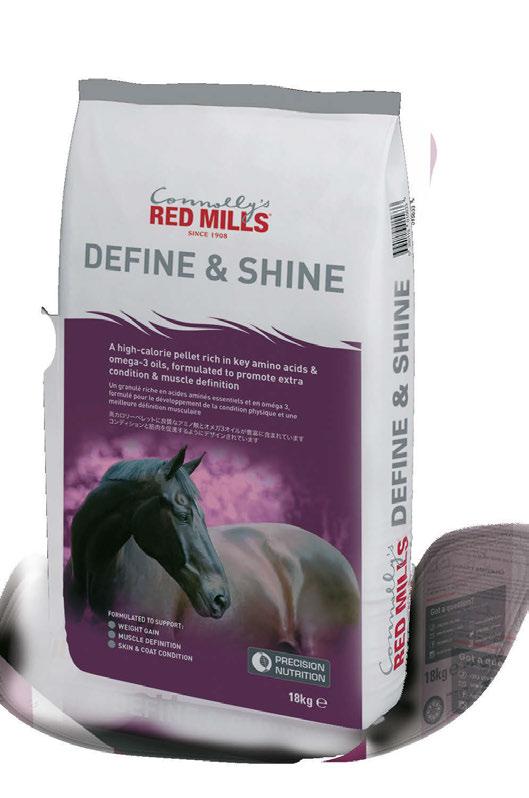


›› from a predominately pasture- based diet and immediately switch to a full yearling prep diet; it needs to be gradual and in moderation. Stepping up, for example, from a reduced calorie diet of balancer plus forage to moderate calorie diets using a combination of balancer plus higher calorie prep feed at perhaps one or two bowls per day, then moving to more prep feed of medium to high calories in line with increased workload and exercise.” This approach will help reduce excessive glycaemic response and avoid starch overload.
High carbohydrate or starch meals are thought to affect a horse’s usual hormonal responses to digestion. This can interrupt the conversion of cartilage to bone, so when feed quantities need to be increased, upping the number of meals per day from two to three, or even four, is very beneficial.
A low-starch, high-fat feed is significantly more advantageous for many reasons. The horse’s digestive system is much more efficient at breaking down fat than starch, and you will often need to feed a higher quantity of grains (corns or oats) to achieve the same calorie intake compared to fat (oil or rice bran). Feeding large amounts daily greatly increases the risk of equine gastric ulcer syndrome (EGUS), particularly when coupled with limited forage and/ or turnout. High starch intake can also increase the risk of diarrhoea, colic, laminitis, and behavioural issues such as over-exuberance.
Scott explains: “Concentrate feeds are commonly added to meet higher energy and nutrient demands to achieve a prime sales appearance of muscle and topline.” The amount of concentrate feed a yearling is receiving will often double or triple during the prep period. Any concentrate feeds produced specifically for thoroughbred youngstock should have the correct vitamin to mineral ratio – supplementation can be risky as they need to be balanced correctly; a toxicity can occur if too much is fed, while nutrient absorption can be inhibited.
Scott says: “The level of energy in the diet is especially important – it should be sufficient to support development and healthy condition, but not excessive to avoid overly rapid growth. If young horses have an excess of energy in the diet leading to rapid condition gain, particularly if fed a high-starch diet, it increases

the risk of growth problems such as developmental orthopaedic disease. This is also why it is important to plan preparation correctly; provide enough time for horses to develop gradually instead of rapidly trying to boost condition as the sales date approaches, choose a feed that provides the right level of energy with a low- moderate starch content to minimise the risk of growth problems, and closely monitor weight and body condition during the preparation period so adjustments can be made if necessary.
“Any reduced intake of forage through stabling or poor grass availability can be augmented by enduring plenty of fibre in the concentrates.”
Ensuring protein requirements are met is also a very important component in helping to achieve the desired yearling development and soundness. The most noteworthy amino acid for our yearlings is Lysine, which is supplied in its most optimum form via soy.
Scott advises: “Quality protein that supplies adequate key amino acids, particularly Lysine, is crucial for healthy muscle development in young horses, particularly during sales preparation to have horses that are well muscled with adequate topline. Feed ingredients such as soya are rich in quality protein and some stud feeds include additional amino acids to ensure the diet is sufficient.”
Jones adds: “Protein, which is made up of amino acids and often referred to as the building blocks for muscles, is essential when it comes to developing topline. Some amino acids are described as ‘essential’ as the horse
cannot naturally produce them, and so they must be supplemented in the diet. Most yearlings should receive optimum levels of quality protein from their feed.
“However, those that are of an immature body type at the start of sales preparation or have suffered from an illness prior to or during the prep period can benefit from a protein supplement, preferably one containing hydrolysed [effectively pre-digested] plant protein, such as Foran Equine Muscle Prep.” Alongside protein, antioxidant requirements are also crucial during this period of development and change. The most noteworthy are vitamin E, selenium and ideally vitamin C.
Jones explains: “A glossy, shiny coat is a must for any yearling going through the ring. My approach to improving coat condition is twofold. I find that in many cases, a copper supplement can really help as copper is involved in the production of keratin, which has a significant impact on coat and hoof quality. Another copper-dependent enzyme is polyphenol oxidase; this one facilitates the conversion of tyrosine to melanin, which is the pigment that gives colour to skin and coat.
“A classic sign of low copper intake is a bleached, rusty coat appearance. To avoid this, I tend to use Foran Equine’s Coppervit. Not only does this provide chelated copper to improving coat condition, as well as support skeletal development, but it also contains vitamin E to support immune function and vitamin B12 to help maintain appetite, which can often be reduced, especially in the later stages of sales prep.
“I also recommend adding some high-quality oil to the diet, preferably a linseed oil. A linseed oil such as Kentucky Karron Oil, which is emulsified to make it more bioavailability, contains high levels of omega 3 fatty acids, which have anti-inflammatory properties and have also been shown to aid respiratory and immune health.
“Another area that often causes issues during sales preparation are the hooves, from lack of hoof growth to cracks and sore feet. If introduced early enough, a hoof supplement containing biotin, zinc, and methionine can make a significant difference to the strength of the hooves and increase hoof growth to help grow out any hoof defects. The micronutrients in a hoof supplement
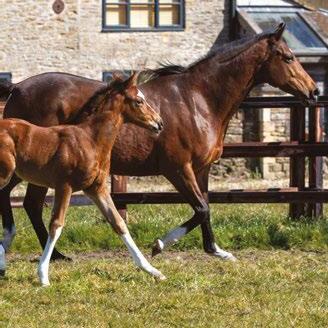

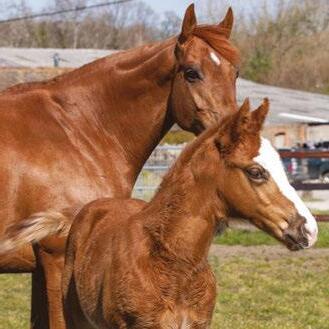
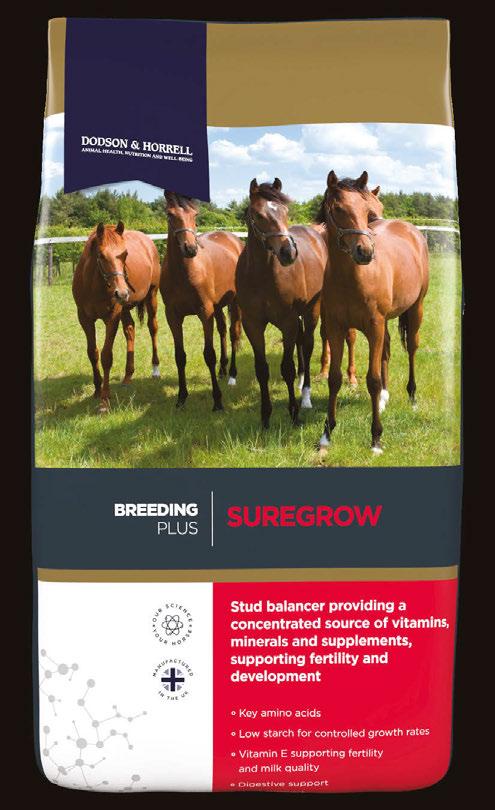
“D&H Suregrow is a central part of our feeding regime for pregnant mares, foals and yearlings. We have fed the product for a number of years and are delighted at how the youngstock look. It delivers optimal growth and development in the youngstock without them getting too heavy. We even use it during sales prep. I would happily recommend it to other breeders.”
For feed advice, please call our helpline team on 01270 782 223 or email helplineenquiries@dodsonandhorrell.com www.dodsonandhorrell.com

The feeding regime will impact on a yearling’s temperament, which is sure to be tested at the sales
have the added benefit of aiding the growth of mane and tail.”
Scott adds: “The minerals calcium, phosphorus, magnesium and trace elements like copper, zinc and manganese are vital for correct bone and soft tissue development. Using a specialist stud feed such as a stud or youngstock-specific cube or muesli is recommended as they will supply the correct balance of vitamins, minerals and protein to achieve healthy growth and development.
“In some cases where forage, especially grass, is particularly good, a quality stud balancer may be all that is required to supply critical nutrients without oversupplying calories. In instances where additional condition is needed, look for a feed with a fibre and higher oil content or add a concentrated high oil conditioning supplement to the diet to help achieve the desired body condition and a showring shine on the coat.”
As touched upon earlier, a valid concern when prepping youngstock for sales is the threat of developmental orthopedic disease (DOD), or growth disturbances resulting from abnormal bone development. The causes of DODs are
complex, with management, genetics and nutrition being up there as three of the main factors. It has been proven that obese yearlings go on to perform substantially less well on the racecourse (Brown-Douglas, C.G., J.D. Pagan, and A.J. Stromberg. 2009. Thoroughbred growth and future racing performance) concluding that there really is no logical
“Increased stabling has been proven to cause bone demineralisation”
reason that youngstock presented for sale in this manner should be desirable. Many pre-trainers will echo this thought; overweight yearlings will take more time to break in and often suffer more injuries and setbacks. There has also been links between high insulin and inadequate cartilage development; this can be controlled by feeding small amounts of starch
per feed as well as adding chromium, which has been found to increase glucose metabolism and in turn reduces insulin and cortisol levels. Of course, genetically predisposed individuals will always carry more of a risk, but with the correct nutrition and management this can be significantly reduced. Also, mineral deficiencies and excesses can be equally detrimental to bone strength, growth and repair.
Increased stabling in youngstock has been proven to cause bone demineralisation (loss of minerals from the bone) and therefore a decrease in bone strength and an increased risk of DODs. The thoroughbred skeleton responds to loading (exercise) by laying down or adding bone (bone mineralisation), which is why turnout is so very important in the early life stages.
Correctly balanced diets can help remove the guesswork from feeding. The type of diet required for sales preparation will be influenced by size, age and individual metabolic variation as well as the forage quality and quantity that’s available. Bulbrook explains: “Some horses may continue to do well on a mainly forage diet with
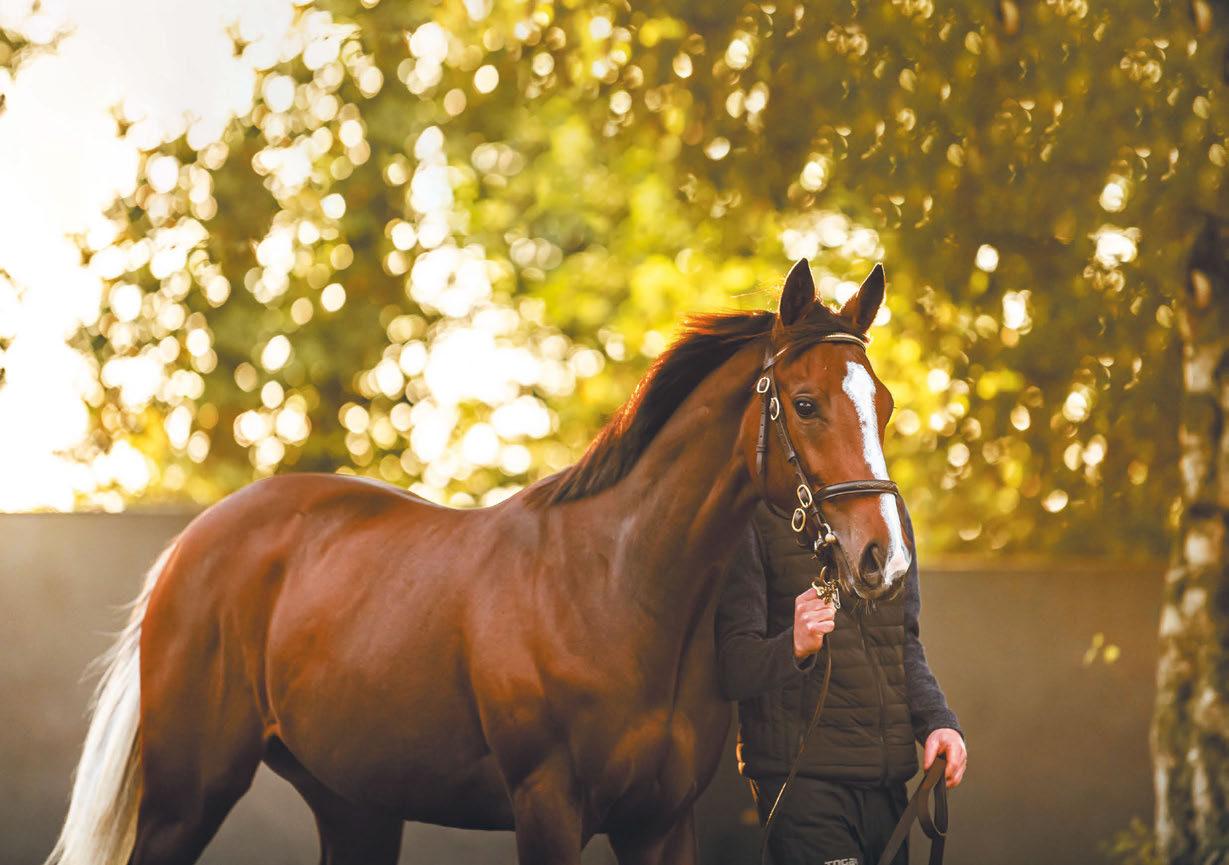
Build topline and muscle defnition this sales prep season
Readily available amino acids to support muscle development in combination with vitamin E for challenged immune systems, and B-vitamins to support appetite and form.
WHEN TO USE:
> In yearlings struggling to build topline
> When sales prep period is shortened or limited
> When appetite decreases with increased workloads
> For horses off-form or struggling to recover from exercise

UK: Adam Johnson T: +44 7860 771063
Ire: Lorraine Fradl T: +353 87 2575398
Email: info@foranequine.com www.foranequine.com

›› a stud balancer for the first few weeks of preparation whereas others will need additional calories whilst still out at pasture. In my experience, compact, heavy-muscled sprinting types generally require fewer calories to hold weight and topline. As a guide, reduce compound feed quantities and replace all, or a proportion, with a specially formulated stud balancer, plus alfalfa chaff and a little oil supplement for coat shine. This ensures protein, vitamin and mineral levels are maintained whilst controlling calories.
“Try to distinguish between fat horses and ‘heavy-middled’ horses. Fat horses need a reduction in calories but losing topline off a heavy-middled horse could create the appearance of a pot belly. Provide soft, leafy, digestible forage to reduce any pot-bellied appearance and take the eye to the top line and general muscle definition. Laidback individuals may benefit from having a combination of instant energy from oats or oat-based stud feeds balanced against the non-heating slower release oil and fibre-based feeds.
“The larger, distance-bred horses are often gawky, underdeveloped types needing muscle and weight to fill their frame. Consider specifically formulated stud/prep feeds combining fibres, oils
and carbohydrates to produce a calorie dense diet. Feed at recommended levels in three to four meals with adlib digestible forage. These horses may need more time during sales preparation. Consider top dressing with a high oil, calorie dense supplement at 0.25 - 1kg per day. This helps to fill horses out across the back and loins
“Every horse is an individual and should be managed as such”
without aggravating temperament through high starch diets, creating a better overall appearance. Backward, underdeveloped yearlings should not be pushed with high- energy rations as this could be a potential nutritional disaster leading to joint problems in some cases. Start these horses on their sales prep diets sooner and work up gradually.
“Highly strung, excitable individuals might benefit from our No 22 Prep Ease
product. With less cereals, more alfalfa, high oil content and lower starch, it provides adequate levels of digestible energy without the risk of aggravating a horse’s temperament.”
In conclusion, providing an optimal and balanced supply of vitamins, minerals and quality protein and ensuring the energy type and intake is correct are all pivotal. This will allow the yearling to maintain manageable behaviour, sustain sound musculoskeletal development, maximise immune health, as well as optimise skin, coat and hoof quality. Every horse is an individual and should be fed and managed as such.
The sales day should not be considered the end point as we have a duty of care for every horse that passes through our hands. Our aim should always be to present yearlings, or any horse, in a physiological and psychological state conducive to a healthy and fulfilling life, which includes not only racing, but also breeding and a second career when the time comes.
Scott concludes: “Overall, successful feeding for the sales ring is not about rapid results but about consistent, balanced care that supports a young horse’s long-term health while allowing them to shine when it counts.”


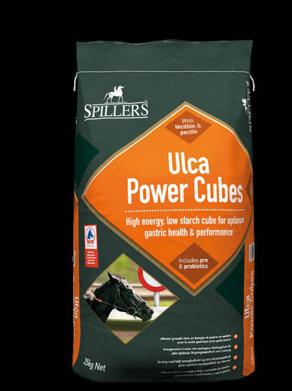


“I



- Rebecca Curtis


OATAALIN mix is designed to give your horse the best performance, energy and shine, as well as contributing to the avoidance of stomach ulcers in horses in training.
OATAALIN mix is designed to give horses the best of whole natural foods in three key grains: the digestibility and energy of Oats, the Calcium & Vitamins and buffer to acidity in Alfalfa.
Linseed aids skin & coat condition and is antiinammatory with slow release energy.
• Superior Rolled Oats from Highclere Estate
• Pelletised Alfalfa
• Micronised Linseed
“At Highclere we have been feeding OATAALIN to our thoroughbreds. Highly palatable, its excellent qualities are reected in the shine of their coats, their energy levels and their relaxed attitudes.”


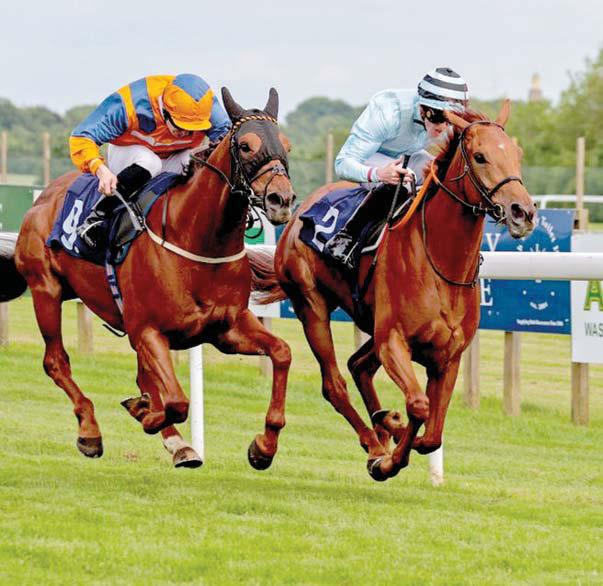

Richard Hannon Jr., Pink Lily’s trainer, commented:
“Pink Lily when she came in she looked great, she has managed to put on all that weight over the winter and looks better than ever. She is a month further ahead than most of mine in her coat and I am looking forward to running her. Very happy with her indeed!”
...Highclere Castle Gin is delighted to be the Premium Gin sponsor at Newbury racecourse in 2025. Highclere Estate premium oats are part of the botanicals making our gin one of the smoothest on the market.



With the change of seasons seeing new horses coming into training, we would like to remind all owners of the benefits of having a training agreement in place. This agreement safeguards both owner and trainer in relation to both the financial commitment of having a horse in training and what an owner can expect from the trainer.
An owner-trainer agreement must set out the terms agreed between the parties in respect of at least the following:
• The basic training fee (expressed as an amount payable by week or by calendar month);
• All other regular expenses (such as gallop fees, shoeing costs and the like);
• The extent of the licensed trainer’s authority to incur any additional charges or expenses for the account of the owner (such as veterinary fees);
• Provision for variation to be made and for proper notification of variation to be made in writing;
• The time and method of payment by the owner;
• Any provision for a trainer’s lien;
• Any matter as to training agreements which is required by a code of conduct issued under the Rules of Racing;
• Such other matters as the Authority may from time to time direct.
The ROA has drawn up a training agreement in liaison with the National Trainers’ Federation (NTF). The British Horseracing Authority (BHA) has
confirmed that the agreement complies with its rules that require that a signed training agreement exists between owner and trainer.
Both the ROA and the NTF recommend members to use the training agreement but this version is not mandatory. An alternative version can be used so long as it contains the minimum requirement as set out by the BHA in the Trainer Code linked to Rules of Racing.
Owners are reminded to read their agreement carefully and make sure the above areas are covered and that they are happy with any terms outlined before signing.
The ROA/NTF agreement can be downloaded from the ROA website on www.roa.co.uk/ta.
In agreement with the Professional Jockeys Association and National Trainers’ Federation, the number of winners a Flat apprentice and jump conditional need to ride before losing their 5lb claim has been extended by ten winners – from 50 to 60 for Flat apprentices and 40 to 50 for jump conditionals – to help further support the development and progression of young jockeys.
This change will apply for Flat apprentices in races on and after Saturday, March 29 and for jump conditionals on and after Thursday, May 1. The revised claim structure will be:
Jockeys’ weight allowances in Flat races
7lb until they have won 20 races 5lb until they have won 60 races 3lb until they have won 95 races
Jockeys’ weight allowances in NH races 10lb until they have won five races if they are a conditional jockey riding for their employing trainer 7lb until they have won 20 races 5lb until they have won 50 races 3lb until they have won 75 races
Any riders who have previously ridden out their 5lb claim but have not won a further ten races since will return to claiming 5lb.
The definition of a two-year-old novice is being amended to better support the overall programme by encouraging more two-year-olds to enter handicap company in the latter stages of the Flat season.
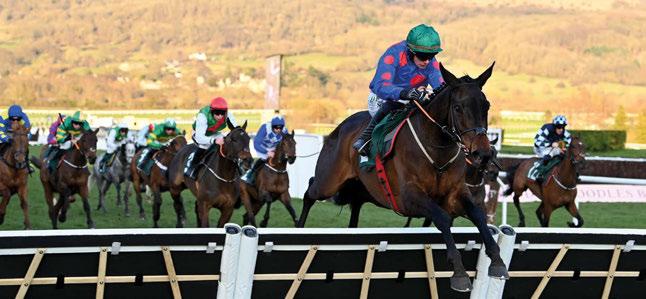
From the start of the 2025 Flat turf season, a two-year-old novice is defined as any horse that has not had more than two completed runs, except if it is yet to win a race under the rules of a recognised racing authority or is a twoyear-old and the race is before July 1. This means that a two-year-old who has completed three or more runs and won a race will no longer be classed as a two-year-old novice from July 1 onwards. These changes came into effect from Saturday, March 29.
Horse Racing Ireland has announced
the introduction of a small number of ‘Academy Hurdle Races’ for the 2025/26 jumps season. These are similar to National Hunt Junior Hurdles in Britain, where the winners of these races are not precluded from competing in novice hurdles the following jump season.
Whilst racing is a passion for owners, when VAT-registered, HMRC considers it to be a business operating under the Racehorse Owners’ Scheme.
What does this mean for VATregistered ownership entities?
If you are setting up a new VAT registration as a sole owner, partnership, syndicate, company, or club, the first step is to complete a D Form and submit it to the BHA VAT desk for authorisation. Without this declaration from the BHA, the entity will not qualify under the Racehorse Owners’ Scheme from HMRC’s perspective.
With most first VAT submissions selected for review by HMRC and a proportion of established VAT registrations chosen for random checks, entities must ensure that sales and purchase invoices match the details held by HMRC. This includes the entity’s trading name, and, in the case of partnerships and syndicates, the names of the partners and members involved.
When registered under the Scheme, as with any business, there will be taxable supplies to declare to HMRC. For
To support the development of young National Hunt stock across both Britain and Ireland, this protection will also be applied to the winners of Academy Races in Ireland, who will therefore be able to compete in British novice hurdles the following season. However, Britain will not reciprocate the maiden status that HRI is offering to its own winners in Ireland.
These changes came into effect from the beginning of the 2025/26 National Hunt season on Sunday, April 27.
In the rare event of a walkover, the remaining horse in the race will no longer need to be ridden across the finish line to be declared the winner. This change is designed to reduce the overall impact of a walkover and remove the additional requirements placed on the sport’s participants.
the purposes of the Scheme, taxable supplies include appearance and prizemoney, sponsorship income, and the sale of a racehorse. To ensure the entity receives VAT on prize-money, the VAT certificate should be lodged with the BHA VAT desk once the VAT number has been issued.
The ROA VAT Solution can take care of all the above, including new VAT registration, first submission checks and beyond. We reclaimed over £1.7 million for our clients between January and March 2025. So, if you need advice, help, or simply want someone else to manage racing VAT on your behalf, call 01183 385 685 or contact vat@roa.co.uk to speak with Davina, Glen or Rebecca.
The British EBF have released details of their 2025 race programme, which sees £2 million contributed to the sport’s prizemoney fund from 35 British stallion studs.
Headlining the Flat racing initiatives is the British EBF two-year-old series, with a total prize fund of £2.3m and two finals worth £100,000 each for fillies (Wednesday, September 24 at Goodwood) and colts and geldings (Friday, October 10 at York). Over 170 restricted maiden and novice races, worth up to £30,000 each, act as qualifiers across the season. Any EBF eligible horse that finishes in the top six of a qualifier can enter one of the finals, with no early closing restrictions and no staged entry fees.
This year, the British EBF has increased its support of high value development races, contributing nearly £400,000 to the programme of races in association with the BHA, Darley, Juddmonte and Tattersalls. There are 88 races for two-year-olds and three-yearolds with minimum values of £40,000 for open maiden and novice races and £30,000 for restricted races. The collaboration seeks to provide owners and trainers with regular development opportunities and secure returns on training fees and the purchase price of a horse earlier in its career.
Since 2015, British EBF have supported the breeding and racing of middle-distance horses through their £250,000 future stayers series. This will continue in 2025 with a series of 12 races

run for no less than £20,000. The races are open to the progeny of sires and dams that ran over ten furlongs or more.
A new initiative this year is the sponsorship of a series of 19 junior hurdle races for National Hunt-bred horses, with over £150,000 on offer across the
The ROA is delighted to welcome Bobby Burns on board as our Head of Business Development. He brings with him a wealth of experience and a strong background in both the tech and sports industries.
Prior to joining the ROA, Bobby worked for five years at bookmaker Fitzdares. It was during this time he developed a deep passion for all things racing.
Before entering the racing industry, Bobby worked in-house for both Amazon and Deliveroo as part of their
respective press office teams.
Bobby will be concentrating on getting out and about, meeting owners both on the racecourse and at events. In the coming weeks we will be publishing his itinerary where owners can meet up with him and discuss all things racing and owning.
We are also delighted to welcome back Steve Hatcher as Head of Finance. Steve will be overseeing the development of our accounting systems and bringing back in-house various threads of the business.
2025/26 season. These races enhance the potential of young horses through earlier jumping education. Racing against their own age-group, the development of this programme aims to mirror the early education options available to National Hunt trainers in France and Ireland.

The ROA and Retraining of Racehorses (RoR) have announced additional support for the welfare of racehorses beyond their racing careers, helping to reinforce the role of owners in supporting the industry’s thoroughbred aftercare strategy.
Owners currently contribute to RoR via a levy on each race entry fee, set at £1.25. While the aspiration is to transition to an annual per-horse contribution model, this approach has not yet been realised. However, in recognition of the importance of maintaining and strengthening racehorse aftercare, an interim solution has been agreed for this year only. From April 1, the owner contribution per race entry will increase to £3, representing an annual average contribution of £26 per horse, an increase from the current £11.
Throughout 2025, the ROA and RoR will work closely to monitor and report on the impact of owner contributions, providing greater transparency and insight into the aftercare programmes owners are supporting.
This period of review will also allow for a broader evaluation of industry cost structures to ensure that financial commitments reflect the needs of today’s owners rather than outdated legacy arrangements.
The ROA acknowledges the financial pressures faced by owners and remains committed to ensuring that investment is directed towards the right areas. The equine welfare strategy is an integral part of responsible racehorse ownership, and this enhanced contribution will directly support the welfare work undertaken by RoR in the aftercare sector. Specifically,
Friday, May 16
Discover Newmarket Tour with racing
Tuesday, June 17 – Saturday, June 21
Hospitality discounts for Royal Ascot
Saturday, June 21 –Friday, June 27
Racing Staff Week
it will help to advance initiatives such as RoR’s First Step Out of Training programme from 2026 and beyond, which provides essential support for horses as they transition into new careers.
Louise Norman, Chief Executive of the ROA, said: “The horse is at the heart of racing and central to the owner experience. Responsible ownership and a lifelong commitment to racehorse welfare are fundamental values for owners in British racing.
“Owners are already the largest financial contributors to British racing, including to RoR, and this increase in support reflects our unwavering dedication to racehorse welfare, particularly aftercare. Together with increased contributions from other industry stakeholders, this funding will enable RoR to continue its vital work, ensuring that every racehorse has the opportunity to thrive beyond the racetrack.”
David Catlow, Managing Director of RoR, added: “RoR recognises the significant efforts made by many owners and trainers to secure suitable homes for their horses after retirement. However, ensuring a successful transition is not always straightforward. This increased support from owners is greatly appreciated and, alongside industry contributions, will enable RoR to strengthen protocols and pathways, giving owners greater confidence that their horses are well-prepared for second careers.
We all share the goal of seeing former racehorses thrive in new disciplines and preventing welfare issues later in life.
Thursday, July 3
Chapel Down wine and dine tour
Tuesday, July 29 –Saturday, August 2
Exclusive access to Richmond
Enclosure tickets at Glorious Goodwood and 10% off selected hospitality packages
Monday, August 4
Racing Welfare Carlisle raceday

RoR remains committed to providing, on behalf of British racing, a robust safety net that the industry can be truly proud of.”
Further details of the Retraining of Racehorses strategy can be found at ror. org.uk.
RoR has announced its selection as Aria Grace Law’s equine charity partner for 2025. As part of this partnership, AGL will donate 5% of its revenues received in 2025 to support RoR’s mission in safeguarding the wellbeing of all former racehorses.
Aria Grace Law CIC, a not-for-profit law firm, offers commercial legal advice to equestrian clients. As part of the partnership, RoR members will gain access to legal resources, including a webinar scheduled for late April 2025 that will focus on purchasing a horse safely. Open to all, it will cover important legal topics related to buying and selling a horse. The webinar will address common legal questions, particularly in areas such as contracts and agreements, purchasing, loaning, and rehoming former racehorses.
Friday, September 5
Racing Welfare Haydock raceday
Sunday, September 7
Racing Welfare Malton Open Day
Friday, September 12
Hospitality package at Doncaster
Friday, October 24
Morgan Motor Tour followed by racing at Cheltenham

When can you be happy to get paid out on a winner at 20-1 when the SP is 33-1? Never, I can hear you say! But that’s exactly what happened to me in this year’s Grand National.
When the weights were announced in February, I made my mind up that Nick Rockett was the likeliest winner. He had recently won the Thyestes Chase and his next intended run was in the recognised Grand National trial, the Bobbyjo. So I placed my ante-post bet. After winning the Bobbyjo, he was clipped in to 8-1 by some layers and all looked good.
But, as the weeks passed, his price started to drift. Some experts couldn’t see him finishing in front of Intense Raffles on over a stone worse terms than in the Bobbyjo. I kept the faith, as in my eyes he had all the hallmarks of what you need in a modern-day National winner. He was a Grade 1 horse, relatively unexposed and being only eight, had the scope for improvement. He was trained by Willie Mullins and had been campaigned like his National horse. I thought, what’s not to like? I was confident he would go off at a single-figure price, so ten
days before the race I backed him again, this time at 16-1.
At the five-day stage he was still 16s but come declaration day I wondered if he had been pulled out, as he wasn’t listed in the first dozen in the betting. I presumed something must be wrong.
Of all Willie’s entries, he was the only one not shortening and I found out subsequently that he touched 66-1 with one online layer. Come the morning of the race, I was looking for any signs of encouragement. None of the national newspaper tipsters went for him; seven of the Racing Post experts were asked to name their first four and not one of them included Nick Rockett! He continued to drift, so I assumed my reasoning was wrong and my previous confidence in him was misplaced. I should have backed him again, but I doubted myself.
The rest is history. The Rockett’s victory reduced Willie to tears, rendering him unable to speak, so overcome with emotion was he after watching son Patrick take the prize. I’m pretty sure any runner with his credentials will never be allowed to go off at such a big price again.
For me, the end of the National meeting signifies it’s time to change codes and concentrate on the Flat.
I’ve recently had the pleasure of visiting the stables of Ed Walker and Andrew Balding to see the two twoyear-olds I have a small interest in. It’s the time for great optimism at Flat yards across the country; as Anna Lisa Balding said during the visit, “All our geese are swans at the moment”. With 250 horses at Kingsclere, Andrew is sure to have some swans and will be a force in lots of big races. I’m hoping to have some good days out watching our Bated Breath colt, Breathe Easy.
I’ve been lucky to have been involved with Ed Walker’s Kingsdown stable since 2020. I’ve made some great friends through my involvement with firstly the Racegoers Club ownership group and now the Kingsdown Racing Club. Tenaya Canyon took us to some great meetings, including Deauville. Tayala wasn’t quite as successful as TC, but she gave me the opportunity to experience Carlisle Bell day and provided a great story. I’m hoping Passing Thought can do likewise.
This month’s exclusive Bid to Give auction package for ROA members in partnership with Racing Welfare includes two stable tours, courtesy of husbandand-wife duo Ross O’Sullivan and former top jockey Katie Walsh.
Step behind the scenes at the stunning County Kildare Greenhills Stables with this private tour for two, where you’ll get an up-close look at the horses on the gallops followed by a traditional Irish breakfast in the home of Ross and Katie. The prize also includes a visit to Katie’s pretraining set-up, from which she has established a reputation as a highly-regarded pinhooker.
After your unforgettable stable tour, indulge in a relaxing dinner for two at the fantastic Club Hotel at Goffs, followed by an overnight stay in their stunning accommodation, complete with a delicious breakfast the next morning.
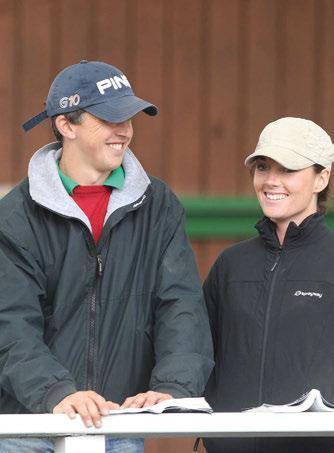
To be in with a chance of securing the lot, go to www.bidtogive.co.uk to place your bid before the closing date of May 24. Dates are to be agreed. All funds raised go towards Racing Welfare’s crucial work in supporting the workforce of British horseracing, right from their recruitment into the industry and through into retirement.

Each year Racing Welfare leads the British horseracing industry’s response to the national campaign Mental Health Awareness Week. Taking place from May 12-18, this year the theme, as set by the Mental Health Foundation, is community.
We’re taking the opportunity to highlight the vital role being part of a supportive, positive community plays in building mental and physical wellbeing, resilience and helping to prevent poor mental health.
This Mental Health Awareness Week, Racing Welfare is encouraging racing’s communities to get together, share experiences and build stronger connections to help nurture good mental health for all. Whether you hold a rounders match, organise a social outing or even just get together for a coffee and a catch up as a group, it’s the start of a conversation.
Racing Welfare will be holding numerous community events and will have a presence at many racecourses throughout the week, building connections with racing’s communities. For further information on this campaign, please go to racingwelfare.co.uk.

The Princess Royal, Racing Welfare’s President, was in attendance
The Racing Welfare Aintree Lunch, supported by the ROA for the third consecutive year, has raised a recordbreaking £95,000 in much-needed funds for the industry’s human welfare charity.
More than 500 people attended the event on the opening day of the Randox Grand National Festival where they enjoyed first-class hospitality and
racing. Her Royal Highness The Princess Royal attended in her capacity as Racing Welfare’s President.
The money raised will go directly towards funding the charity’s essential services, including mental and physical health support, financial assistance, and help with any of life’s challenges.
“We are incredibly grateful to
everyone who attended the lunch and contributed to its success,” said Racing Welfare Chief Executive Dawn Goodfellow. “The generosity shown will make a significant impact on the lives of so many within the racing community who rely on our services. We are especially thankful to The Princess Royal for her continued support.”
Racing Welfare remains committed to enhancing the wellbeing of those working in the racing industry and the funds raised will ensure that the charity can continue its important work.
For more information on Racing Welfare and how to support their important mission, please visit racingwelfare.co.uk or to register your interest for the 2026 renewal of this sell-out event please contact ckingston@racingwelfare.co.uk.

Ian Gosden’s top-class mare Golden Ace won a dramatic renewal of the Champion Hurdle under Lorcan Williams
The saying goes that you should never be afraid of one horse. But what about three horses?
Constitution Hill, State Man and Brighterdaysahead were the formidable trio in this year’s Unibet Champion Hurdle, the highlight on the opening day of the Cheltenham Festival. Taking on these giants would be folly, surely.
Despite trainer Jeremy Scott preferring an alternative target, owner Ian Gosden had no issue in nominating the championship race for his star performer, Golden Ace. She had already given her owner a day to remember when taking the Mares’ Novices’ Hurdle at the 2024 Festival and prepared for this year’s assignment with victory in the Kingwell Hurdle at Wincanton.
The Champion Hurdle was about as incident-packed as any Grade 1 jumps contest in recent memory, with Constitution Hill and State Man, the two previous winners, both falling, the latter at the last when holding a significant advantage, leaving Golden Ace to storm
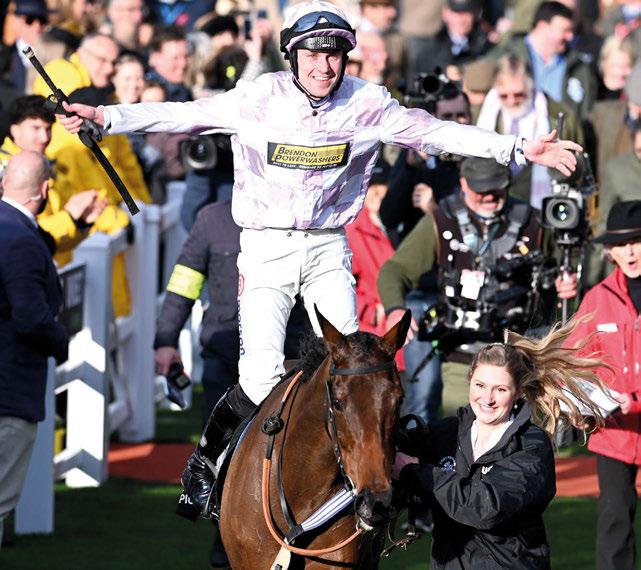
up the hill in splendid isolation and take the prize.
“It was unbelievable that it happened like that,” says Gosden, who admits to having watched the replay “30 or 40
times” since that magical day in March. “We were very lucky it fell the way it did, but we were the ones on form and jumping well on the day.
“Golden Ace thinks on her feet – it
didn’t faze her when Constitution Hill fell in front of her. We can surmise that State Man was emptying when he fell at the last but we’re never going to know.
“It’s impossible to take it all in on the day. I don’t remember the music they played when she came back in as a Grade 1 winner. Even now I don’t think the importance of it has sunk in.
“The Champion Hurdle win is my most magical moment in racing. It doesn’t get any better than that. It’s such a whirlwind on the day – my wife couldn’t get near me after the race! It’s just mayhem and you’re swept along with it.”
Gosden’s wife, Claire, also played her part in the victory; she had produced a spreadsheet of times from likely opponents in the Grade 1 Mares’ Hurdle, Golden Ace’s original Festival target, which showed the daunting challenge that lay ahead. What’s that saying about never being afraid of one horse?
“Lossiemouth’s times were serious,” Gosden explains. “I watched all her races –she never came off the bridle once against a mare. I didn’t want to take her on, so I thought wherever she’s going, we’re not.
“Jade De Grugy also had a higher rating and I reckoned I’d rather come fourth in the Champion Hurdle than third in the Mares’ Hurdle. So that’s where we went!”
Gosden, who sold his insurance broker business, Higos, in 2017, was born in Portsmouth but moved to Somerset in 1989.
He’d had zero involvement in racing until one Christmas when, over a festive drink, some neighbours asked him along to Wincanton on Boxing Day.
“My son was six months old at the time of that first visit,” Gosden relates. “He’ll be 35 this year and I’ve only missed that meeting three times since – two were abandoned and one was called off due to Covid.
“For me it’s about the horses – they’re magnificent animals. I always tend to buy big ones because physique is important for jumpers. The fact that these animals can run and jump for four miles – I just love it! But I’m not into the Flat.”
The Victor Dartnall-trained Russian Trigger, shared with a friend, was Gosden’s first horse and proved a talented stayer, completing a hurdles hat-trick at
Wincanton on Boxing Day in 2007 – “it’s still my favourite day of the year” – and winning the Kent National and Midlands Grand National in 2009.
Golden Ace was sourced for just 12,000 guineas at Tattersalls’ Horses-in-Training Sale in July 2021, when, despite advice to the contrary, he decided to back his own judgement in the ring.
He says: “I buy horses with Wayne Clifford. He gives me a list of horses at the sales – I’m told to stick to that!
“On this occasion, I decided to do my own research and spent hours going through the catalogue. Looking at the pedigrees, I don’t like mares that haven’t run, and I could see the dam [Deuce Again] had won up to 1m6f and the stallion [Golden Horn] had won a Group 1 at a mile and a half. I thought the progeny would stay well.
“The fact that these animals can run and jump for four miles –I just love it”
“When I went into the ring to watch her go through, no-one was bidding, so I thought I’d have a go. When I showed Wayne the slip for transport, he asked me what the hell I had done!
“I didn’t even know her sire had won the Derby. I was just looking at the calibre of the wins rather than the name of the race.”
Golden Ace, who was due to contest the Champion Hurdle at Punchestown at the time of writing, will likely have one more season of racing – “I’d like her to defend her title at Cheltenham” – before retiring to the paddocks.
At present, Gosden has interests in 22 horses, comprising horses in training – Golden Ace is the only one he owns outright – youngstock and three broodmares based at Byerley Stud in Wiltshire. Golden Ace would be a valuable addition to any breeding operation;
her owner is excited by the prospect but admits he is holding his counsel on whether or not to sell her progeny.
He explains: “Stupid money is being charged for point-to-pointers. I don’t understand that thought process. With prize-money the way it is, if you pay three quarters of a million for a horse, you won’t get anywhere near that back. Most of mine have not covered their cost.
“If you get a decent mare then you should be able to breed something that has a serious chance of doing well.”
The state of prize-money in Britain is one of Gosden’s biggest frustrations. Golden Ace’s Champion Hurdle win yielded something of a windfall – first prize was listed as £255,000 – yet away from the headline meetings, returns can be poor.
He says: “I don’t expect my horses to pay for themselves – it’s a hobby and it will cost me money. But I had three seconds at Exeter in one day and my half of the prizemoney was £1,700. That doesn’t even pay for one horse for one month.
“If your success doesn’t give you back half a year’s training costs, you’re not going to be at it for very long. The money I’ve spent in this sport – some people would call it a small fortune. When we say we want ordinary people to get involved, they’ve got no chance. Training costs will be going up again because of the National Insurance changes.
“The second big frustration is owners’ and trainers’ facilities, most of which are rubbish unless you’re going to a top-class track. I often end up paying extra so we can have a table for the day. You don’t want to be in a scenario where you can’t get a seat at the races.”
The major positive about ownership, understandably, is the thrill of big-race success while the camaraderie of the National Hunt scene is another huge draw.
“The social side is important – I have some very good friends who own horses. In the winter I probably go racing three or four times a week,” Gosden says.
He adds: “My dream when I retired was to have a string of racehorses and win a race at the Cheltenham Festival.
“Winning the Champion Hurdle is a once-in-a-lifetime event. If I can breed one that turns out to be really good… that’s my next goal.”
Shared ownership has grown rapidly in recent years and the introduction of syndicate and racing manager licensing by the BHA has established standards to ensure that members of syndicates and racing clubs receive a consistently excellent experience.
Seeing excited syndicate members in the paddock at the Cheltenham Festival and at the Grand National meeting highlights how many more people are getting to experience the thrill of racehorse ownership. Today’s members of syndicates and racing clubs are likely to be tomorrow’s sole owners as more and more people catch the racehorse ownership bug.
The Racehorse Syndicates Association (RSA) represents the interest of commercial syndicators and racing club managers in the UK and for many years has been working in partnership with the ROA and other industry bodies to grow shared ownership and to ensure that syndicate and racing club members receive a great experience both on and off the racecourse.
One of the tools that has been used in recent years to attract new people into shared ownership are racedays focused on shared ownership, where syndicates and racing clubs can engage with racegoers.
Extending this initiative and following on from a successful smaller series in 2024, the RSA has partnered with Jockey Club Racecourses and Great British Racing to put on a series of
fourteen ‘Syndicate Showcase’ fixtures throughout 2025.
These days aim to increase awareness of the opportunities available in shared racehorse ownership by bringing the information directly to racegoers. At each fixture, a dedicated area will showcase a variety of syndicates and racing clubs to racegoers and syndicate and racing club managers will be onhand to answer any questions that they have about shared ownership.
As well as attracting new owners to the sport, shared ownership is also proving popular with sole owners who can diversify their ownership without the full cost of an additional horse or horses.
Most offerings include a share of any prize-money won, visits to the yard and opportunities to go racing as an owner (some will be on a ballot basis), as well as regular communication on plans and progress.
Syndicate Showcase fixtures in 2025:
Tuesday, May 20 – Huntingdon
Thursday, June 26 – Newmarket
Tuesday, July 15 – Nottingham
Friday, July 18 – Haydock
Tuesday, August 12 – Carlisle
Friday, September 12 – Sandown Park
Tuesday, October 14 – Market Rasen
Friday, October 17 – Haydock
Tuesday, October 21 – Exeter


The RSA held their inaugural Syndicate Managers’ Conference at Warwick racecourse earlier this year, where 50 syndicate managers gathered for a series of presentations from industry speakers including the British Horseracing Authority, Jockey Club, Arena Racing Company, ROA and Retraining of Racehorses.
At this event, RSA Chair Dan Abraham announced that the RSA will be working more closely than ever with the ROA during 2025 to integrate the representation of syndicate and racing club members with larger owners. This follows meetings between the two organisations to strengthen their working relationships and the ROA is working towards ensuring that syndicates are better represented at Board level.
A series of workstreams have been identified that will integrate the efforts of the two organisations more closely during 2025 and hopefully we will be reporting on some syndicate success stories in this magazine in the coming months.

The deadline to register your 2024 flly for Stage 2 of GBB is right around the corner. The Stage 2 deadline for 2024 GBB fllies closes on Saturday 31st May.
For every racehorse, retirement is inevitable. What happens next is a responsibility shared by everyone in racing — and at Retraining of Racehorses (RoR), we believe that begins from the very first day a horse enters training.
Every year, around 1,800 racehorses retire from racing in Great Britain. Like people changing jobs, these horses need to learn new skills, adapt to new environments, and often find new homes. RoR exists to help ensure those transitions are smooth, safe and in the best interests of the horse. With over two decades of experience and an expanding network of retraining centres and rehoming partners, RoR leads the industry in aftercare provision.
We are proud to work with a national network of approved charitable centres who not only have the facilities, but also the deep knowledge of the thoroughbred’s needs. These professionals, such as BTRC, Greatwood Charity, HEROS Charity and New Beginnings, ensure each horse is assessed, supported and given the time they need to adapt.
Philippa Gilmore, RoR Head of Welfare Operations, explains: “Retired racehorses are like soldiers adjusting to civilian life – they’ve come from a world of structure and routine. To thrive in their new environment, they need time, stability and patience to adjust and find their footing.”
Alongside our preventative work — including education and guidance for owners of former racehorses — RoR provides a vital welfare safety net for horses in need. In 2024, we supported 66 horses through our welfare programmes, a 22% increase on the previous year.
On average, it costs around £7,500 per horse to deliver the tailored care, veterinary treatment and rehabilitation required, depending on the complexity and length of their retraining.
One of our most important initiatives is our First Step Framework. Funded in 2025 by a £321,000 grant from the Racing Foundation and the John Pearce Foundation, and delivered in partnership with HEROS, the project is designed to build a structured,


industry-aligned framework for horses exiting training. It includes formal assessment of retiring racehorses, a retrainer approval scheme, and the Retraining Assessment Programme, meaning we can signpost owners to a safe pair of hands to transition the horse into their second careers and set the horse up for success in its second career.
But this is bridge funding for just one year. Its long-term sustainability relies on collective industry support.
RoR is funded in large part by you, the owners. Your core contributions
underpin our work, from supporting a horse’s transition to responding when one ends up in a welfare situation at any stage of their lives. This is a shared responsibility. It’s why we urge every owner to plan for retirement from day one.
The cost of retirement is not just financial – it’s also about time, planning, and awareness. But when it’s done right, the rewards are immeasurable.
Just ask Delia Gamble, whose story with her ex-racehorse Terry The Fish highlights the emotional bond that can
RoR has announced an important update to its eligibility criteria, now allowing all thoroughbreds bred for racing worldwide, located in Great Britain, to register with RoR free of charge. This strategic move will significantly enhance traceability across the racing industry in Britain, ensuring that every thoroughbred bred for racing has access to the vital support and education needed.
Previously, RoR’s registration system was limited to former racehorses that had either been in training with a licensed racehorse trainer or had raced under a recognised racing authority, including point-to-pointers. Horses trained or raced outside of Great Britain were assigned NR numbers (not raced), while those that raced in Britain received membership numbers without prefixes.
With the new changes, all thoroughbreds bred for racing, regardless of whether they have been in training, can now register with RoR under a newly created ‘NT’ (not been in training) number. To ensure traceability, these horses will still be required to have an official racing passport, such as a Weatherbys passport registered with the General Stud Book (GSB) or an equivalent international racing authority.
The updated eligibility criteria are as follows:
• Not been in training (NT): thoroughbreds bred for racing but never entered training with a licensed trainer;
• Not raced (NR): thoroughbreds that have been in training but did not race or have raced abroad but not in Great Britain;
• Raced in GB: thoroughbreds that have raced in Great Britain, including point-to-pointers.
David Catlow, Managing Director of RoR, said: “RoR’s expanded eligibility to register with RoR underscores our continued commitment to safeguarding the wellbeing of all former racehorses, including thoroughbreds bred for racing as outlined in the RoR Strategy 2024-2026. This ensures they receive the necessary support to lead a wellsupported life beyond racing.”
By opening up registration to all thoroughbreds bred for racing, RoR aims to improve traceability in the industry. This expansion will allow RoR to track and support horses
flourish when the right foundations are laid. Rehomed through one of RoR’s retrainers, Terry is now thriving in a new life with Delia – a “horse of a lifetime”, she says.
Your support helps us ensure every horse has that chance. With the right systems in place, industry-aligned frameworks, and funding to match our ambition, we can make racing aftercare in Great Britain world-leading. Because every horse deserves a future worth racing for.
To find out more or to donate, visit support.ror.org.uk.
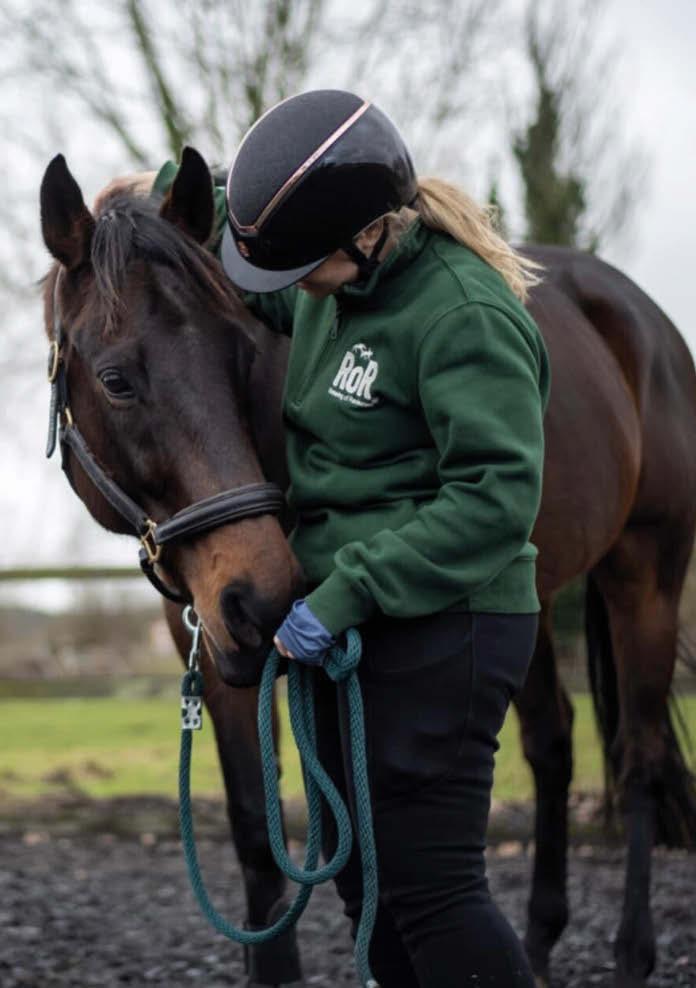
at every stage of their lives, helping to ensure that no horse is lost in the system, and all have access to the necessary welfare programmes when needed.
In conjunction with this eligibility change, RoR is also enhancing its educational offerings. All thoroughbreds now registered with RoR will have access to a range of educational programmes including camps, clinics, and events. These initiatives are designed to assist horses in transitioning to second careers, offering valuable opportunities for owners to foster lasting partnerships between horse and rider.
The TBA recently held a lunch for Professor Sidney Ricketts at the Jockey Club Rooms to celebrate 47 years of service on the Veterinary Committee – an unprecedented term of office for a committee member at the TBA.
Sidney is an internationally renowned veterinary surgeon and friend to many in the thoroughbred industry, having dedicated his career to advancing breeding practices, gaining RCVS recognised status in equine stud medicine in 1991 and a diploma from the European College of Equine Internal Medicine in 2002.
In 1998, Sidney was made Lieutenant of the Royal Victorian Order by the late HM Queen Elizabeth II for services to
the Royal Studs. Sidney was presented with the TBA’s Dominion Award in 2013, which acknowledges the achievements of someone employed within the thoroughbred sector who has made a significant contribution to the British breeding industry.
The TBA has been extremely fortunate to benefit from Sidney’s extensive knowledge and expertise as a valued committee member and a veterinary consultant to the association. Sidney’s leadership during the CEM and equine influenza outbreaks helped the thoroughbred sector navigate the considerable challenges those diseases brought to Britain. Sidney was instrumental in the formation of the HBLB International Codes of Practice and is still involved with
The TBA is pleased to welcome Molly Bryan to the team as Digital Marketing Executive. A graduate of the BHA’s Development Programme, Molly joins the TBA from Sky Sports Racing where she was Media Executive. In her new role Molly will be developing content on the TBA’s social media channels, membership communications and working to promote the TBA’s membership services and events.
Commenting on her new role, Molly said: “I’m excited to be at the TBA and I am looking forward to getting involved in lots of different projects and getting to know the members.
“I’m passionate about social media and I can’t wait to continue our growth on these platforms which I hope brings our organisation to a new audience. I hope I can bring a fresh perspective to

the role, and I can’t wait to play a small part in championing the future of the thoroughbred.”

the annual review process and updates.
The TBA is enormously grateful for all that Sidney has and continues to contribute to the TBA and the British breeding community.
The deadline to register 2024-born fillies for Stage 2 of the Great British Bonus (GBB) is fast approaching –ensure your registration is complete by midnight on May 31.
The registration fee is £275 per filly, with no discounts available. If you’ve purchased a filly, it is essential to register a change of ownership with Weatherbys – this includes returning the passport. Failure to do so will result in bonuses being paid out incorrectly in the future. Please note, ownership changes cannot be processed without the passport being returned.
Register now online at www.greatbritishbonus.co.uk or contact the Weatherbys Stud Book on 01933 304808.
There is limited time remaining to nominate for the 2025 TBA Stud Employee Award, sponsored by Peter Stanley’s New England Stud.
The winner will receive a £2,000 cash prize and perpetual trophy which will be presented at the TBA Flat Breeders’ Awards evening. The remaining five shortlisted nominees will each receive £250 and a certificate of recognition.
Nominations are encouraged for those who have made a
positive impact on the workplace, whether that be a willingness to motivate others and take on new responsibilities or exceptional performance in their day-to-day role.
The deadline for nominations is Monday, May 12. For details on how to nominate and the terms and conditions please visit the TBA website. Nominations can be made by an employer, colleague, or client through the online form, or by downloading a paper copy from the TBA website.

Nick Luck will host the event in Doncaster on May 19
With the British NH season having concluded at Sandown Park at the end of April, join us in celebrating the best of British at the TBA’s NH Breeders’ Awards Evening, sponsored by Goffs. Taking place in the Hilton Garden Inn, Doncaster, on Monday, May 19, from 7.30pm, the evening comprises a Champagne reception, followed by dinner and the awards ceremony, which is again hosted by Nick Luck.
Tickets are priced at £75 per person and can be purchased via the events page of the TBA website.
Breeders, owners, trainers and enthusiasts are encouraged to attend and celebrate at an evening where the passion and success of British NH breeders is celebrated and acknowledged.
The TBA is pleased to announce the return of its popular regional days. While a few events are still in the planning phase, we are excited to share some details on those on the horizon so members can begin planning.
These days are a great opportunity to reconnect with other TBA members across our regions, so keep an eye out for more updates as plans come together!
North – September
Former NH jockey David O’Meara is based at the 120-acre Willow Farm in the picturesque village of Upper
Helmsley, just outside York. Willow Farm is home to one of the UK’s most progressive and ambitious horseracing operations.
Since launching his training career in 2010, O’Meara has built an exceptional reputation, earning respect across the racing community, and 2025 looks like being another great year for the team.
South-east – September 21
Having recently completed a stable move to Downs House Racing Stables, just a stone’s throw away from Epsom racecourse, George Baker is opening his doors in the morning, offering
TBA full members can now access a 15% discount on Randox Health in clinic and at-home tests. Designed to understand, track, and improve your health data with one of their blood tests, each of Randox’s personalised health checks will deliver insights into current health and potential health risks to help protect future health.
Health tests are mainly blood and urine-based, with a 20-minute consultation included at the start and results supplied digitally with a further 30-minute consultation online. There are a number of testing options available, with the most popular being the Insight Health Assessment (Everywoman/ Everyman) which includes:
• 150 markers measured linked to key health areas
• 20-minute appointment for blood and urine sample
• Personalised health plan detailing results and next steps
• Electronic results report twofive working days
• Health and wellbeing discussion
• Optional GP appointment
To access the discount code, members can log into the TBA website and visit the ‘offers’ page within the ‘Advice & Info’ section to redeem or contact Stanstead House directly.
members the chance to meet some of his stable stars along with a trip to the gallops to watch his string in action.
Chasemore Farm needs little introduction; set in 340 acres of rolling grassland designed to nurture future champions, the story began in 2007 when Andrew and Jane Black set out to create a modern stud farm that honoured the finest traditions of the sport. Four years and a lot of hard work later, the first horses arrived in 2011, marking the beginning of what would become one of the UK’s most respected commercial breeding operations.
Prestbury Park is the centre of attention in mid-March and the fourday Cheltenham Festival witnessed three British-bred winners, all in Grade 1 contests, two of which were sired by the Overbury Stud resident Golden Horn.
The opening day highlight, the Champion Hurdle, was won by the Meon Valley Stud-bred Golden Ace. The previous month’s Kingwell Hurdle winner was left in front at the last and powered up the famous hill for a nine-length win and second successive Festival triumph, having captured the Dawn Run Mares’ Novices’ Hurdle the previous year.
The following day and the opener, the Baring Bingham Novices’ Hurdle, was an anticipated affair, won in good style by the Little Lodge Stud-bred The New Lion on his first time running for JP McManus. The son of Kayf Tara, who had won the Challow on his previous start, travelled well and found plenty when required.
The Golden Horn double was brought up by Poniros, who was making his hurdling debut, in the Triumph Hurdle. A smart Flat performer, the Wilgerbosdrift (UK) Ltd-bred gelding was smuggled into the race by Jonjo O’Neill Jnr and pounced late in the day to win at odds of 100-1.
The BEBF-sponsored Listed mares’ bumper at Sandown Park the weekend before Cheltenham went to Charisma Cat, who stayed on best to avenge her Listed defeat at Market Rasen in January. The daughter of Nathaniel, who had won the TBA-sponsored mares’ bumper at Warwick in November, is a homebred of Robert Waley-Cohen’s and is out of the Grade
Monday, May 19
NH Awards Evening, Hilton Garden Inn, Doncaster
Join us in celebrating the best of British-breds from the 24/25 NH season, which is held on the evening of this year’s Goffs Spring Store Sale. Tickets are on sale now and can be bought from the events section of the TBA website.
Wednesday, July 9
Flat Awards Evening, Chippenham Park, nr Newmarket
Celebrate the success of all Flat breeders from the 2024 season in the

1-winning mare Tidara Angel.
In addition to breeding Golden Ace, Meon Valley Stud saw its Grade 2 bumper winner Familiar Dreams, a daughter of Postponed, gain a first Graded win over obstacles in the EBF Shannon Spray Mares’ Novice Hurdle at Limerick. At the track’s next meeting, the four-year-old filly Light Up The Dark won the Listed Champion Flat Race. She was bred by Michelle Morris.
The Wertheimer brothers-bred Frankel gelding Gaucher came home victorious in the Grade 3 Kingsfurze Novice Hurdle at Naas, making nearly all and winning by over eight lengths. Across the Channel at Auteuil, the Katarina Jacobson-bred Nyiri followed up his Grade 3 Cagnes-sur-Mer win with victory in the Listed Prix Hubert d’Aillieres at Auteuil.
March proved a good month for Al Asayl, the operation of Sheikh Sultan Bin Khalifa Al Nayhan, with two progeny of
the operation’s Prix Vermeille-winning Dubawi mare Bateel winning stakes events in France. Map Of Stars, a Listed winner for the operation before being sold privately to Wathnan, made a successful seasonal return in Europe’s first Group race of the year on turf, the Group 3 Prix Exbury at Saint-Cloud.
The double for Bateel was brought up back at Saint-Cloud a couple of weeks later when Tajlina captured the Prix Penelope. A wide-margin Chantilly maiden winner last term, the daughter of Kingman made her challenge over a furlong out and ran on strongly for the win.
At a sun-drenched Leopardstown, the Juddmonte homebred Swelter, a daughter of Kingman, won the Group 3 Priory Belle Stakes. Another Kingman to score in stakes company was fellow three-yearold Flaming Stone, winner of the Prix la Camargo at Saint-Cloud. She was bred by Anita Wigan and Juddmonte.
There was a Listed win for the Newsells Park-bred Sunchart in the Devoy Stakes at Naas.
stunning surroundings of Chippenham Park on the evening before Newmarket’s July Festival kicks off.
Monday, September 1
AGM
The 108th Annual General Meeting of the Thoroughbred Breeders’ Association will be held at the Jockey Club Rooms, Newmarket, CB8 8JL. Further details to be released. For more information regarding events, as well as to see when regional events have been fixed, either contact the office or check out the regular e-bulletin emails.
Bought out of the Tattersalls December Sale, the Kirsten Rausing-bred Alalcance made hay in the Australian autumn, capturing the Group 3 Manion Cup at Rosehill having already won the Listed Randwick City Stakes earlier in the season.
In the UAE, the St Albans Bloodstockbred Silver Knott added another Group win to his CV with victory in the Dubai City of Gold on Super Saturday.
The following week and the Shadwell Estate-bred Marbaan took the Group 3 Ras Al Khor at Meydan. The same day but over in Bahrain, Sovereign Spirit won the Group 3 HM The King’s Cup while the Cheveley Park Stud-bred Goemon landed the Listed Al Methaq Mile.
Results up to and including March 31.

Meon Valley Stud’s black and white spotted silks are instantly recognisable among the ranks of great British ownerbreeders, seen at the highest level by the likes of Milligram, Zee Zee Top and One So Wonderful.
As the Hampshire farm set out to produce middle-distance and Classic prospects from the time it was developed in 1980, it is no great surprise that once in a while a National Hunt horse will emerge instead.
During March, Meon Valley reached even greater heights in that department as Golden Ace claimed one of the most dramatic renewals of the Champion Hurdle in recent memory.
Another graduate from the stud, Familiar Dreams, burnished her promising career in the Grade 3 Irish Stallion Farms EBF Shannon Spray Mares Novice Hurdle at Limerick during the same week, making the winner of the TBA Breeder of the Month an obvious choice.
“We’re very flattered to be nominated,” says Mark Weinfeld, Meon Valley’s managing partner.
“Even if by accident rather than design, a Champion Hurdle winner is still something to be very proud of.”
While neither winner was expected in the betting, each had already shown plenty of good winning form already.
“I’m not sure we’ve had two Graded wins in a month before but the same two mares did win stakes races last year,” Weinfeld explains.
“Familiar Dreams won a Listed Irish National Hunt Flat Race at the end of March and then a Grade 3 at Punchestown in early May, and then of course Golden Ace won the Grade 2 Dawn Run Mares’ Novices’ Hurdle at Cheltenham last year, beating Brighterdaysahead by nearly two lengths.
“Then she also won the Listed mares’ novices’ hurdle at the Cheltenham April meeting. So that was a pretty exciting year as well, but not as special as this year.”
Golden Ace, a daughter of Golden Horn, is the second foal out of Dubawi mare Deuce Again, who raced for John Gosden and won Nottingham’s Listed Further Flight Stakes in 2015 before finishing third in the Group 3 Ormonde Stakes at Chester.
Now seven, Golden Ace was also originally in training at the same stable before being bought by her unrelated owner,
Ian Gosden, for 12,000gns at the Tattersalls July Sale in 2021.
“She is the great-great granddaughter of our foundation mare Home And Away, who was purchased as a yearling by my father in 1978,” says Weinfeld.
“This family has produced some very good horses including San Sebastian [won Prix du Cadran], Noushkey [Lancashire Oaks], Chesa Plana [Listed winner in Germany] and Alkaased [Japan Cup].”
Golden Ace has spent all of her racing career with Jeremy Scott and had warmed up for Cheltenham with a win in the Grade 2 Kingwell Hurdle at Wincanton.
Sent off at 25-1, she had to nearly dodge a falling Constitution Hill at the fourth last before building her momentum under Lorcan Williams. Golden Ace was the one to take advantage when State Man also came down at the final flight and she stormed up the hill to glory by nine lengths.
Weinfeld was among the international audience sharing in the drama.
“It was heart-in-mouth and disbelief, particularly when just missing Constitution Hill after he had fallen,” he says. “What a tough mare she has turned out to be.”
Meon Valley has sold a few of Deuce Again’s offspring onwards and the 14-year-old should have plenty more to come, with Weinfeld adding: “She has a Teofilo yearling colt but was unfortunately barren to Cracksman last year. We have sent the mare back to Golden Horn.”
It will not escape pedigree anoraks’ attentions that the stud has had another profound impact on the National Hunt scene. It bred the late Overbury great Kayf Tara, who was sold at the Tattersalls Houghton Sale in 1995 and twice landed the Gold Cup at Royal Ascot.
Along with the likes of Thistlecrack and Special Tiara, Kayf Tara is the sire of one of the most exciting young prospects in the Dan Skelton-trained The New Lion, a fine winner of the Turners Novices’ Hurdle at this year’s Cheltenham meeting.
Familiar Dreams descends from the line of another of the four foundation mares, One In A Million, which includes the brilliant miler Milligram and continues to flourish.
“It always gives us great pleasure to see horses we have sold go on to do well,” says Weinfeld, who can head into the main business of the Flat season full of enthusiasm.

It is a beautiful spring evening in late March and Owenstown Stud, a farm that has bred some serious horses, looks stunning, writes Peter O’Reilly. The more senior among us will recall names such as Indian Ridge and Humble Duty, whilst more recent additions to the outfit’s illustrious rollcall include Art Power and Creative Force. However, as befits the modesty of the current owner of the stud, John Tuthill, there are no brass plates on stable doors or similar trumpeting these great equine athletes of the past.
The farm is rich in thoroughbred history, with John having inherited it on the passing of his aunt, the well-known Avril Whitehead, in 2010. Avril was an extremely knowledgeable and successful breeder, following on from her uncle Frank who first purchased the property just over 100 years ago. John is thus continuing a fine family tradition and as he puts it, he is simply the “current custodian” looking after the 270 lush acres just outside Maynooth. When asked why the farm is so successful, he muses that these acres are very much key to it.
The rich Kildare land that has turned out so many good horses has proven to be the bedrock literally on which the stud has built its stellar reputation. Coupled with this is John’s refreshing and admirable old-fashioned approach –something that should be viewed firmly in a complimentary tone rather than a

derogatory one. This approach has seen John, an expert on composting who advises many stud farms and other bodies both in Ireland and the UK, make only small adjustments to the way the farm has been run since the early 20th century. Stocking rates are low, and the emphasis is very much on working with nature, with no bagged fertiliser touching its soil in over 40 years. As John succinctly puts it: “We are doing it the old way because it seemed to work the old way”.
Currently, John and his family – he’s ably assisted by wife Clare and son Chris, with daughter Pippa on the King Power team – have 12 mares of their own and keep many more for a range of Irish and international clients. Indeed, the globetrotting phenomenon that was Gordon Lord Byron was foaled and
Patience
Sprinting and speed
Speed and precocity can be muddled. For a stallion to make it, he has to produce two-year-old winners and the first-season sire hype is unrelenting. Yet true sprinters win at six, seven and eight years of age… when was the last Olympic 100-metre gold medal won by an 18-year-old?
Prize-money
We have lost a good few potential stallions, as they have been gelded and sold abroad to race in the likes of Australia, Hong Kong and the US. This is all a by-product of low prize-money and pretty much any problem in the industry can be traced back to prize-money.
A lot of the [people in the] market who buy a horse don’t want to wait till it is three or four years old to get the good out of it.
Human rather than equine conformation
No-one ever told Creative Force he was a small horse, and he rode much bigger. However, it is very stressful for breeders that all the buyers with big budgets seem to be over six foot tall and it’s a leap of faith for a big man to buy a small horse. Where are all the ex-jockeys with big pockets when you need them?
Thoroughbred horses
Thoroughbreds are incredibly forgiving and need to be out as much as possible.
reared in Owenstown for a Swiss client. Coincidentally, the trips the good Lord favoured, from six furlongs to a mile – he won the Group 1 Betfred Sprint Cup and Group 3 Desmond Stakes – are the meat and drink of John’s own breeding empire, as he tends to breed runners that excel up to a mile.
Owenstown’s equine Usain Bolts were Art Power and Creative Force, while their Seb Coes or Ronnie Delaneys were Persuasive and Excelebration. Like all breeding success, it was not achieved overnight, as John’s prowess is based on long years of experience. Whilst respectful of modern breeding techniques and genetic research, he is of the school that what you learn from the latter, you can probably see in the pedigree and from looking at the individual. Moreover, if science were ever to dictate breeding, it would be a sad day, or as John puts it: “If you take away the chance of a small breeder getting something nice, if we completely unravel that dream, then we would be in a much poorer place.”
As the sun gets lower in the sky, the business of impending foaling intervenes and it’s time to leave Owenstown. As I head down the tree-lined avenue, John’s answer to my question on what advice he would give to someone starting off in the industry – “pick someone you would trust to give you good advice” – resonates in my head. I think I have found my man.
They need plenty of space and group size needs to be small. If a horse is in a group, it has to know where they rank in the group and who is top of the pecking order. If it is in a group of seven or eight, it doesn’t have to look too far but if the group is up in the teens, it’s a different story.
Staffing
The difficulty nowadays is we are losing people who are prepared to start at the bottom and work their way up. People used to look to Ireland for their staff but now Ireland is looking abroad for theirs and that is worrying.
One to look out for
The colt foal by Lope De Vega ex Penny Pepper is very nice.


Total print readership exceeds 20,000 per month – Europe’s most widely read monthly horseracing magazine A proven, tried and trusted publication with advertising packages available from just £305 per month







Graham
Dench asks our jury the big questions:
As the home of the world’s greatest Flat race, how would you like to see Epsom reinvigorated as a racecourse and training centre?
“

To people of my generation the Derby will always be the most famous race in the world, but as horseracing has modernised there are now many extremely valuable targets internationally and we have to keep that in perspective. I’m not sure we can ever go back to the heady days of the 1950s and ’60s, especially while in terms of it being a race that creates future stallions
Switching from yearling entry for the Derby to the spring of a three-year-old’s career, and also the ‘win and you’re in’ races, have been positives. It would be good to find a way of making the Oaks and Coronation Cup more attractive to international runners, but that’s a tough one as the course is so unconventional.
In my lifetime the Derby meeting has gone from four days to three and now two. There’s been talk about creating more of a festival around it, but I think spreading it out over a week would be a difficult sell.
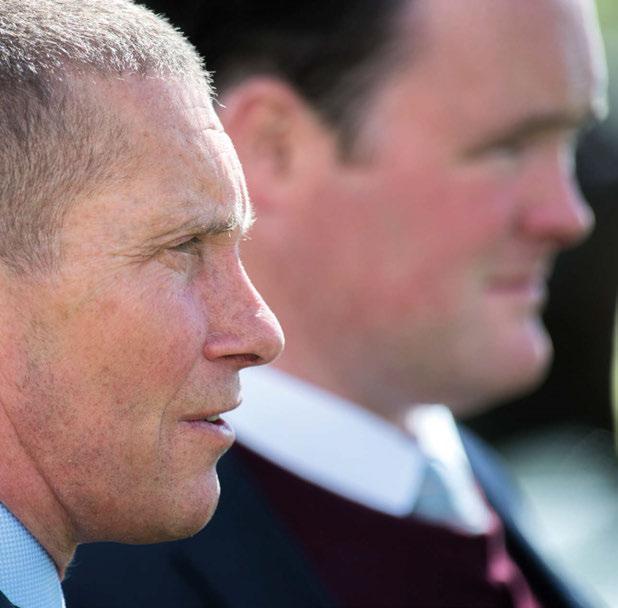
Andrew Black
Co-founder of Betfair and owner of Epsom’s nearneighbour Chasemore Farm
“
Epsom is clearly on the up thanks to a groundswell of investment – South Hatch and Downs House combined with welcome investment from the Jockey Club – but more is required.
The gallops and walkways need further work, and more needs to be done to segregate the working horses from the general public, in particular those with badly behaved dogs. Newmarket feels like a dedicated training space where the general public have learnt to accept the fact that the horse comes first; Epsom just feels like common land and given the town’s history, more could be done to create safer and better spaces to train
young horses.
Epsom has a strong sense of identity and community and I’ve thought for a long time that a racing club could work well. There’s no shortage of quality trainers, skilled staff and work riders in Epsom, but there are few top-class horses; a club yields better economics for owners and potentially could contribute to a rise in the class of horse trained there. If the racecourse got behind it and maybe created a dedicated bar for club members then all the better – I like the idea of ownership clubs supported by racecourses, the more so in areas where there is already a strong historic racing community.
So far as any criticism of the rest of Epsom’s programme is concerned, there’s an awful lot of moderate racing too at tracks like Sandown and Newbury – that’s because the product has been diluted so much that the vast majority of horses nowadays are rated 75 and under.
In my time here I’ve seen significant shrinkage of the quantity and the calibre of horses trained in Epsom, but George Baker bringing 50 horses to what is now one of the finest training establishments in England has been a very significant boost.
As far as the gallops are concerned, the recent investment made by the Jockey Club is greater than I’ve ever seen in my 40-odd years here. There’s no escaping that the Downs gets huge footfall, but we’ve got two brand new training surfaces and there are new white railings everywhere for safety. As a training community we are all appreciative of that,


Philip Mitchell Former Epsom trainer
You are never going to change the racecourse, the idiosyncrasies of which have made it the ultimate test for the thoroughbred for more than 200 years, but apart from the two days of the Derby meeting and to a lesser extent the spring meeting, the racing at Epsom is humdrum. Attendance is sparse and it feels as if they repeat the same races year after year, contested by the same horses until they are too old to run. The programme could do with some of the incentives and imagination you might see on the all-weather or in the Sunday Series.
I’ve always been passionate about Epsom as a training centre, but sadly it’s not the force it once was. The gallops were fantastic in my day, and I trained Running Stag to win more than £1m on them. I wouldn’t have wished to have trained anywhere else, but the access that the public is allowed by law is an issue with
Local resident and co-owner with wife Jolene of Epsom-trained Group 1 winner Live In The Dream
“
I was brought up in Epsom and I remember the old days when the meeting was over three or four days, with the Derby on Wednesday, the Coronation Cup on Thursday, some top-class handicaps on Friday, and then the Oaks as the centrepiece on Saturday. I can remember walking up to the track for the 200th Derby. I’ve never seen so many people in one place before, but it wasn’t pleasant. In those days I think they only held three meetings a year, with the Derby meeting sandwiched between the Spring and August Bank Holiday meetings, but they no doubt had their reasons for moving the race to a Saturday, and these are different times, especially after Covid.
I know Epsom is a very different sort of town to Lambourn or Newmarket, where everything revolves around racing or breeding, but perhaps they could do a bit more to raise awareness about the racecourse and promoting the Derby itself among local people. We were lucky enough to go to a Breeders’ Cup with Live In The Dream, and they do these things on another level there. We maybe don’t want quite that kind of razzmatazz, but there are some great people at the helm at Epsom and they have a fantastic product to sell, with the most amazing history. The Derby is still the brilliant race that it always has been, and it’s such a unique racecourse it would be good to see them stage the full quota of meetings that they are licensed for.
As for Epsom as a training centre, it has some very talented trainers and Live In The Dream winning the Nunthorpe and Harbour Law the St Leger show that it’s perfectly possible to train Group 1 winners of all types there. I can only think that the main reason that they are the only Group 1 winners to come out of the thousands trained there in the last 20 years or so is down to the quality of the raw material they get. Hopefully that will start to change, as George Baker and Jim Boyle in particular have fantastic facilities and are very well placed to give owners a great experience.
regard to wear and tear and safety.
I can remember when Epsom had 25 or more trainers, including some of the biggest names in the sport, and they were not just all over the Downs but also practically in the town centre. Unfortunately, land in the area is now so valuable that as soon as premises become available, they are snapped up by developers. Even in my day there were still at least ten stables in Langley Vale alone, but now it’s all housing.
On the positive side, I’ve been to George Baker’s new base at Downs House, which is next to the Derby start and where my father and I both trained, and what they’ve done there is spectacular. I understand the redevelopment at Jim Boyle’s is quite superb too, and I take my hat off to him. Epsom has been a lifelong passion of mine and I wish them both the very best, as I do the others still training there.





£50M

racecourses

global totes betting into one pool 20+




£100K+

racing staff



£50K


World Pool Jockeys’ Championship charity prize

racecourses in UK & Ireland 9 pools in 2024
£455M






























































































































































































































































20 G1 wins in some of the world’s most famous races: all in the past five years, all by Darley stallions and all conceived off May or June covers.
